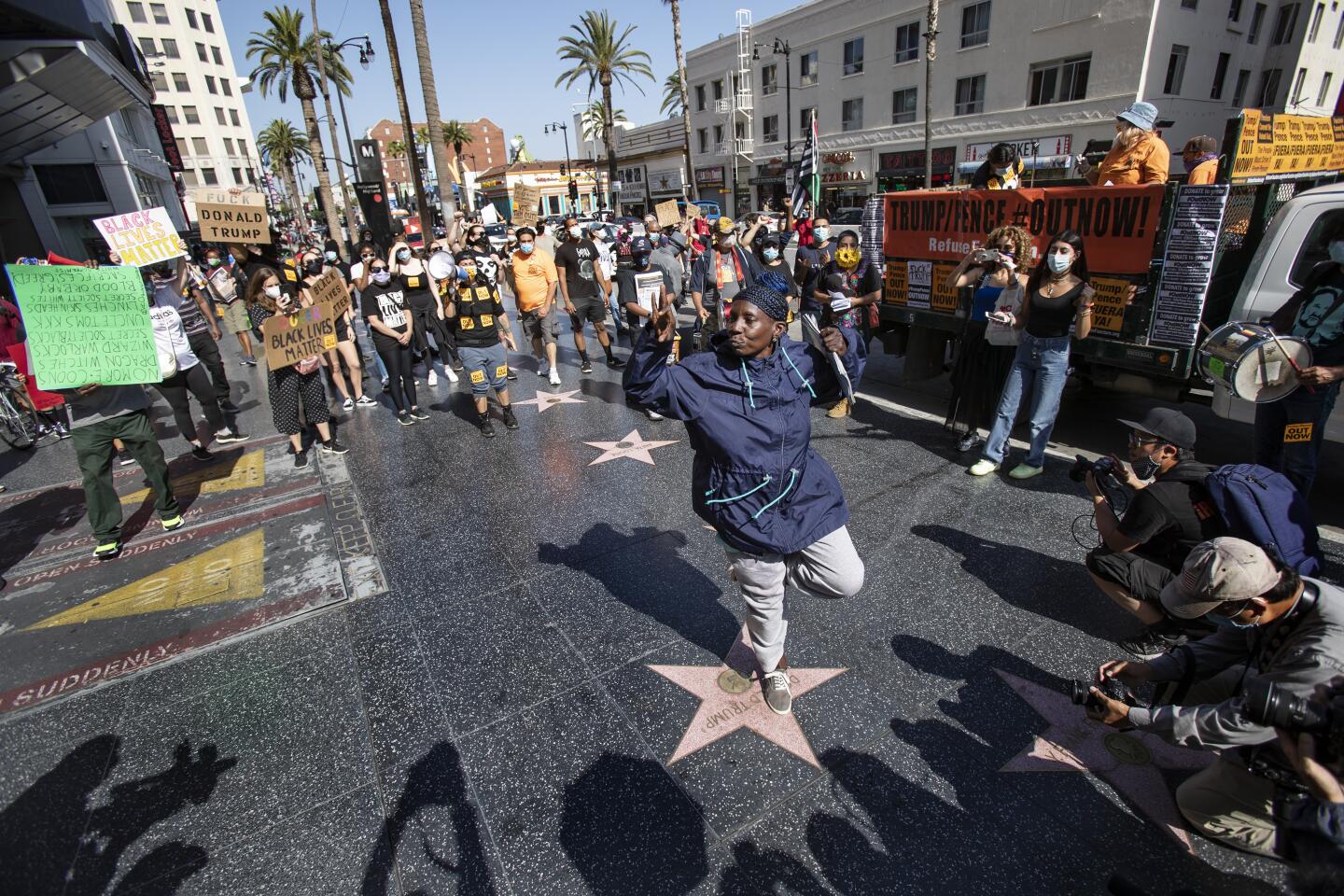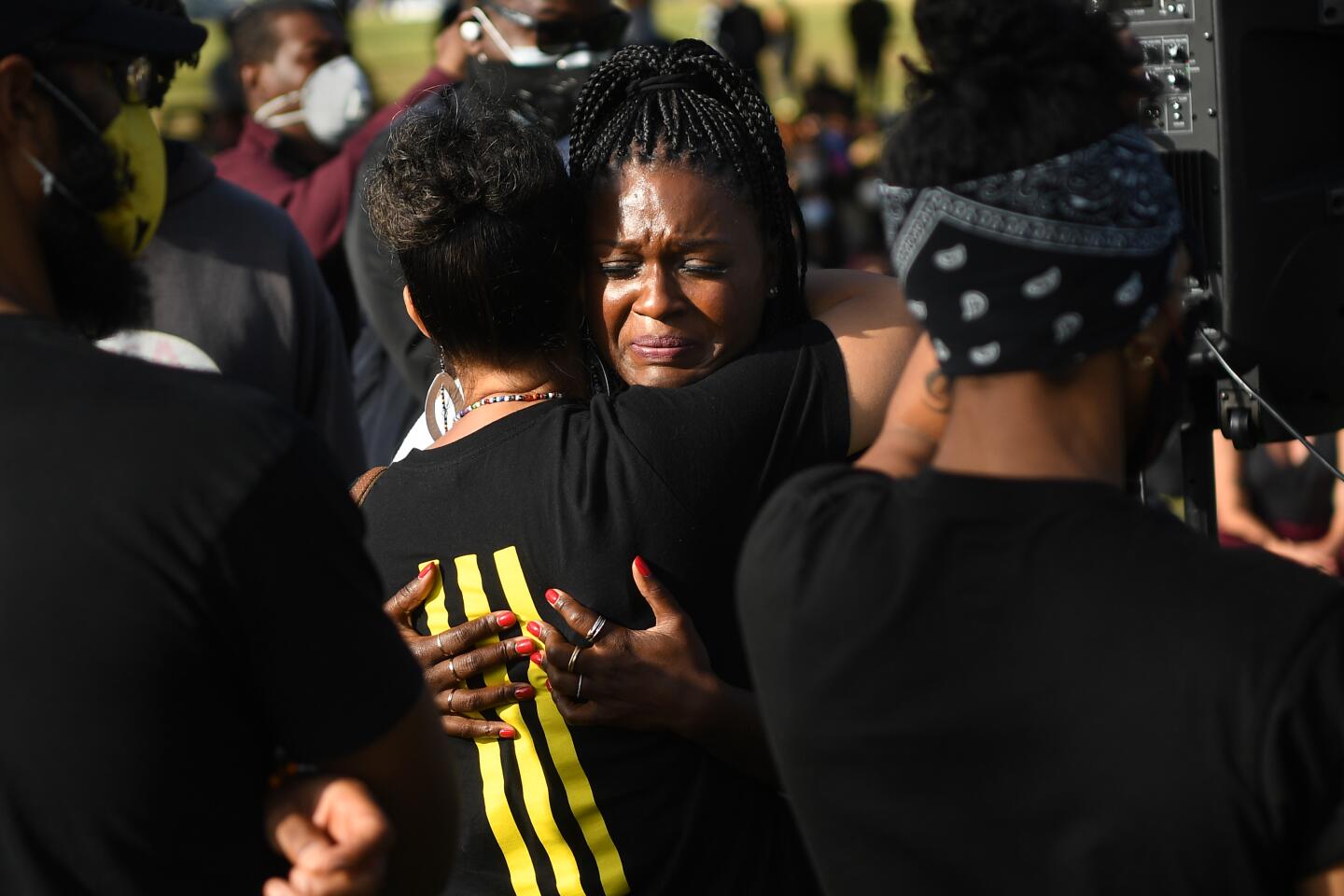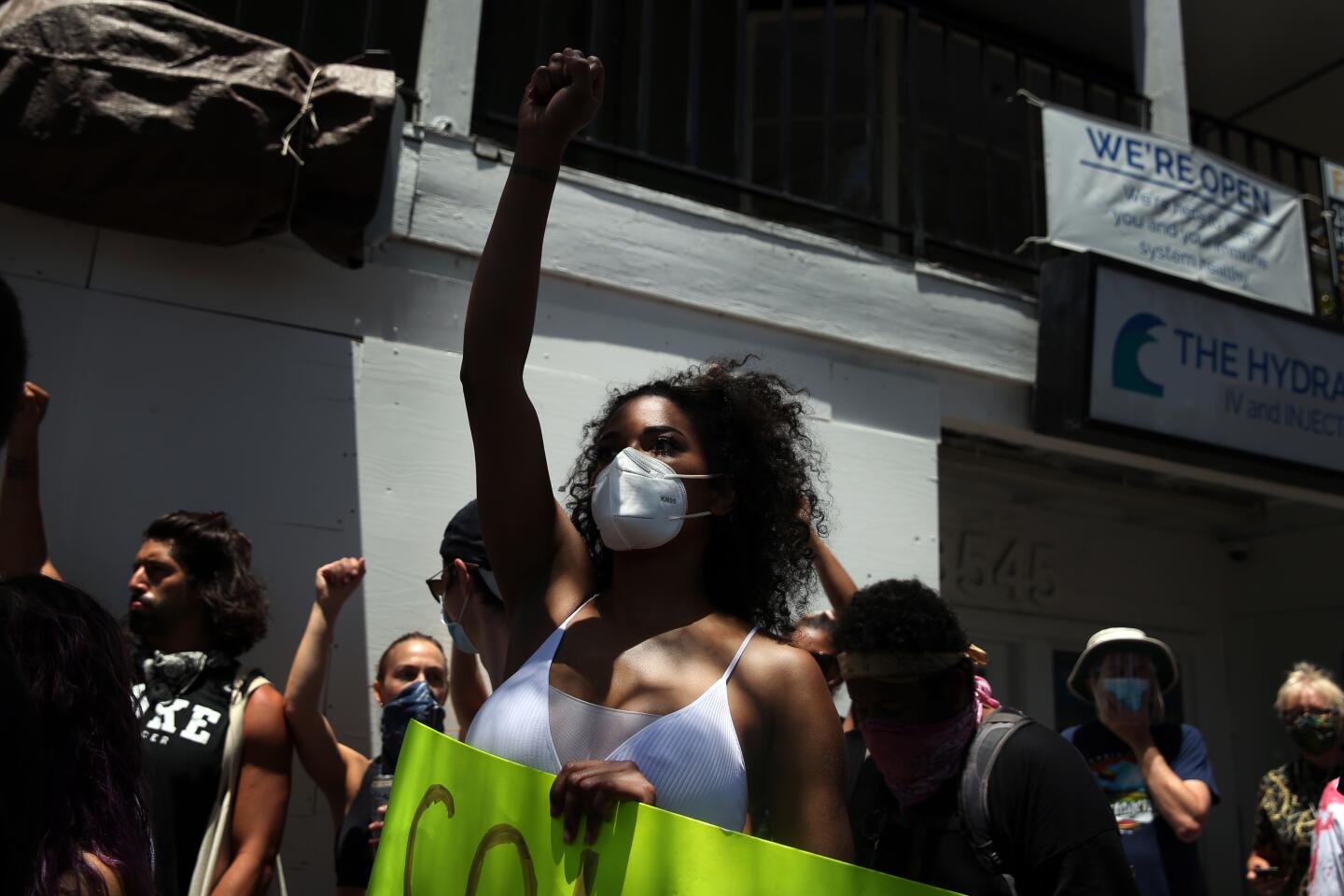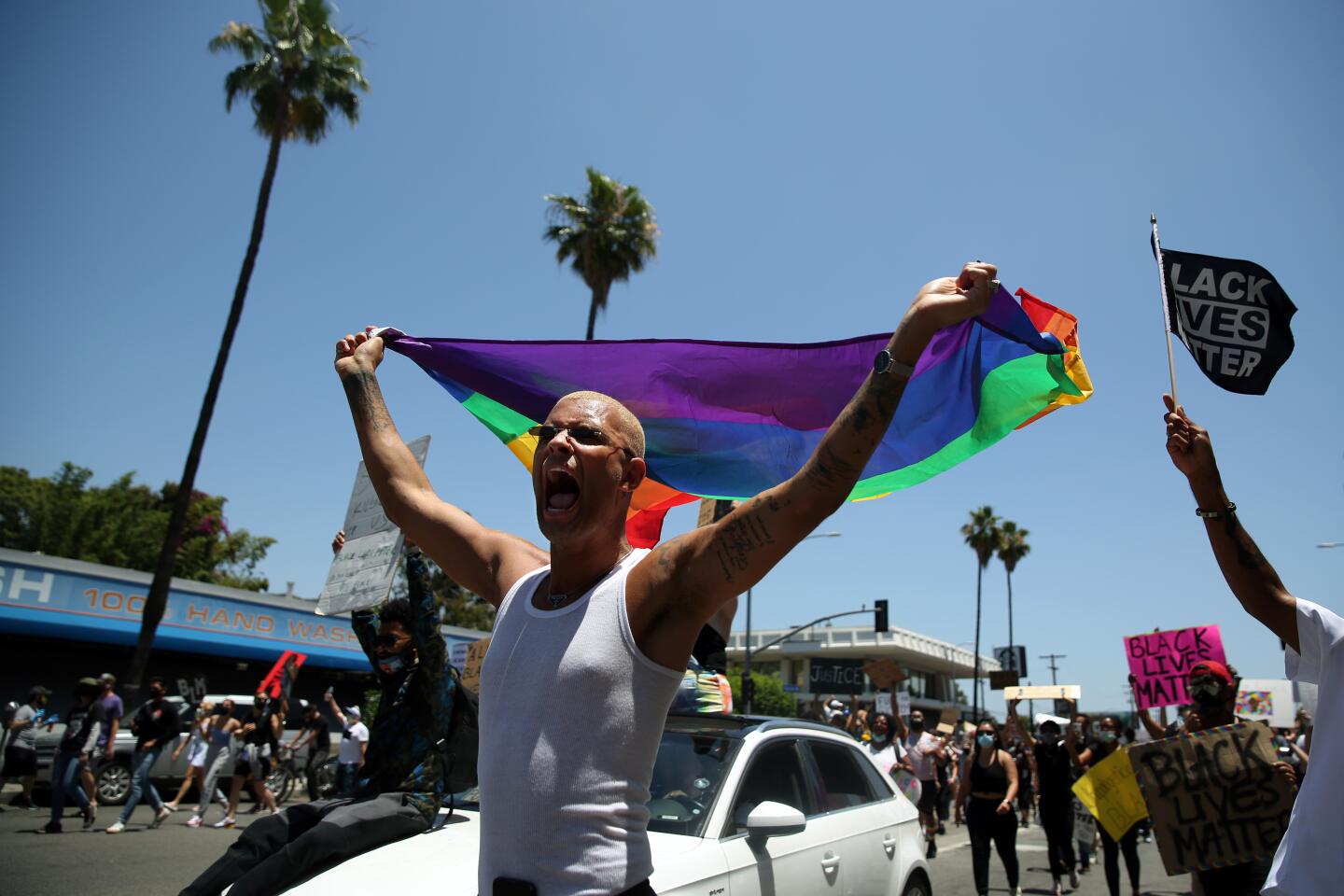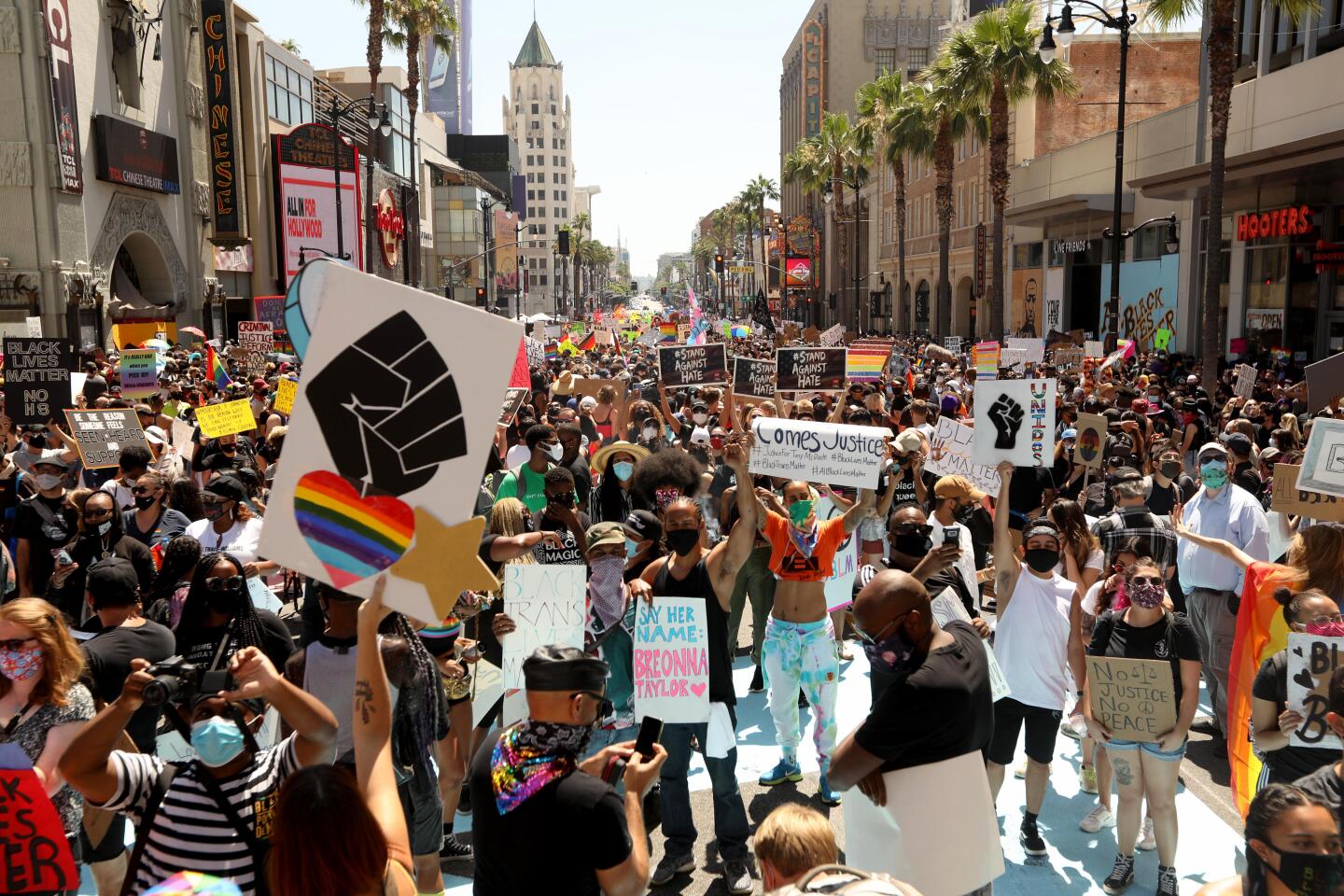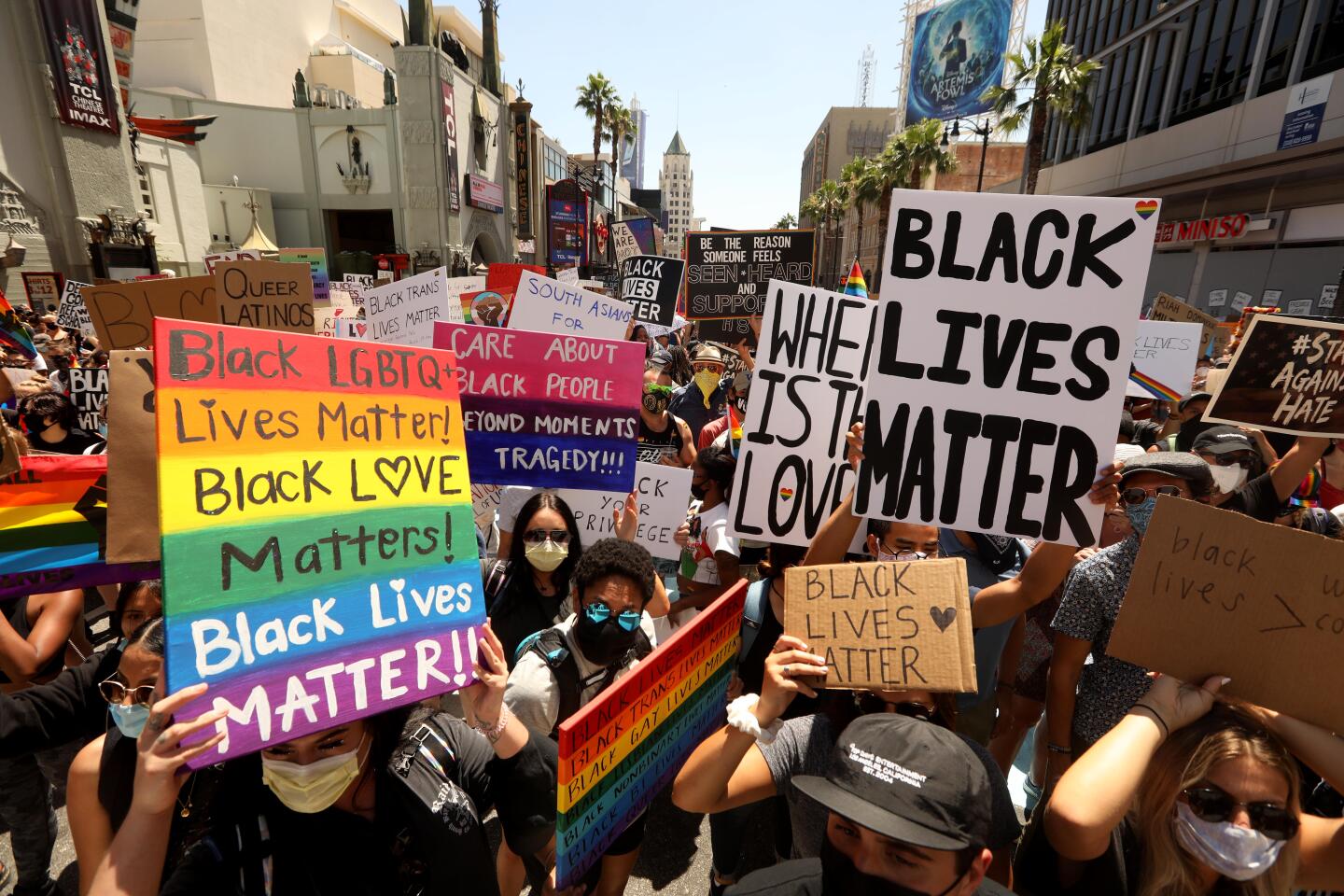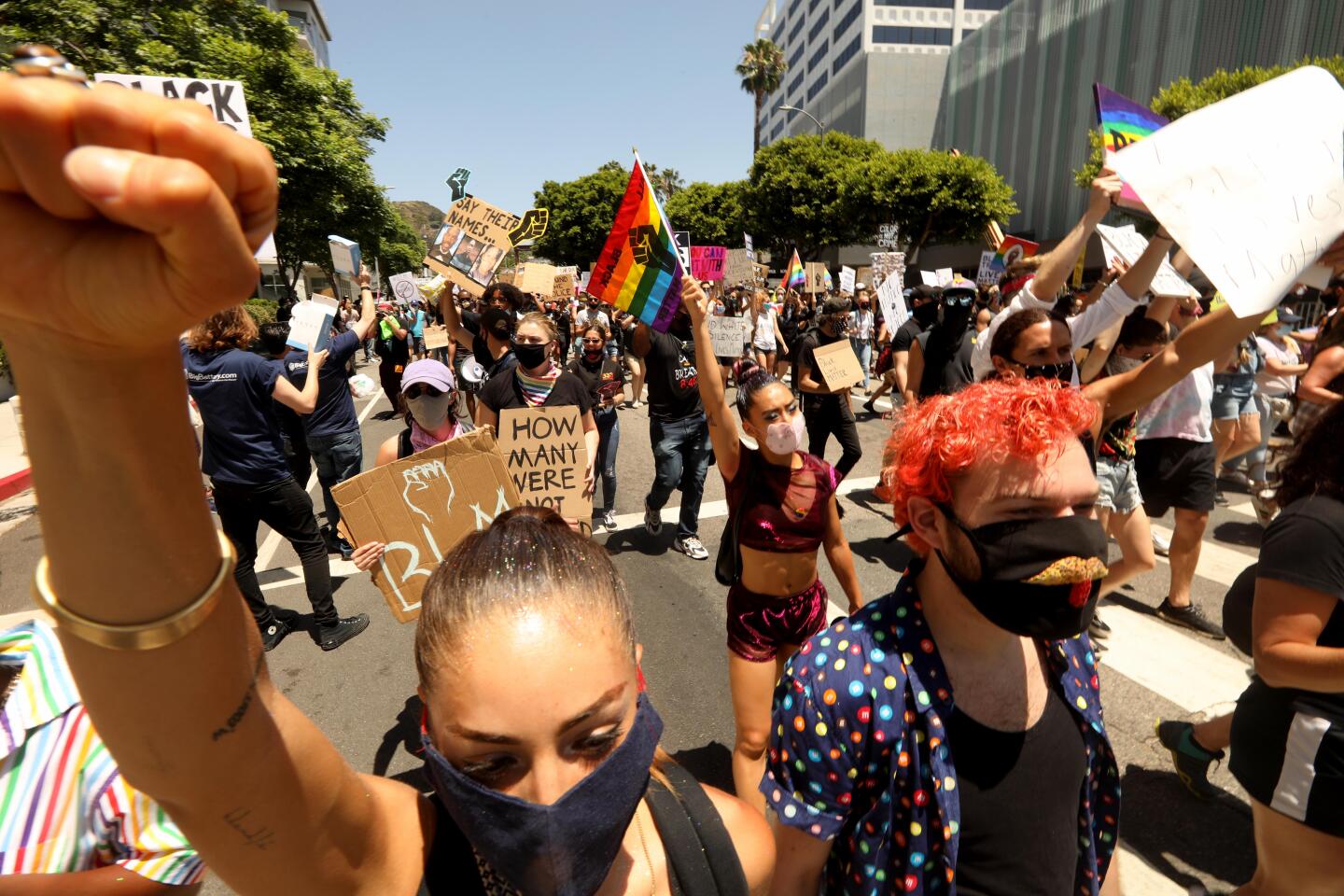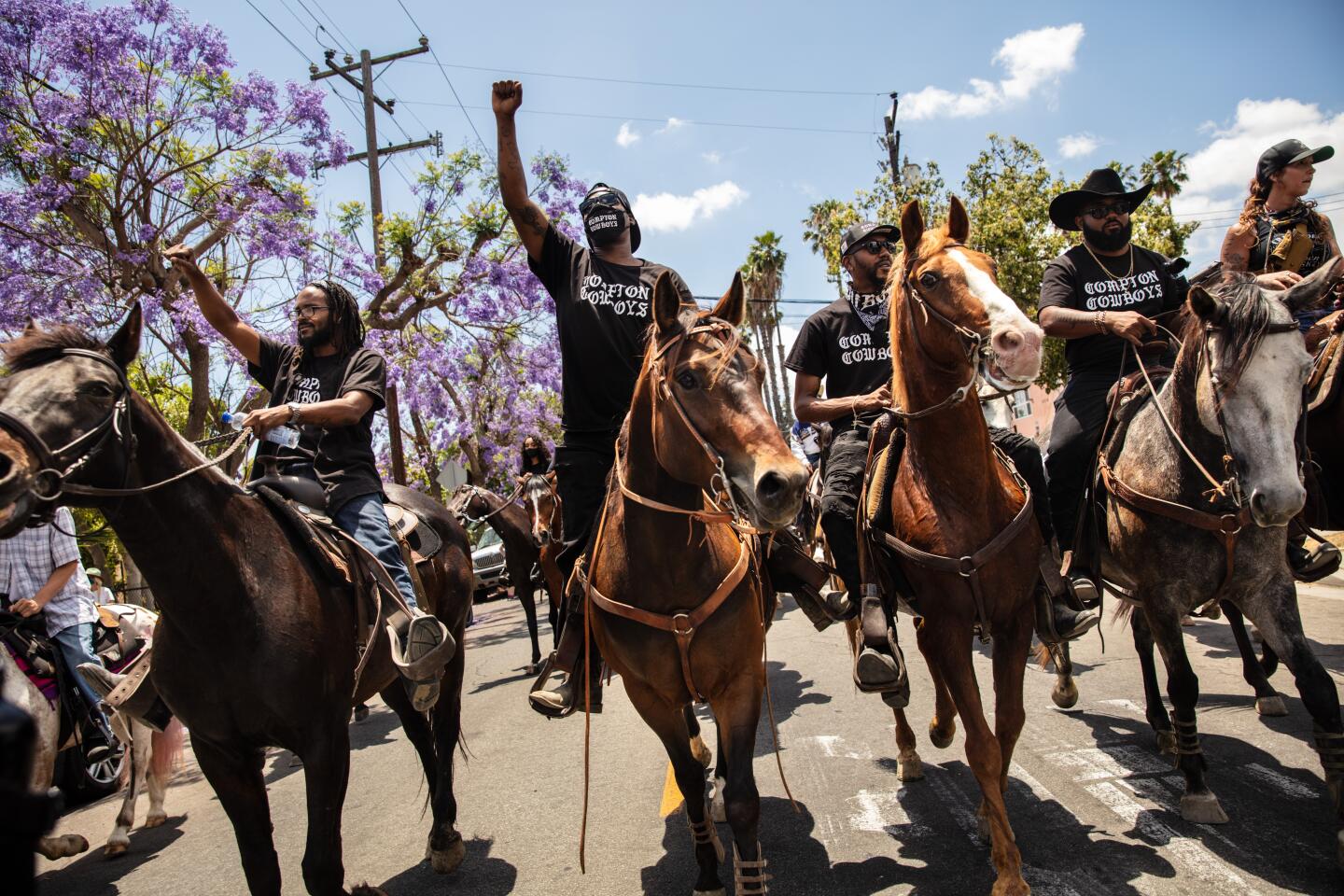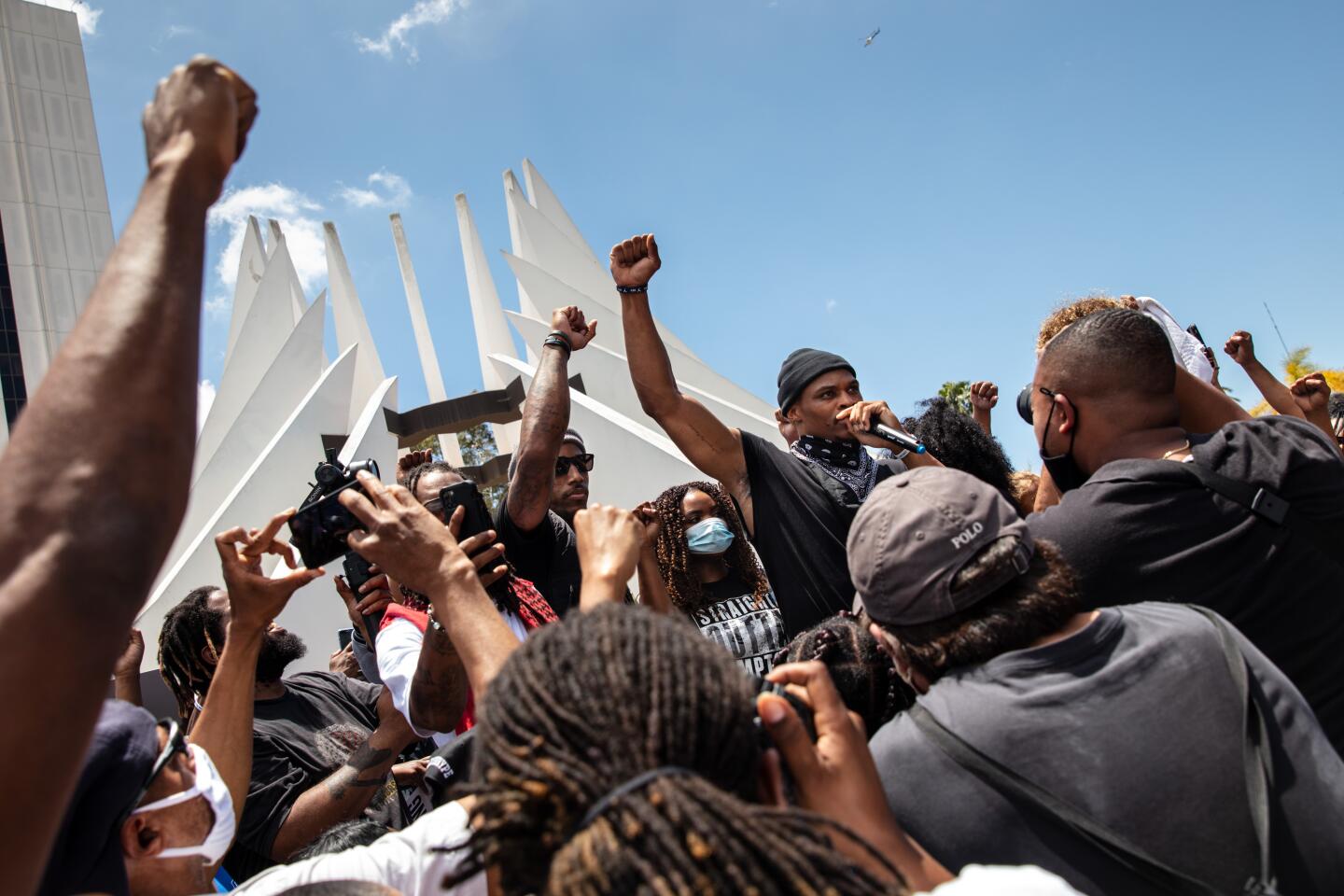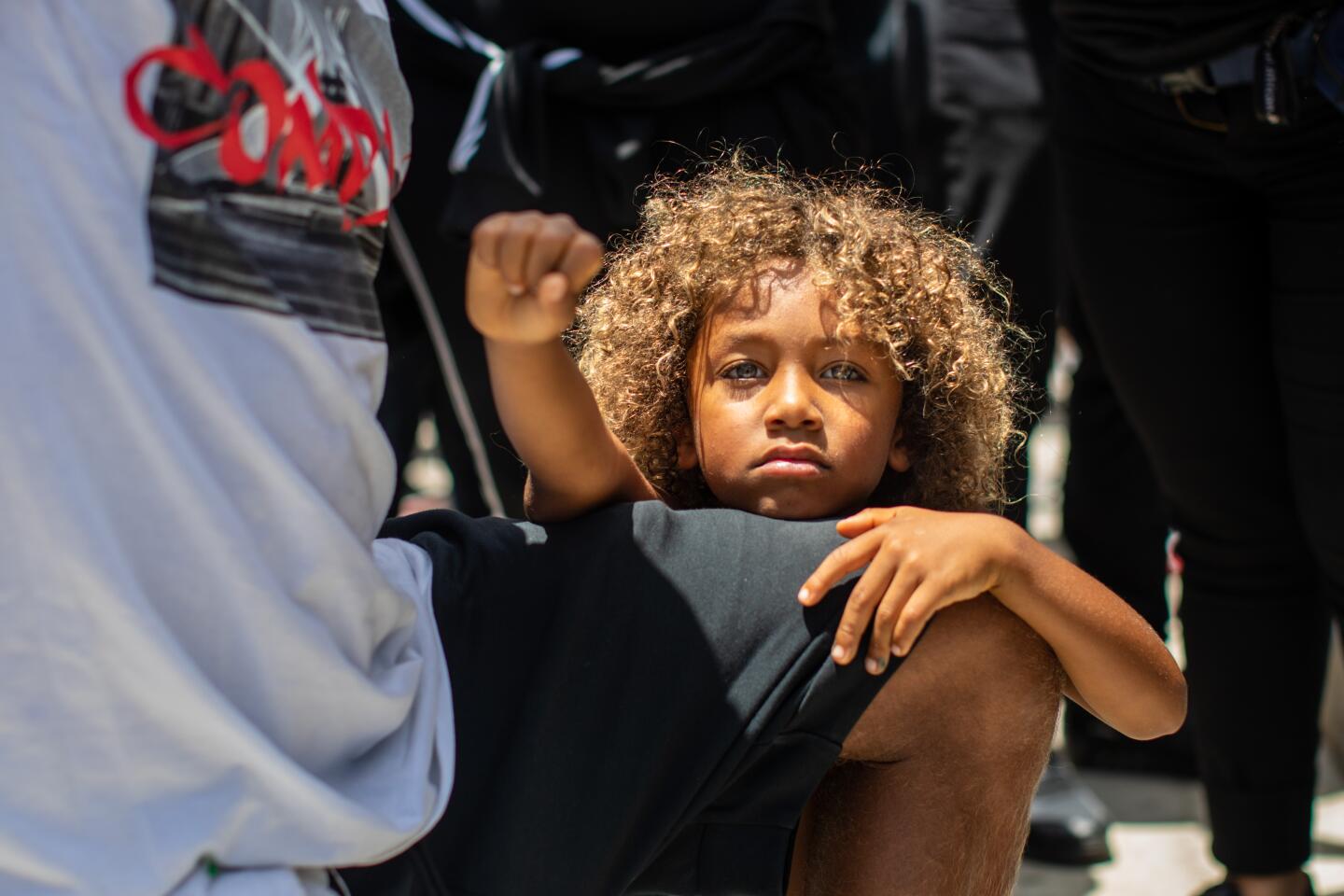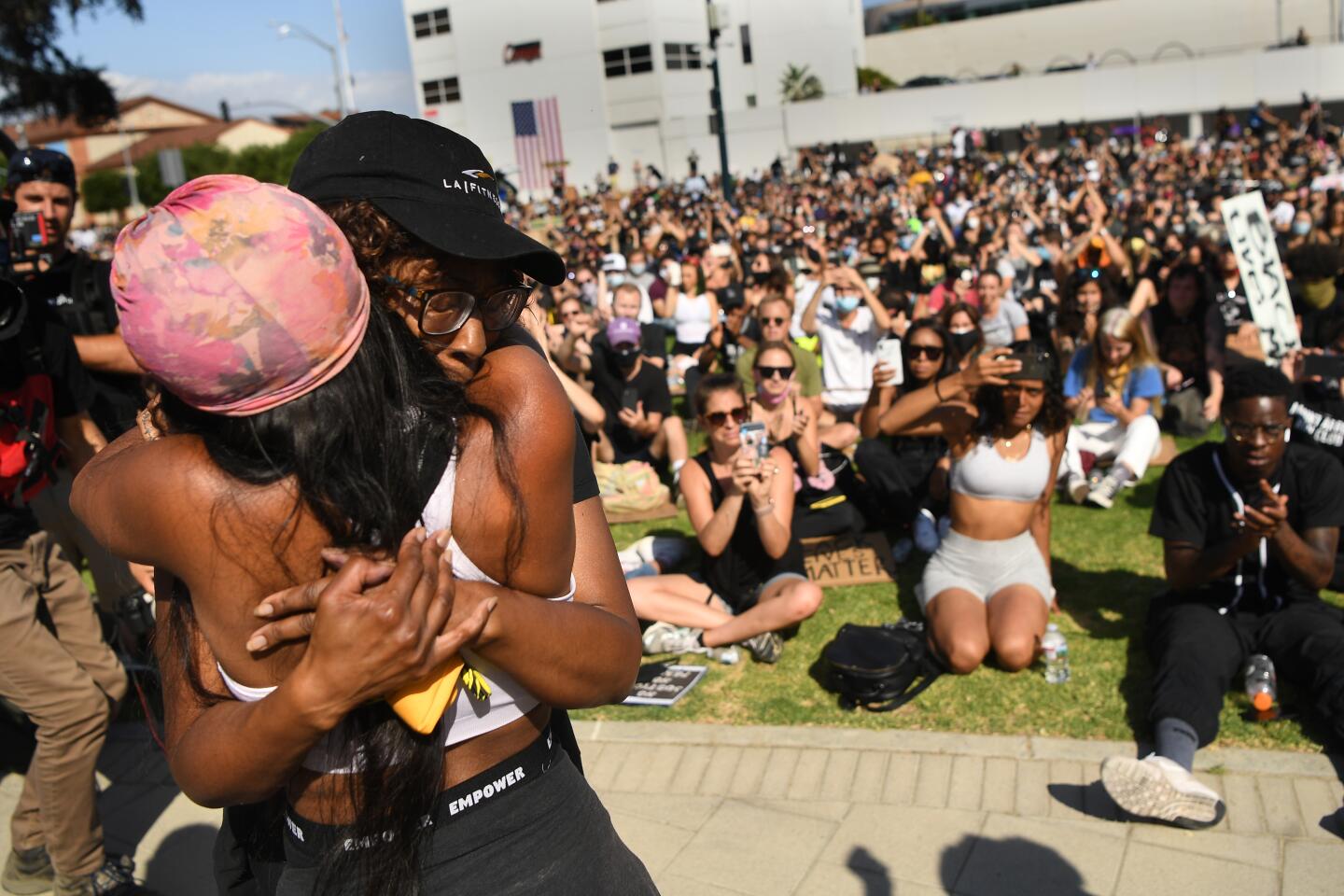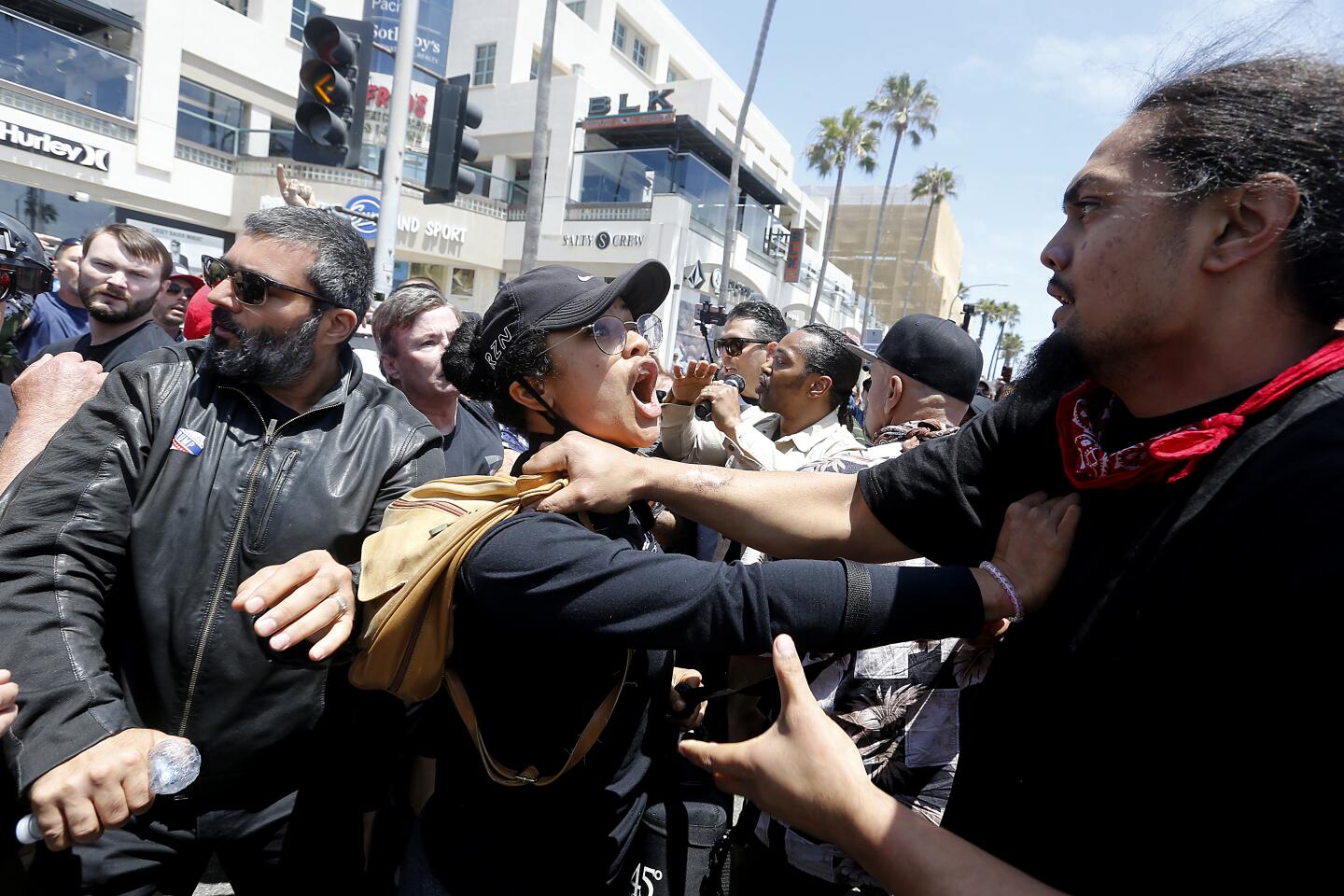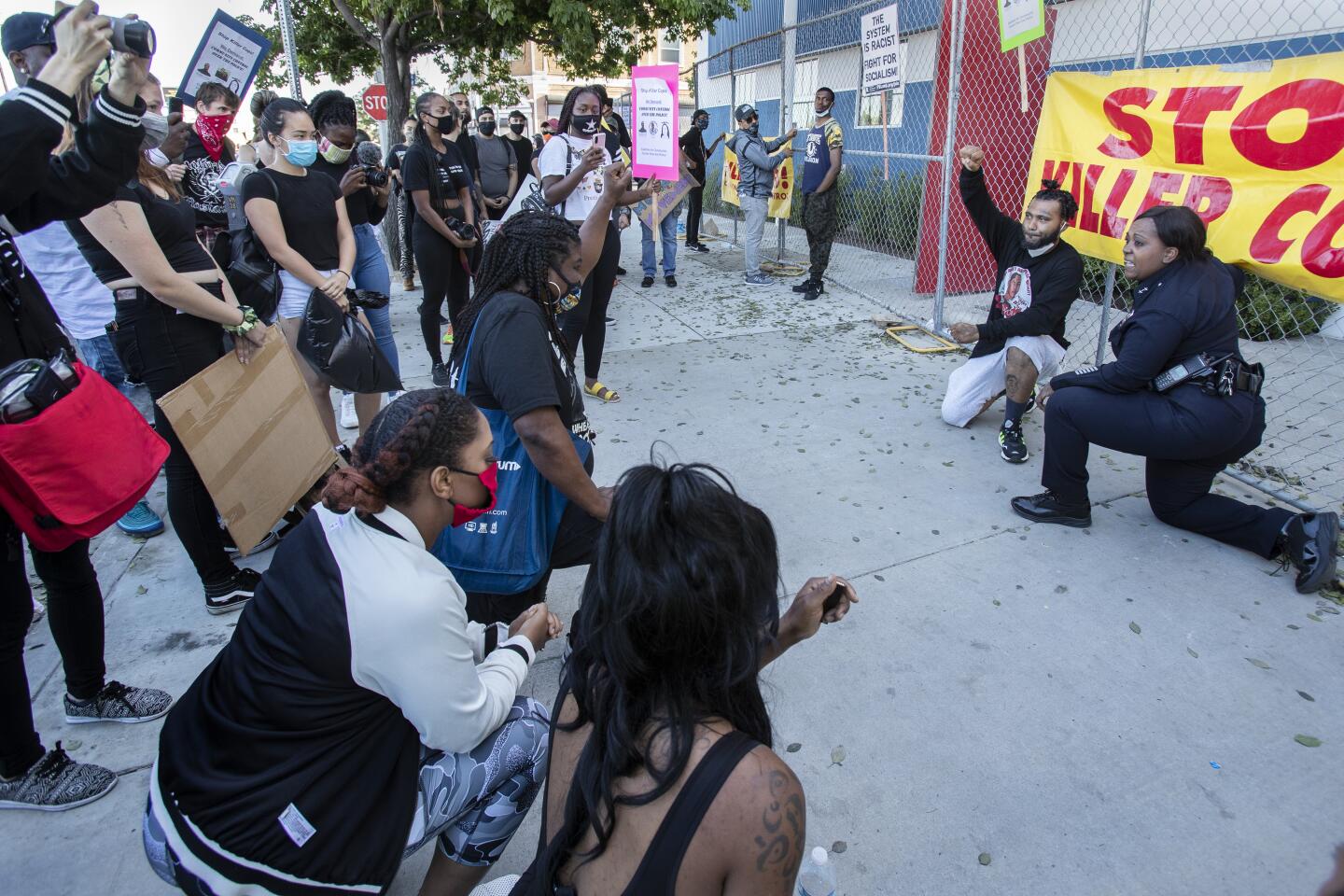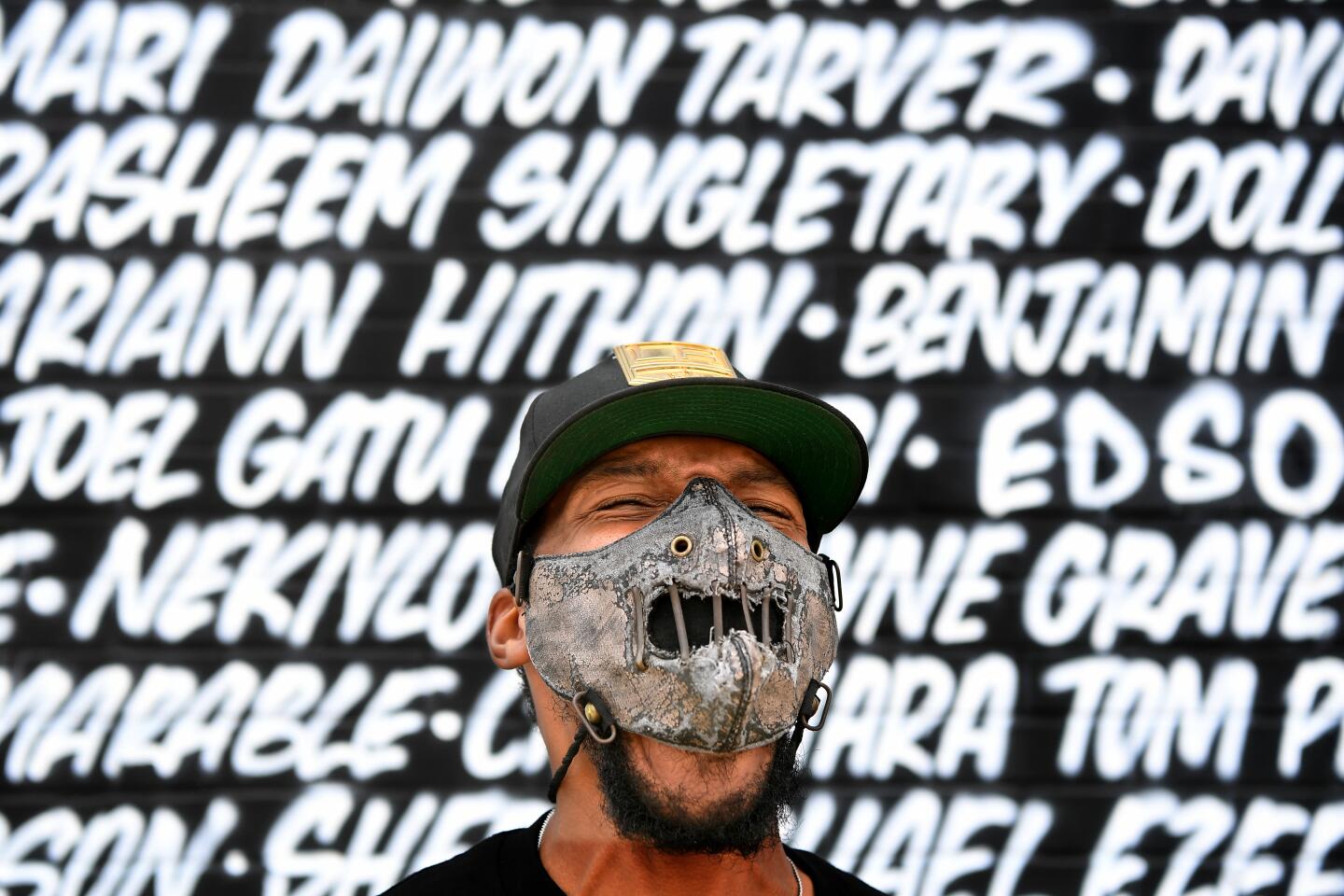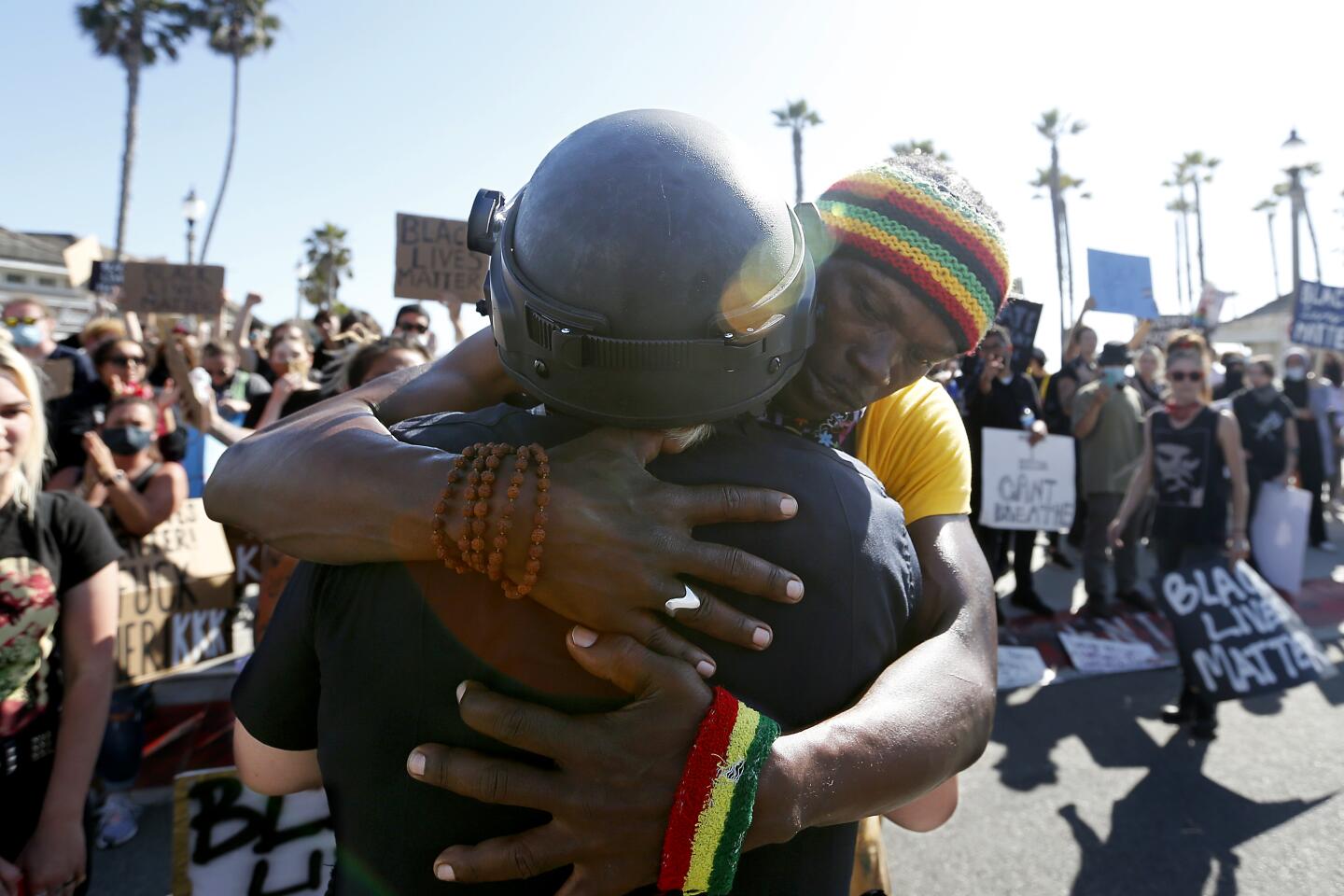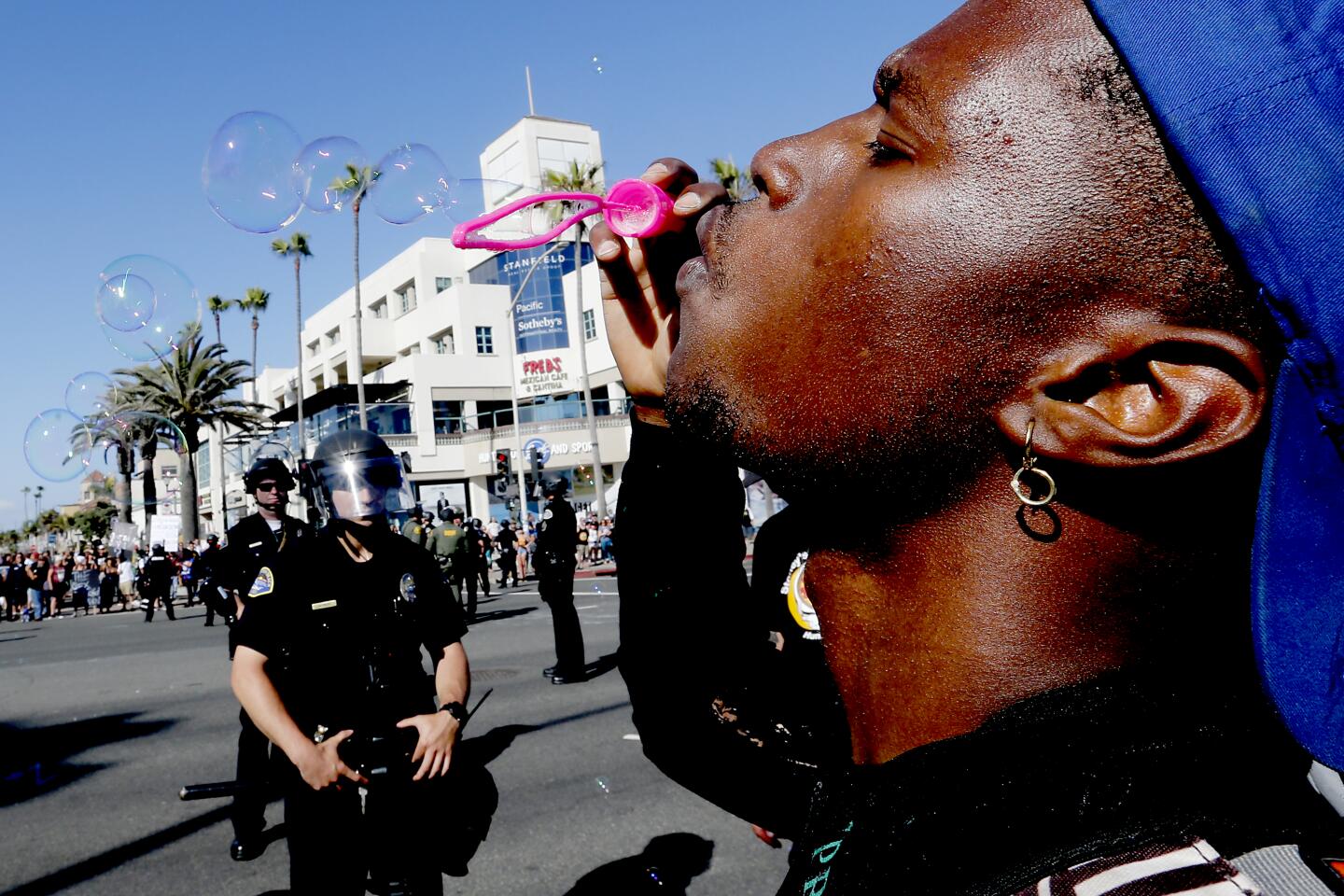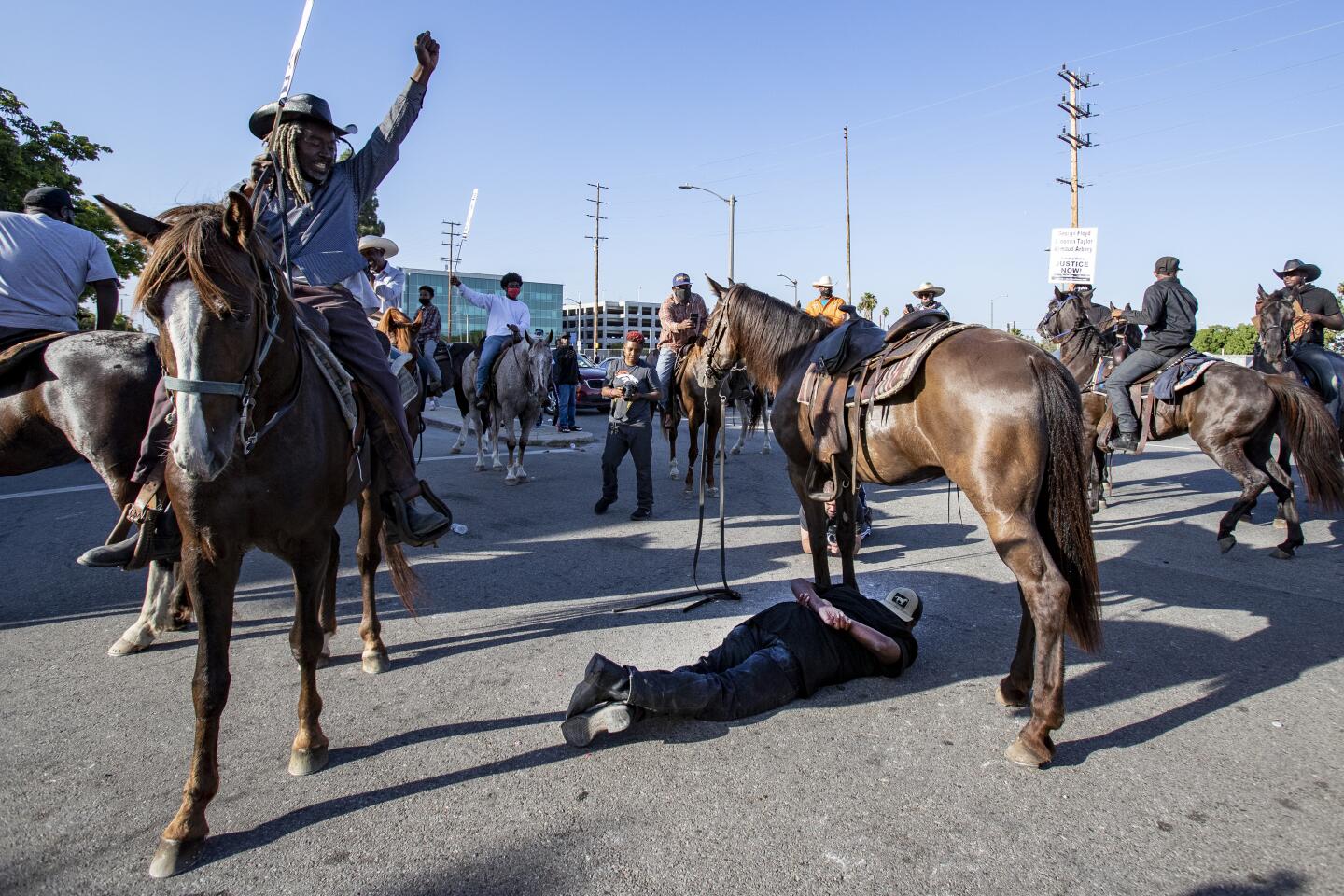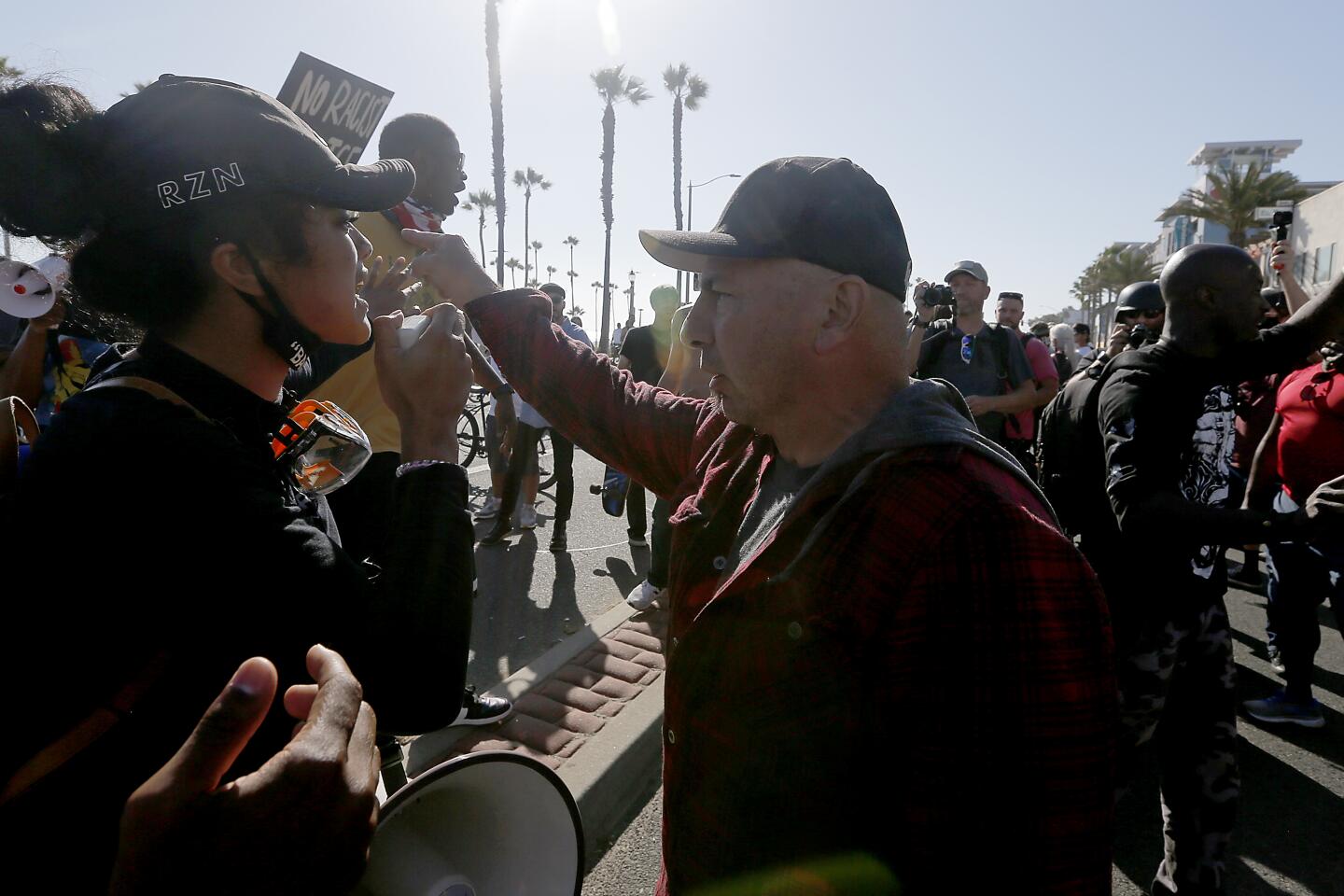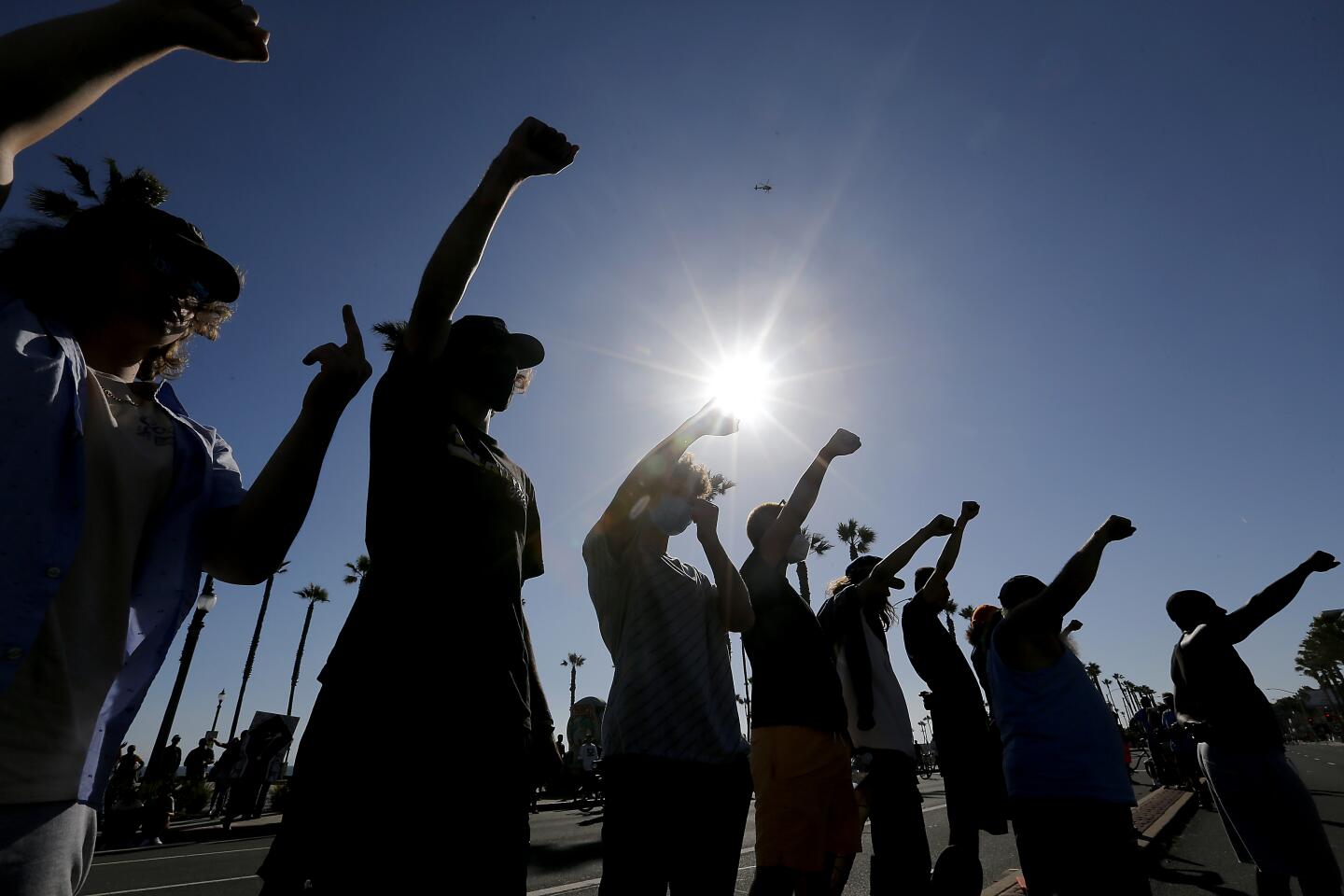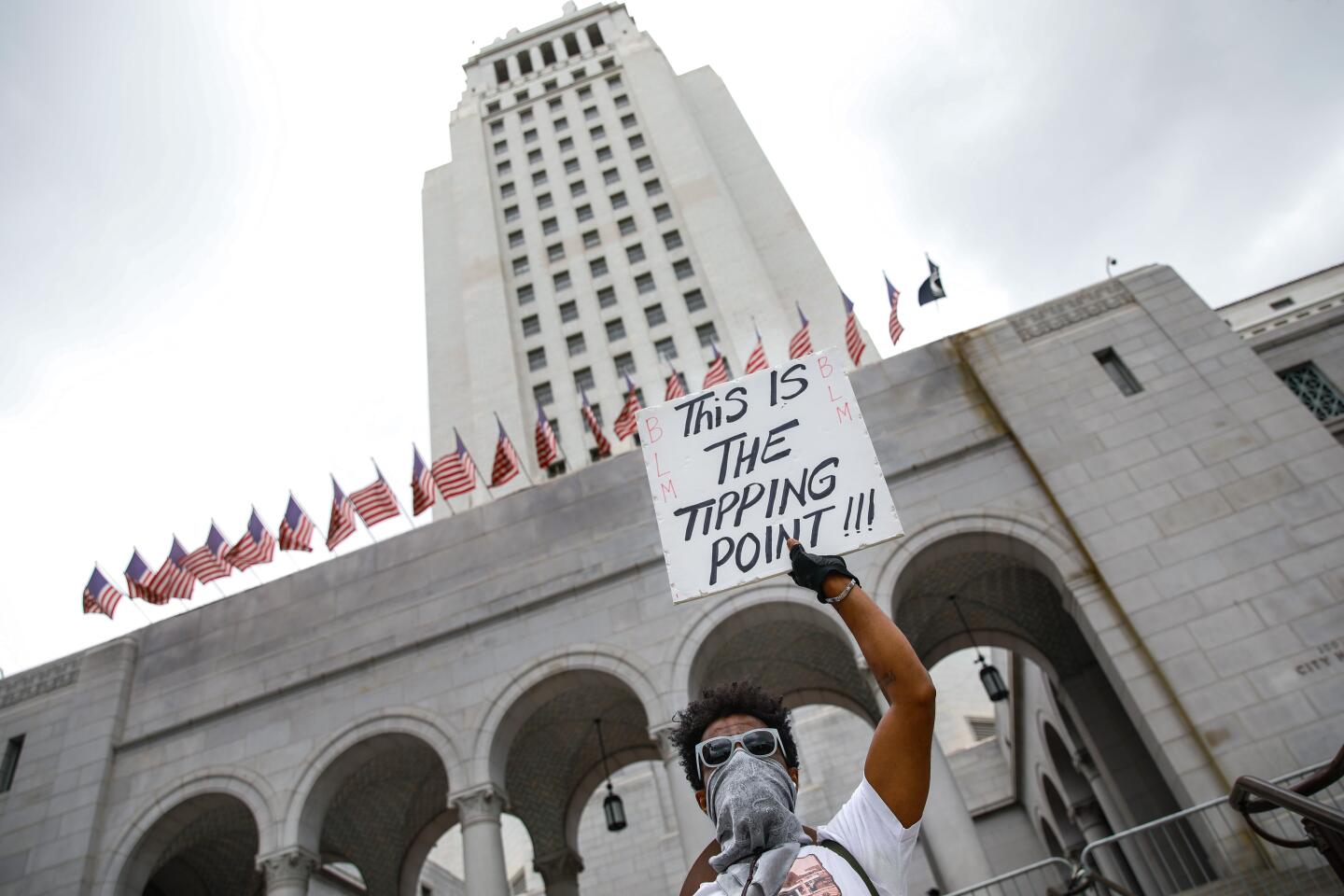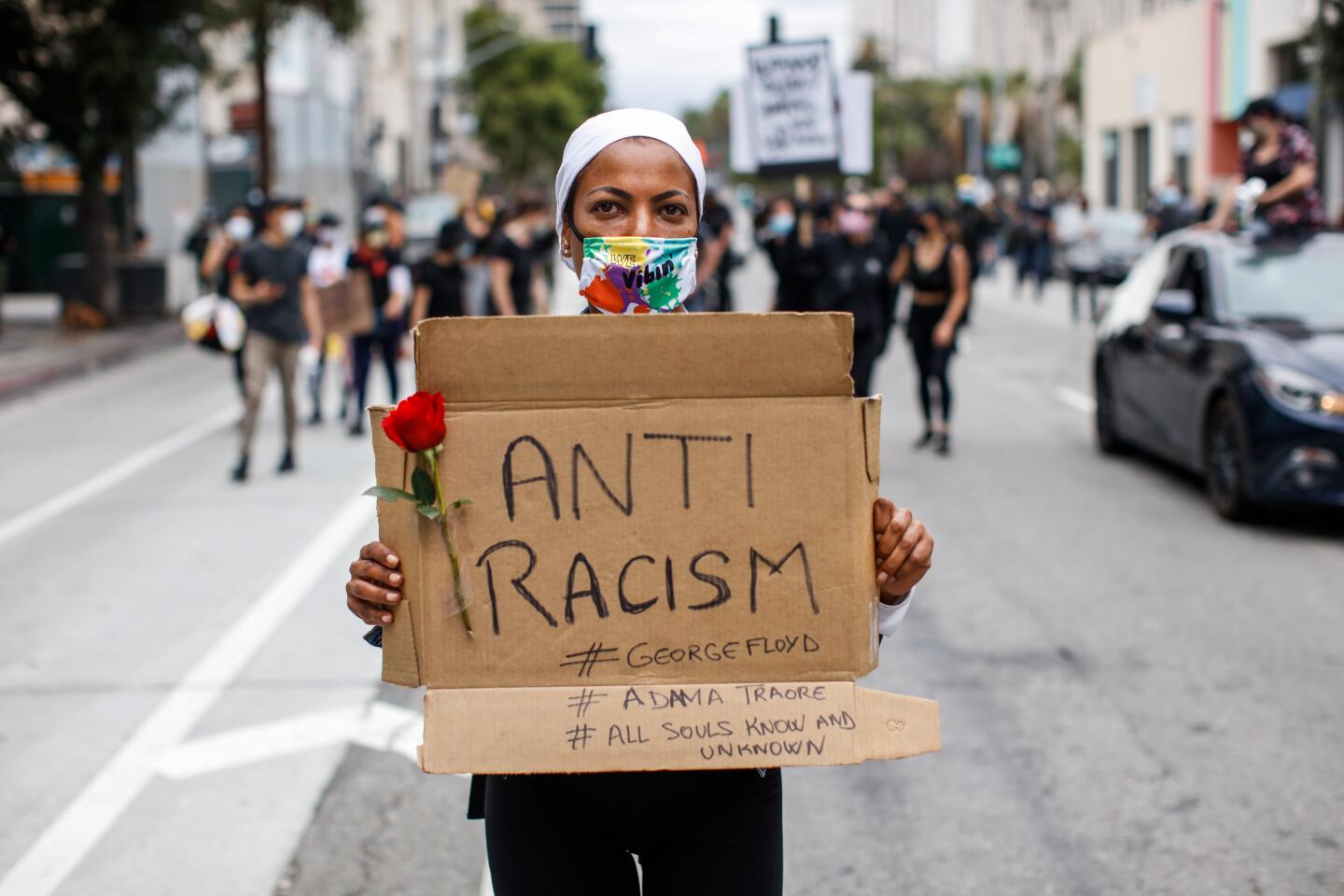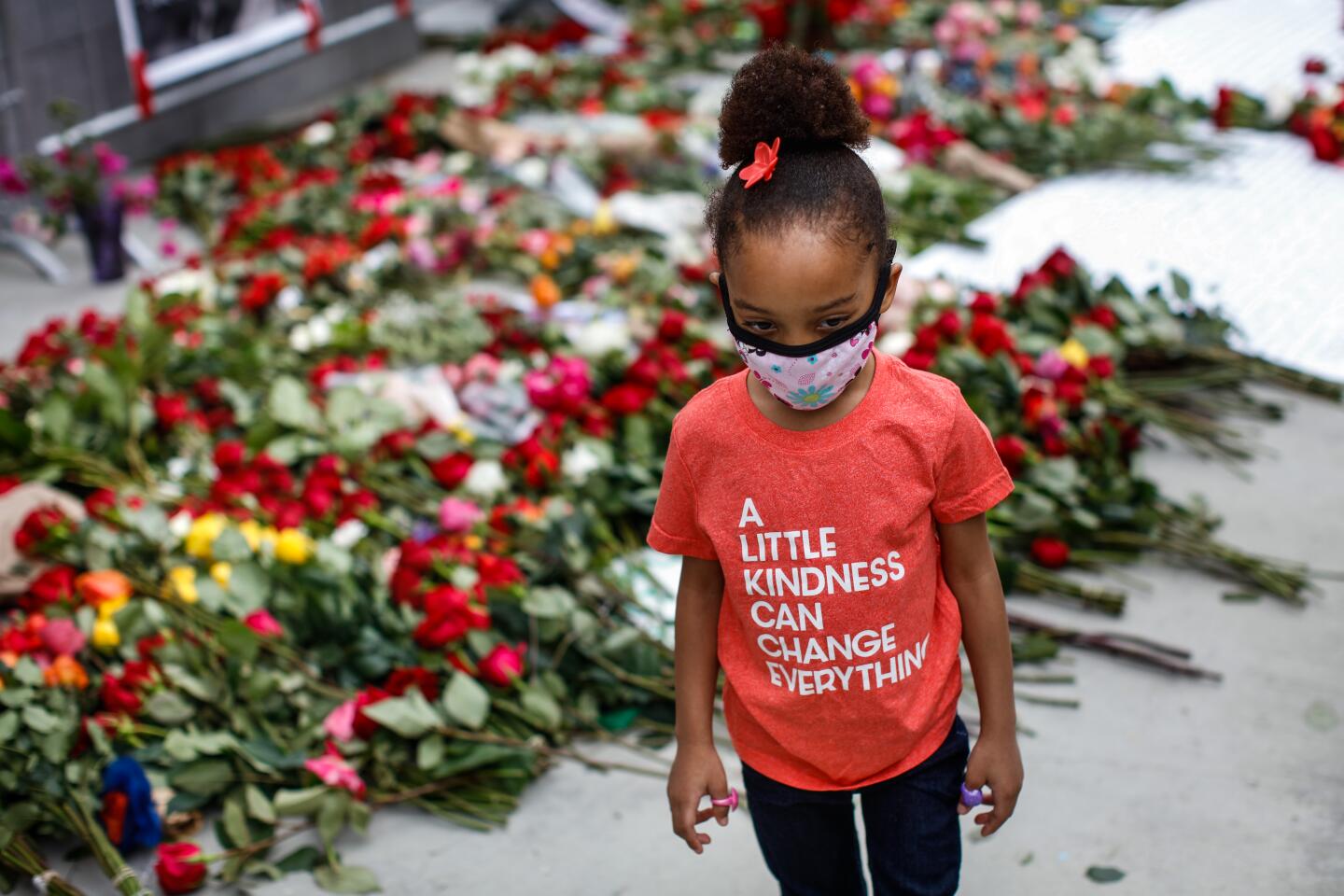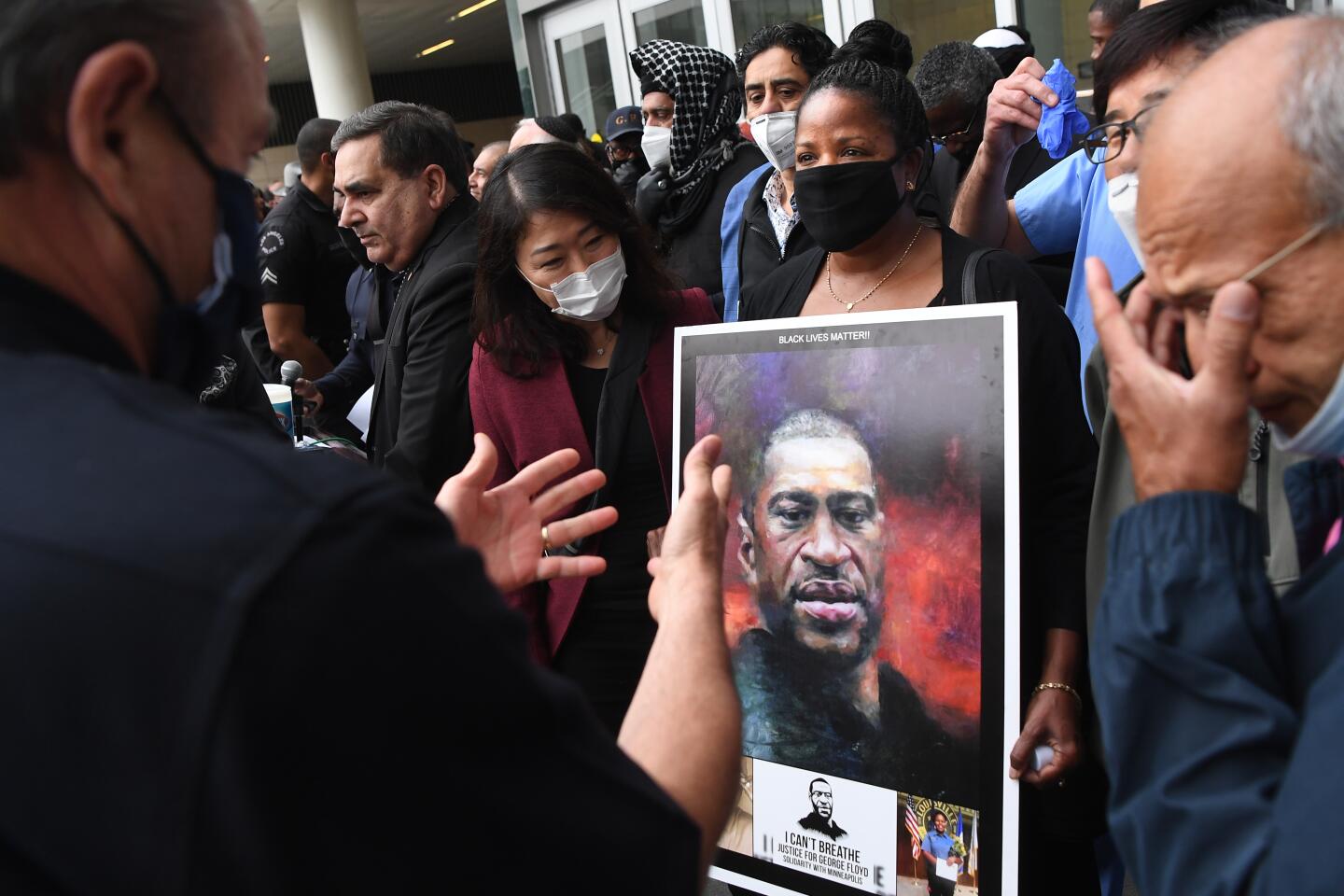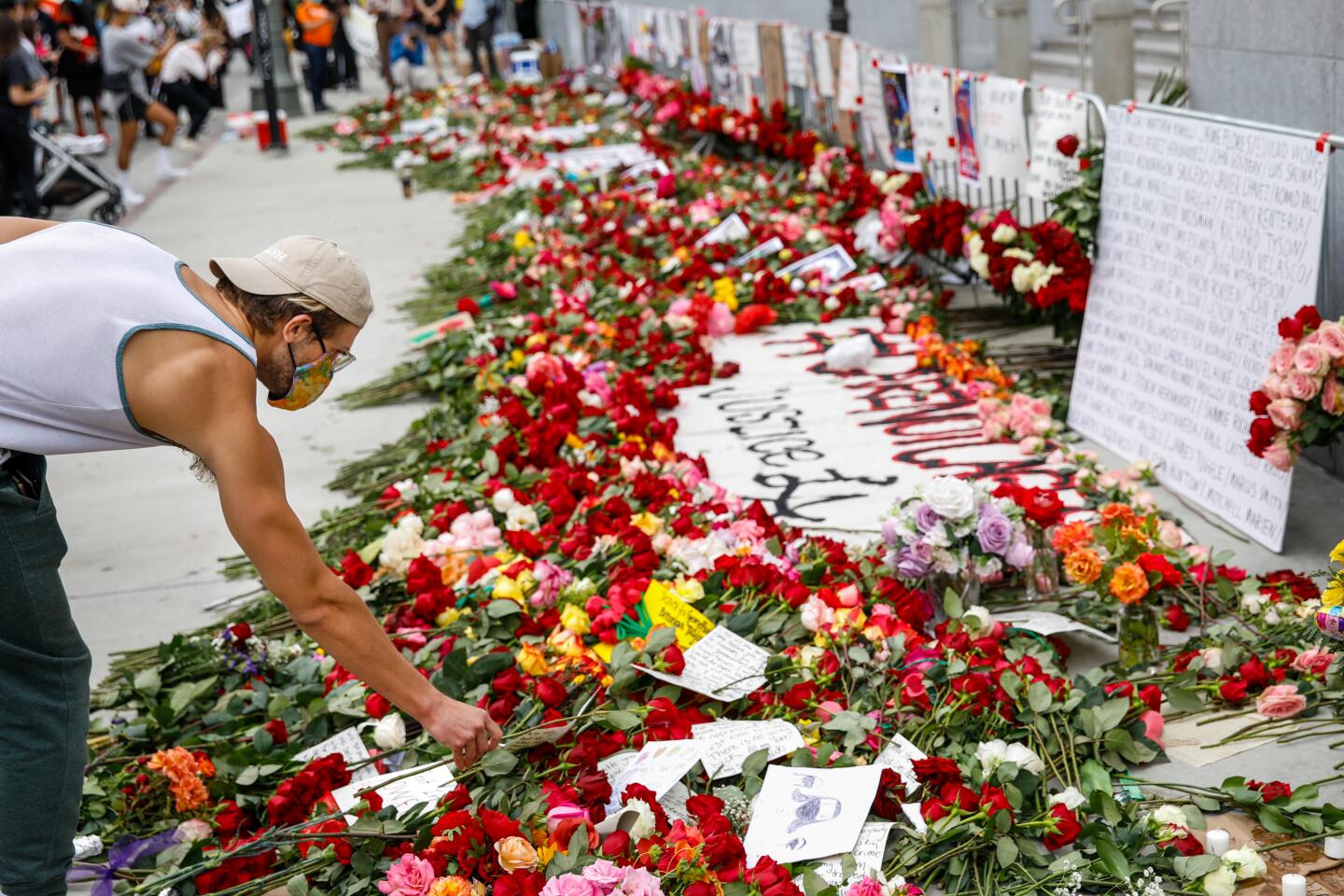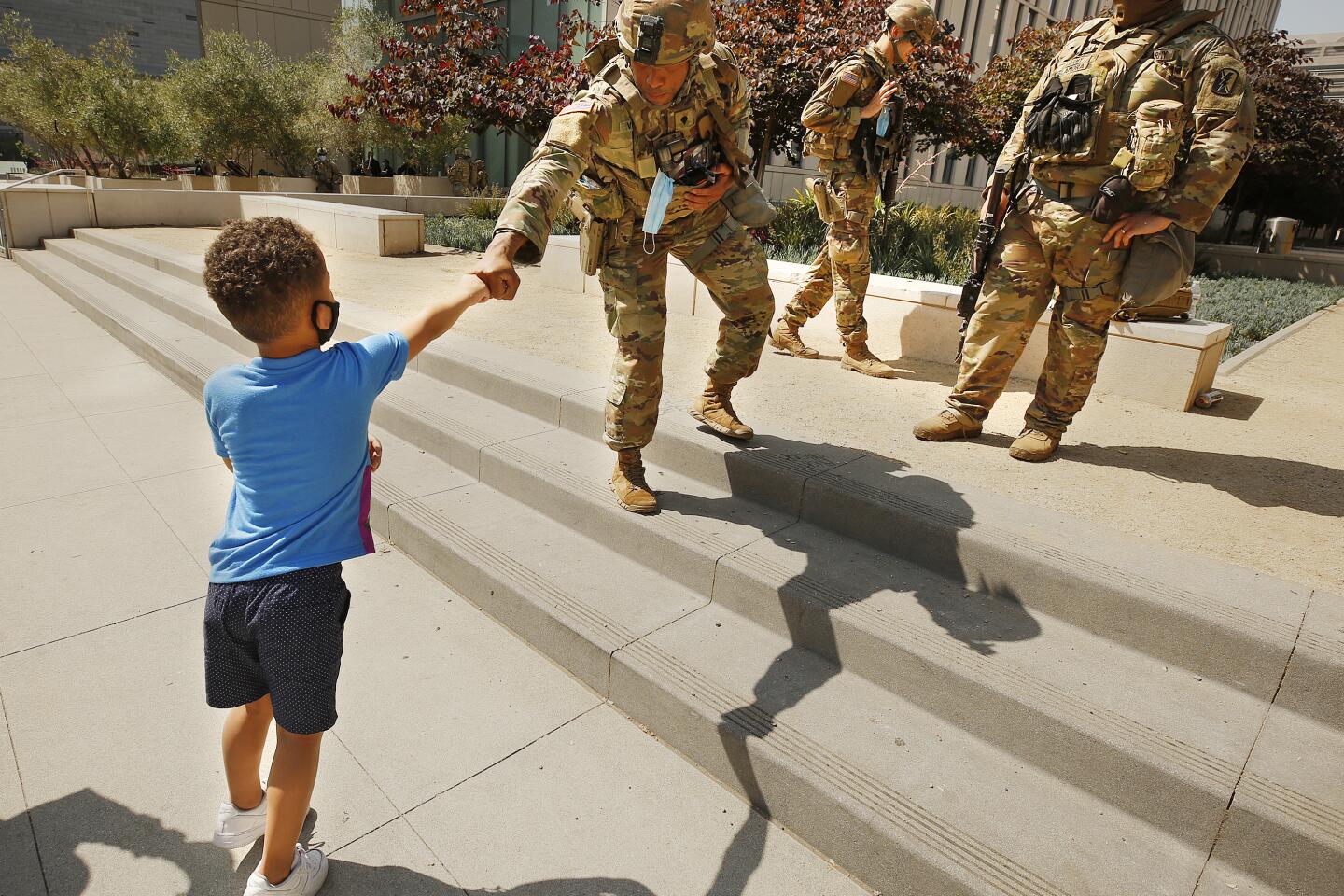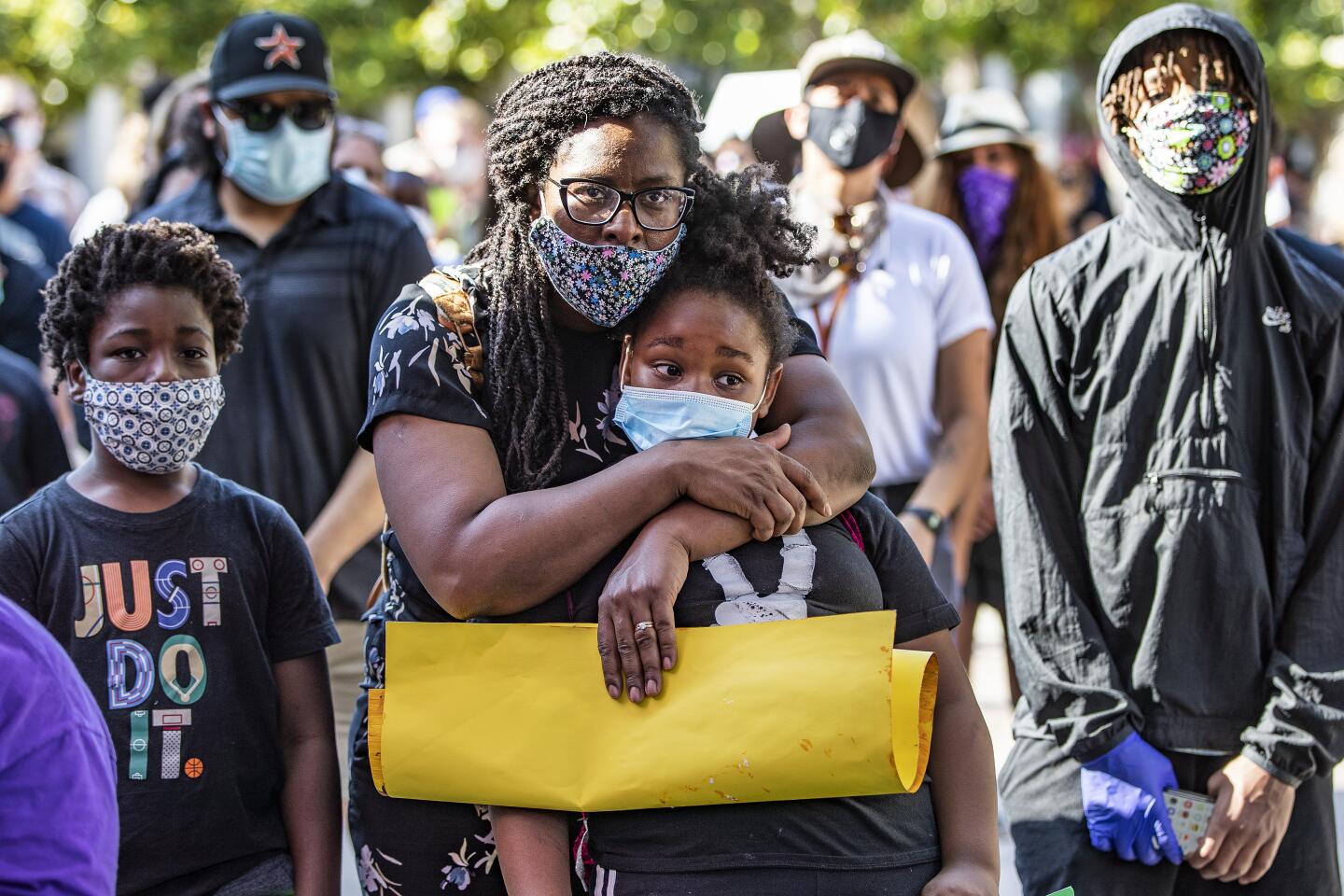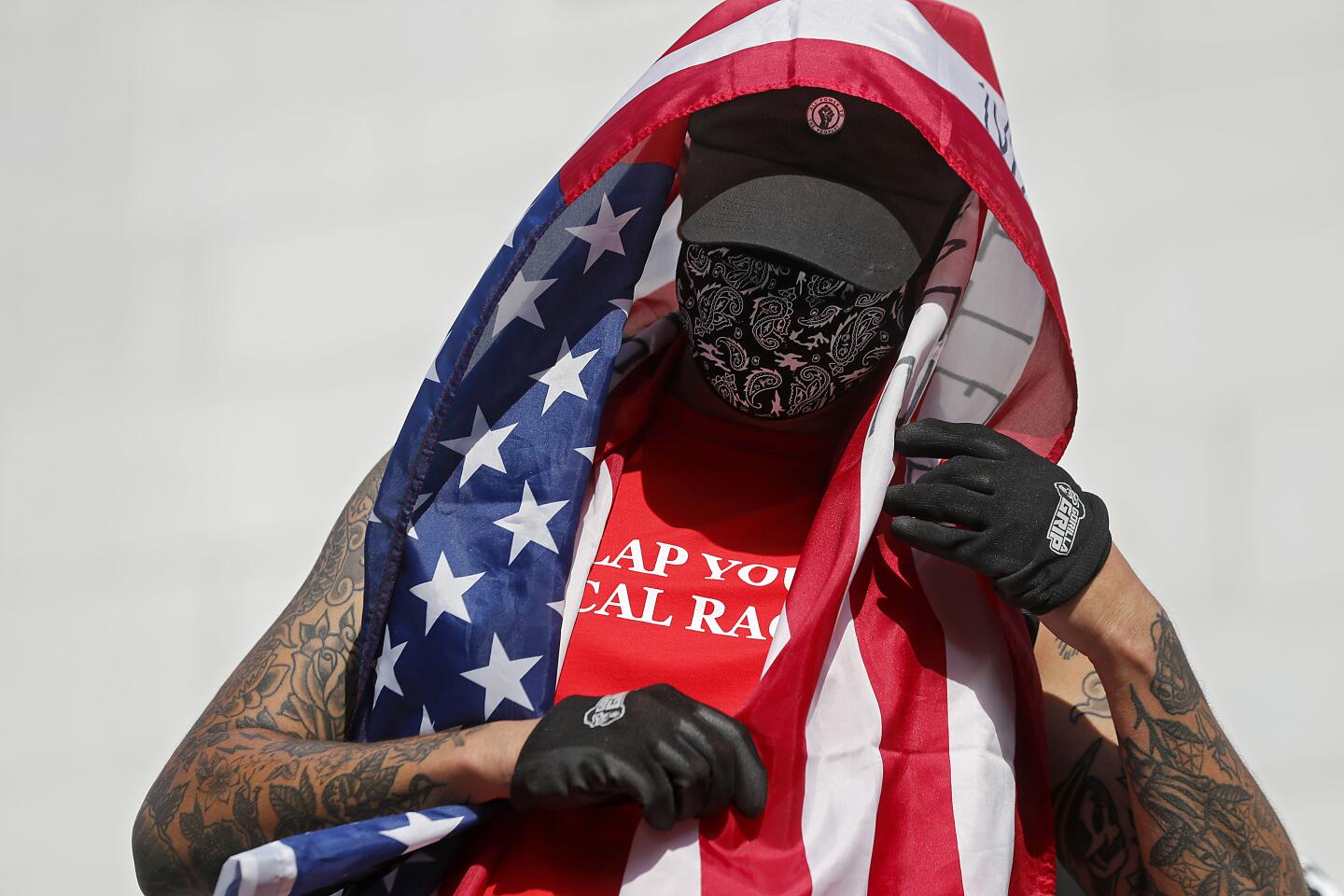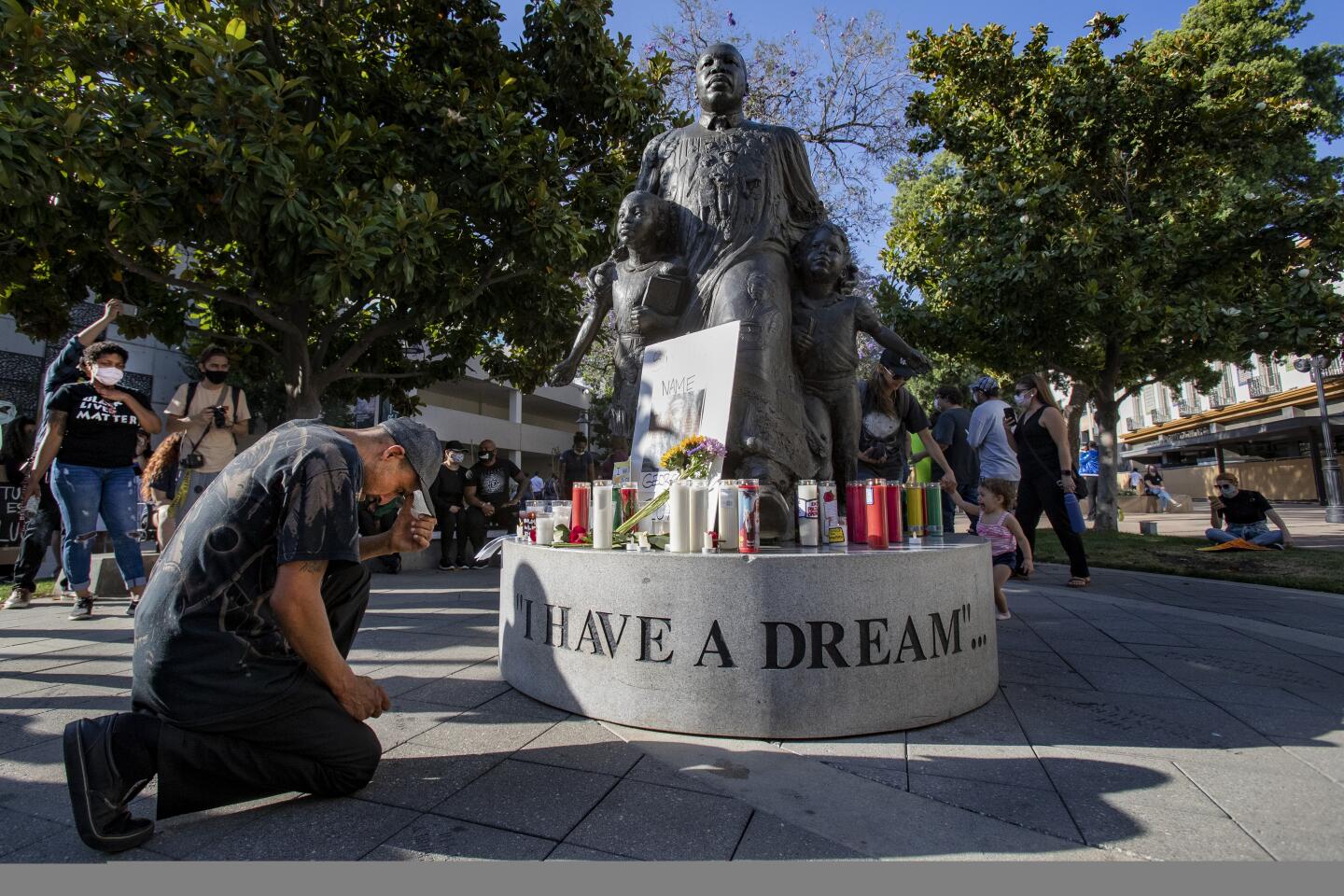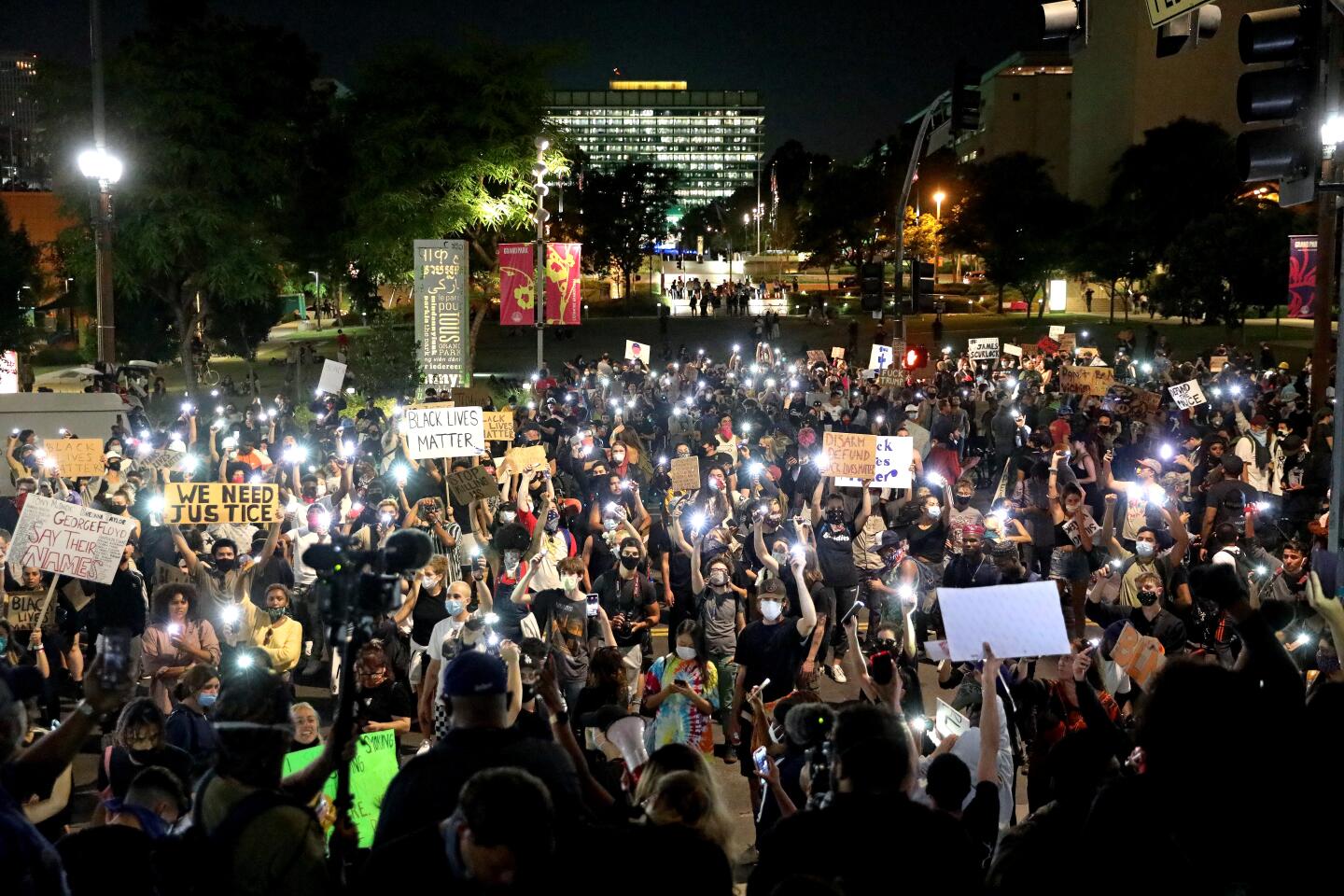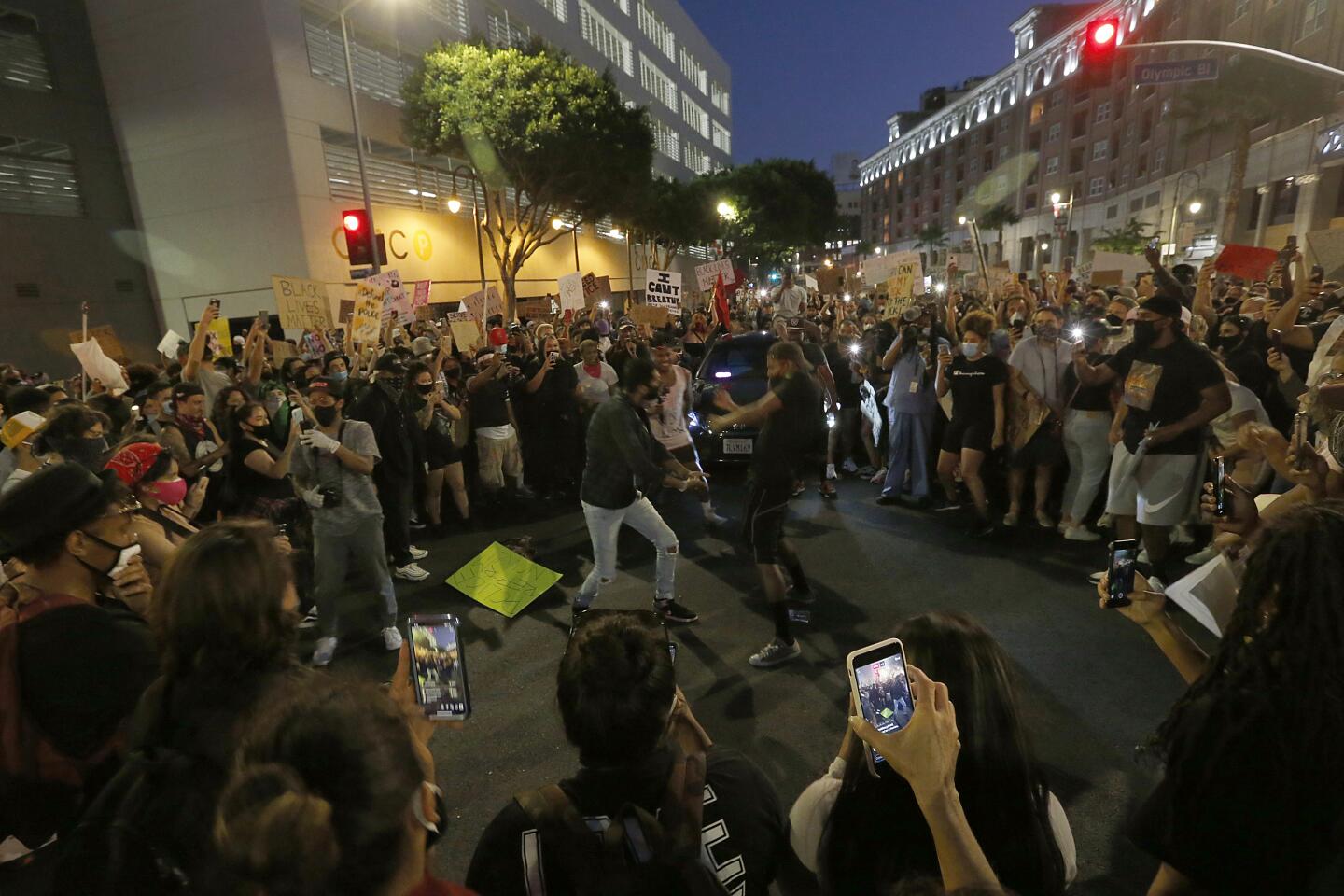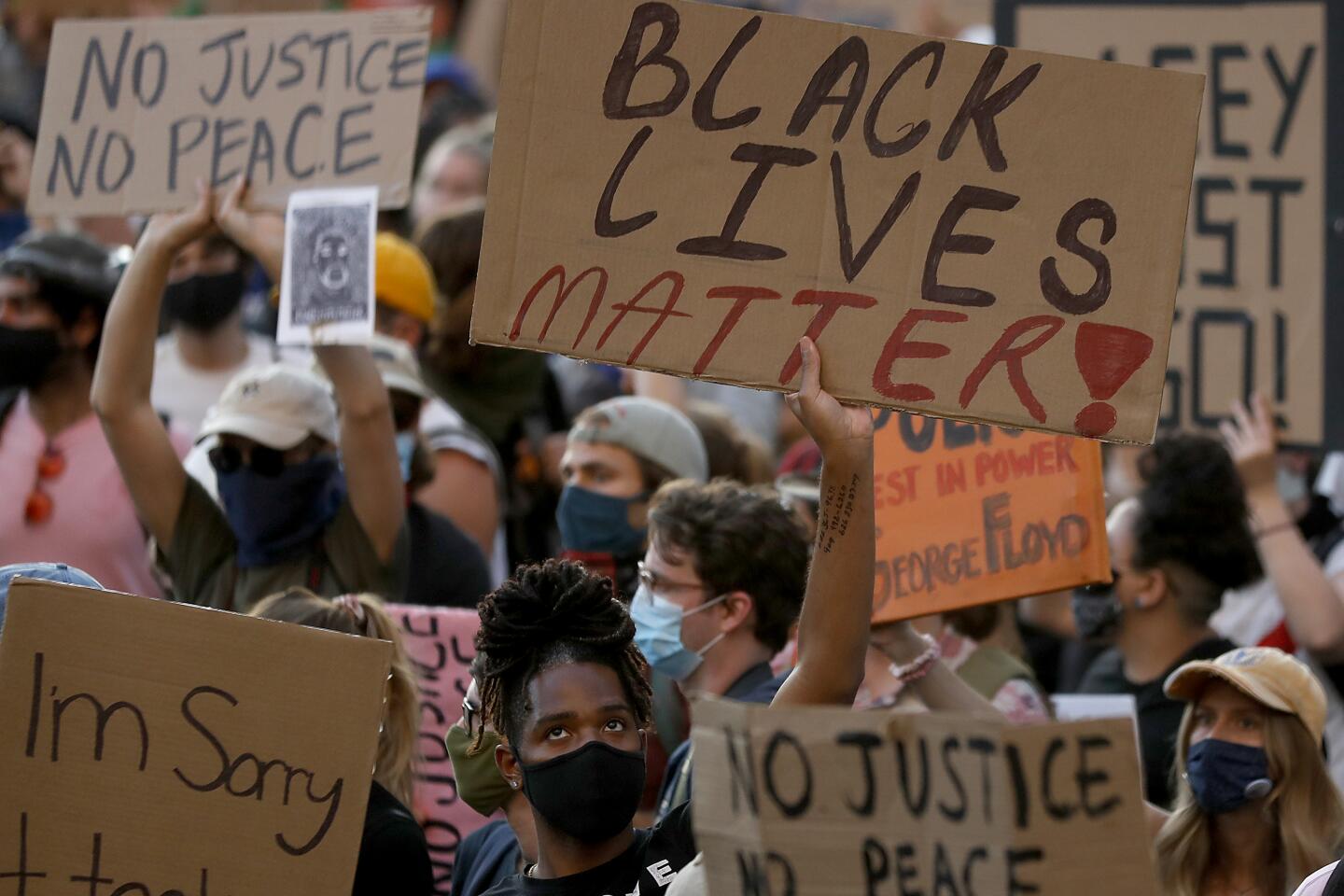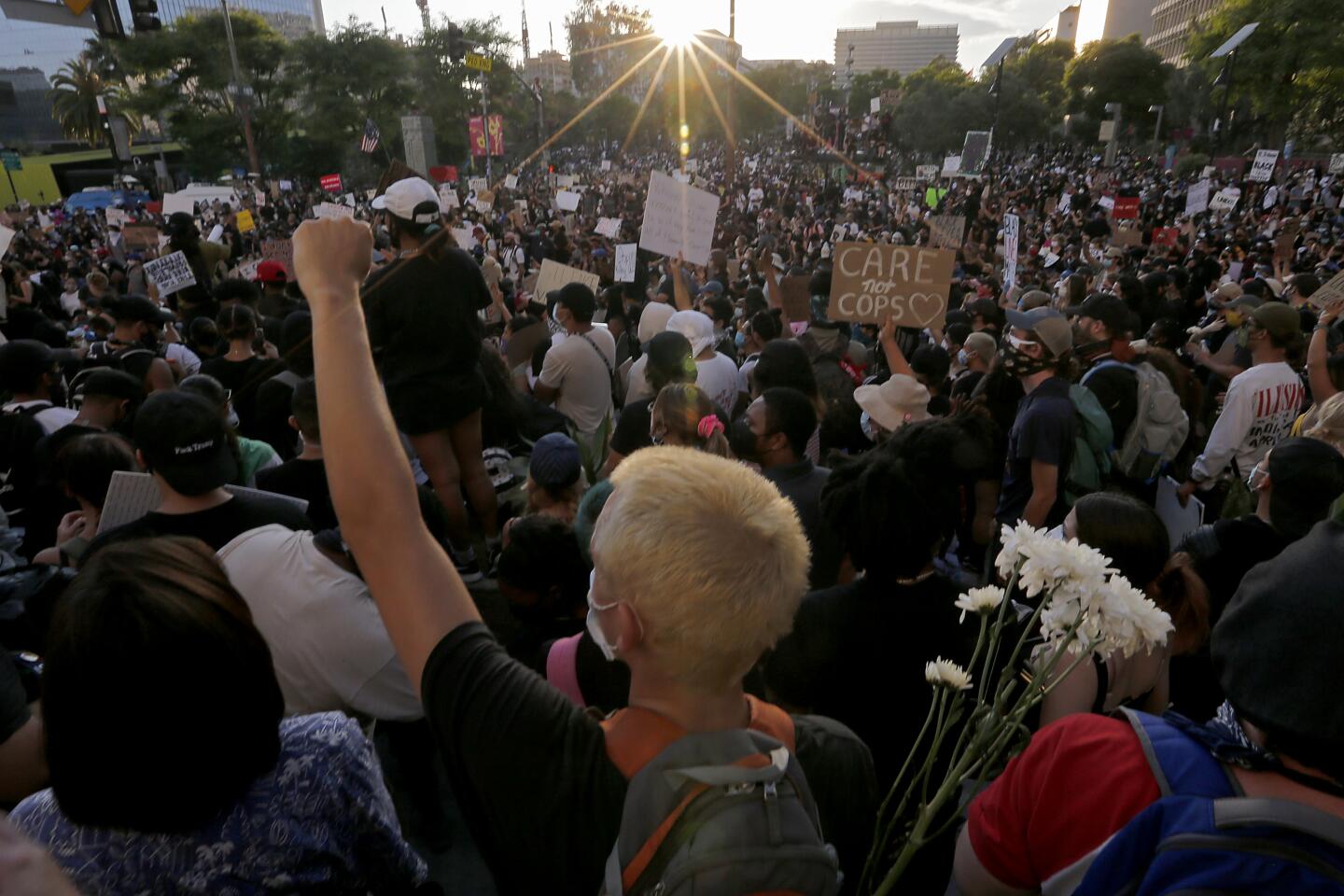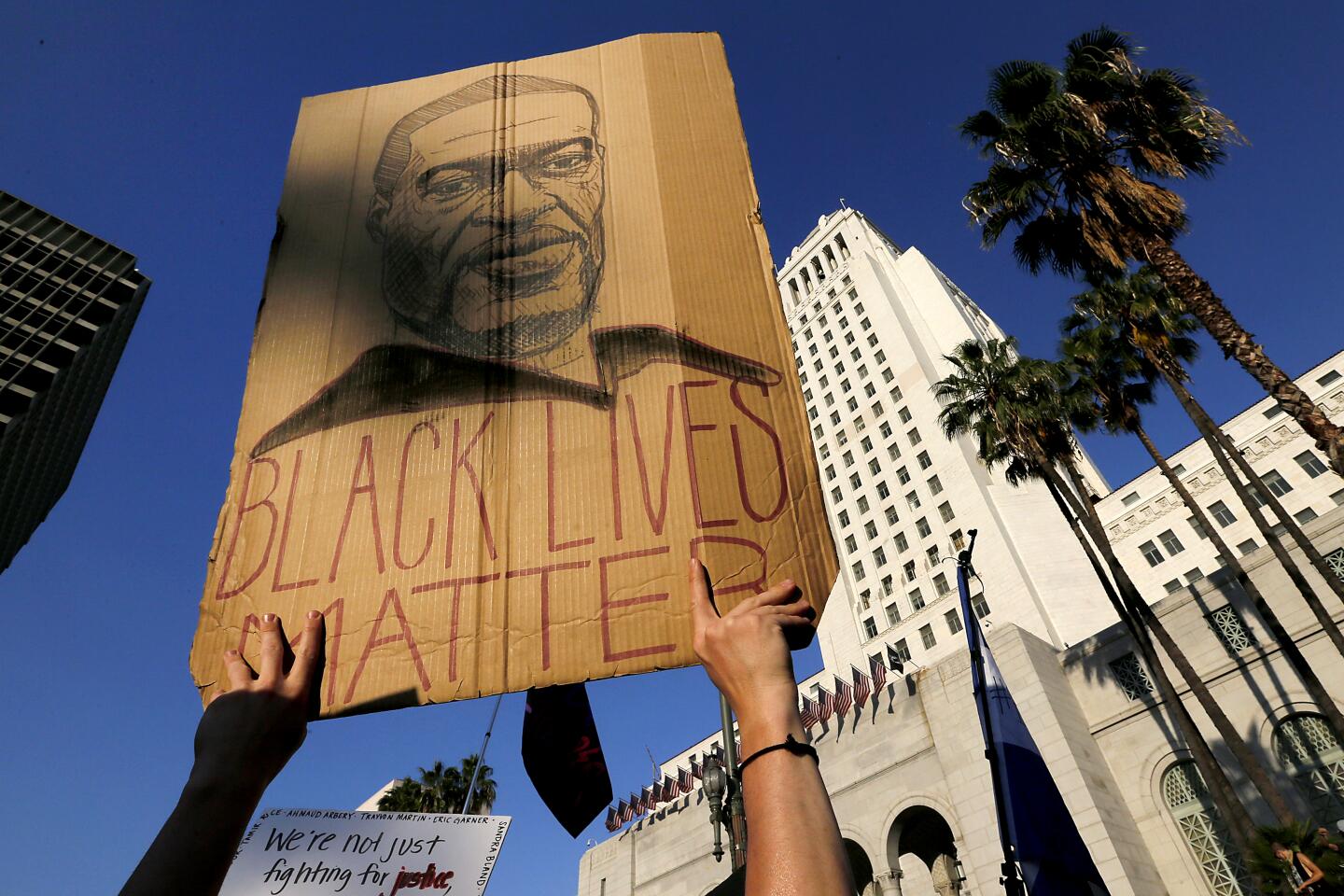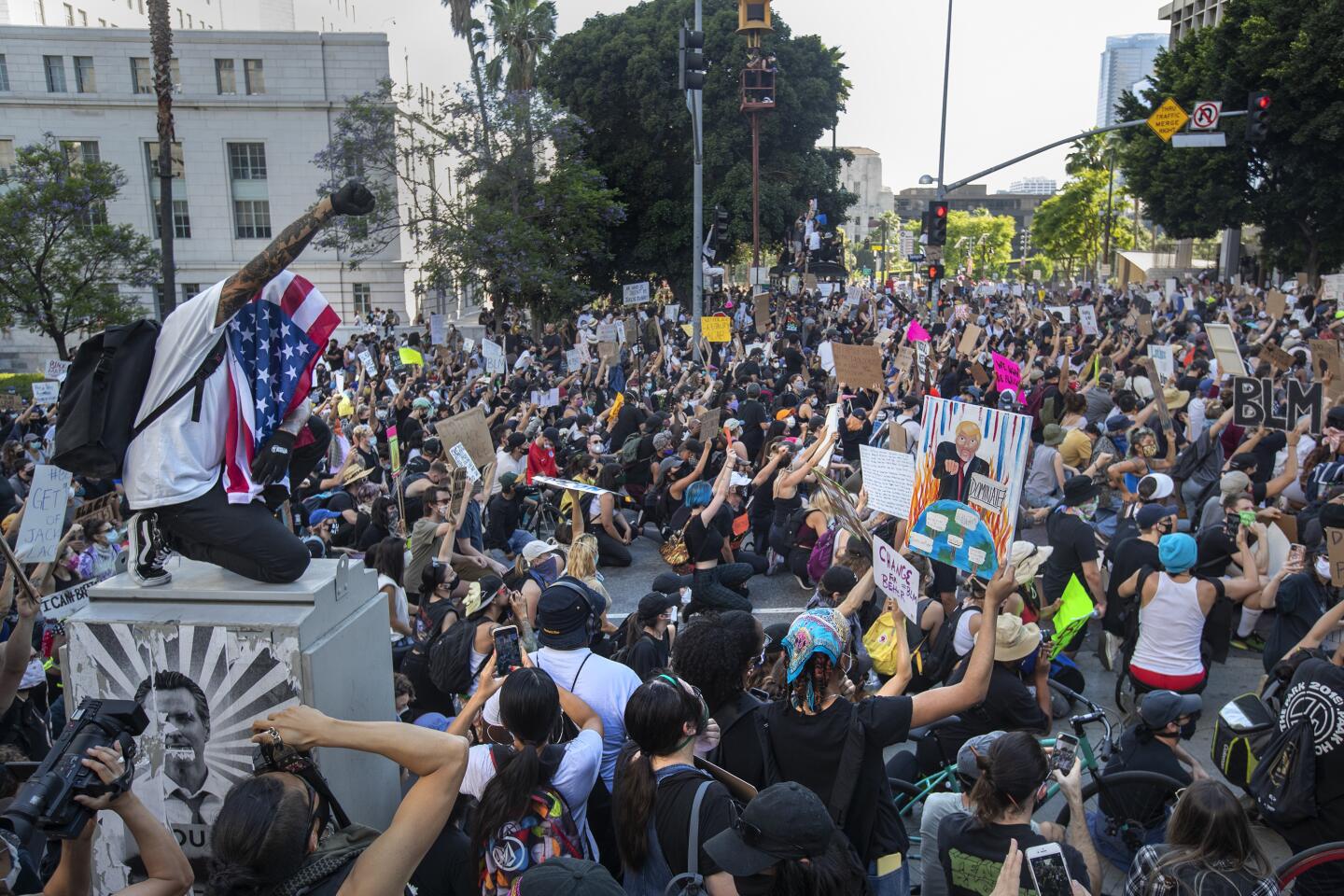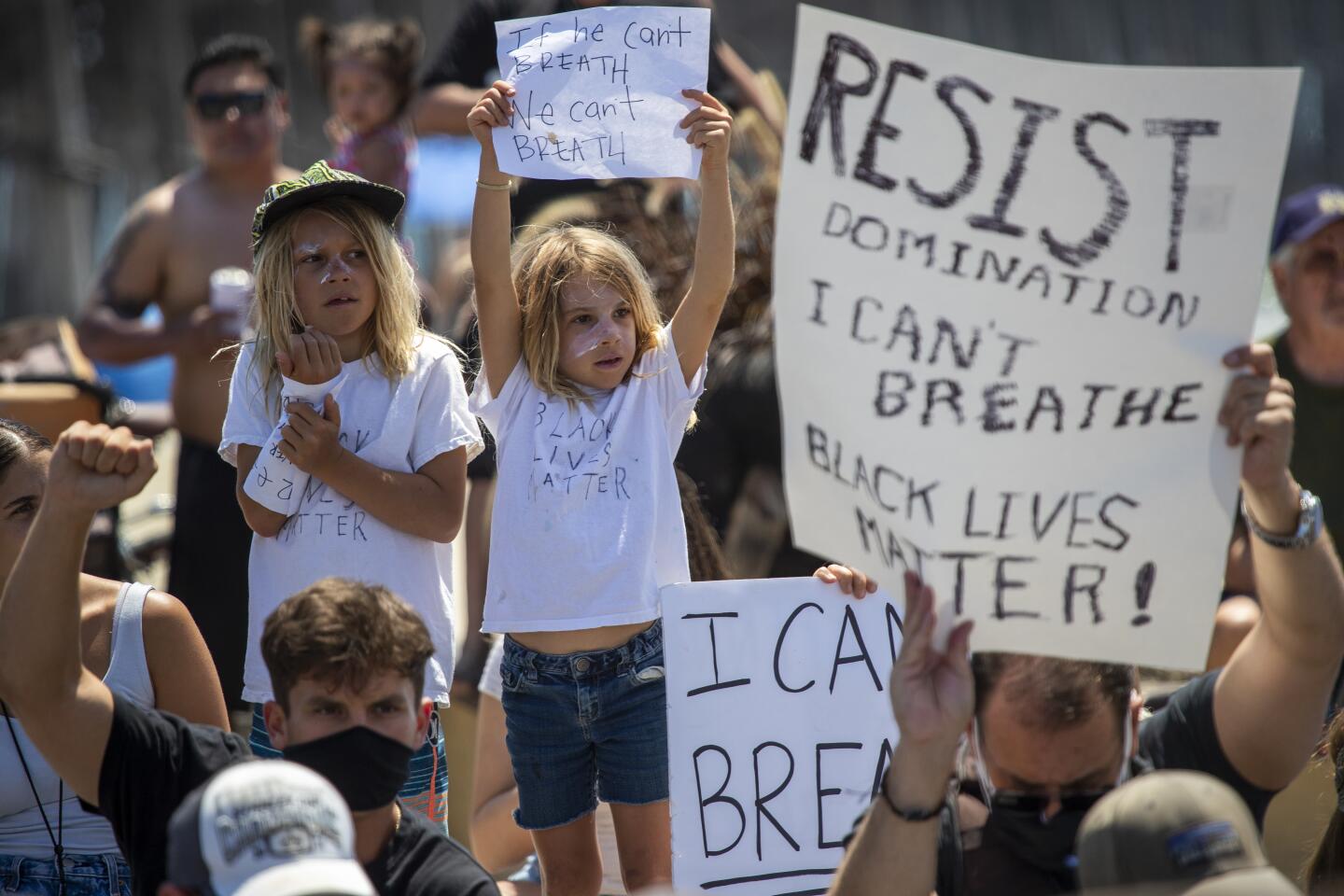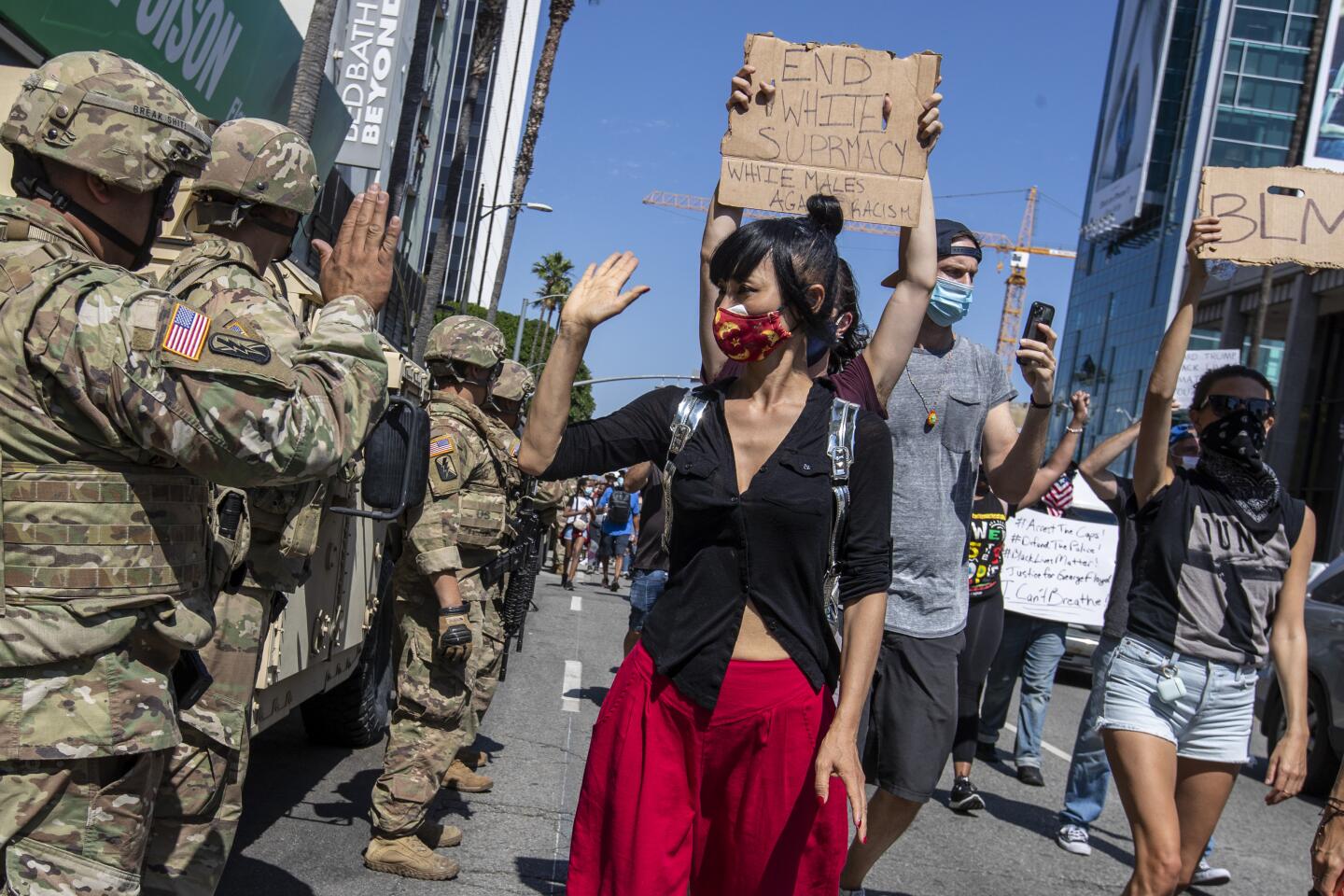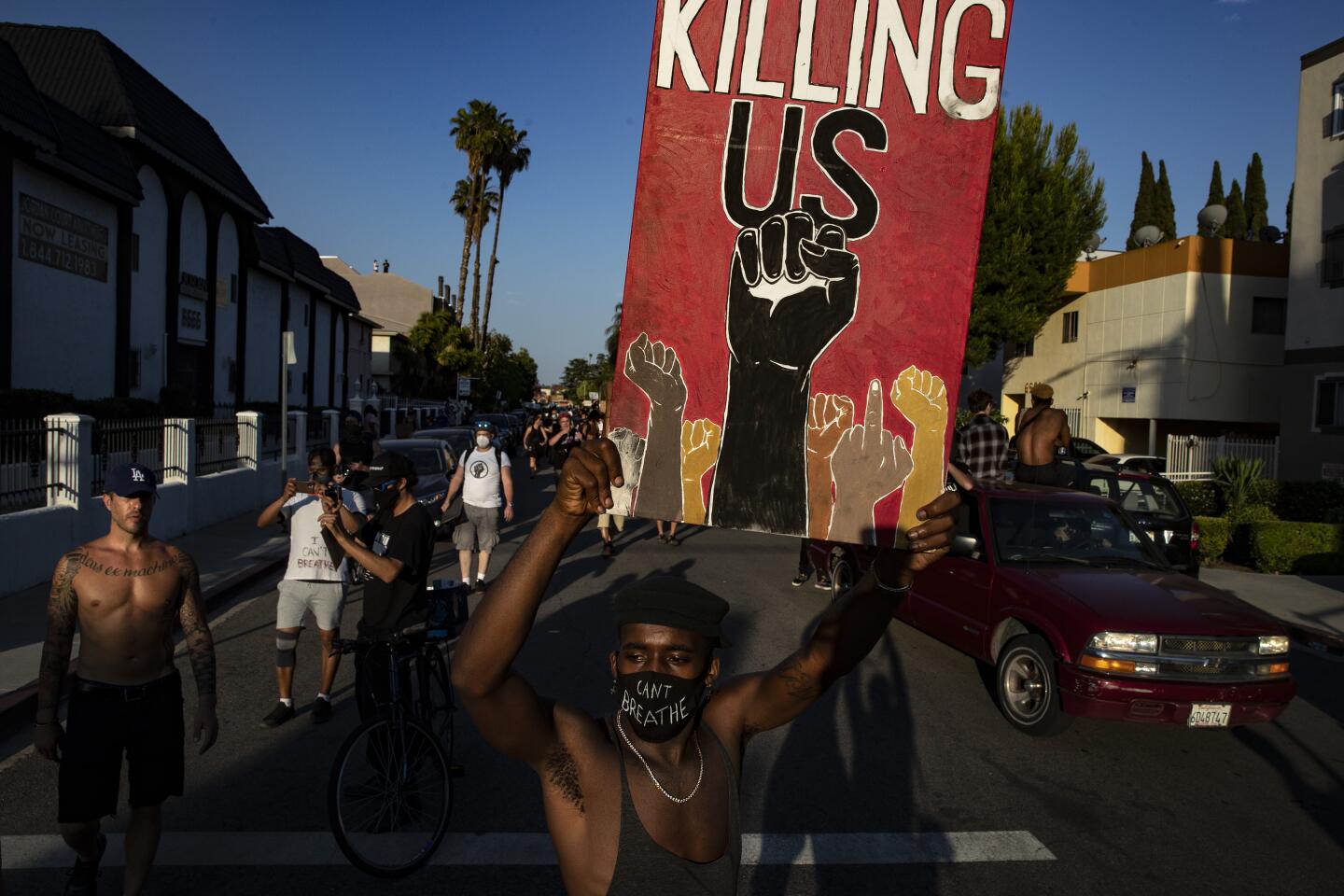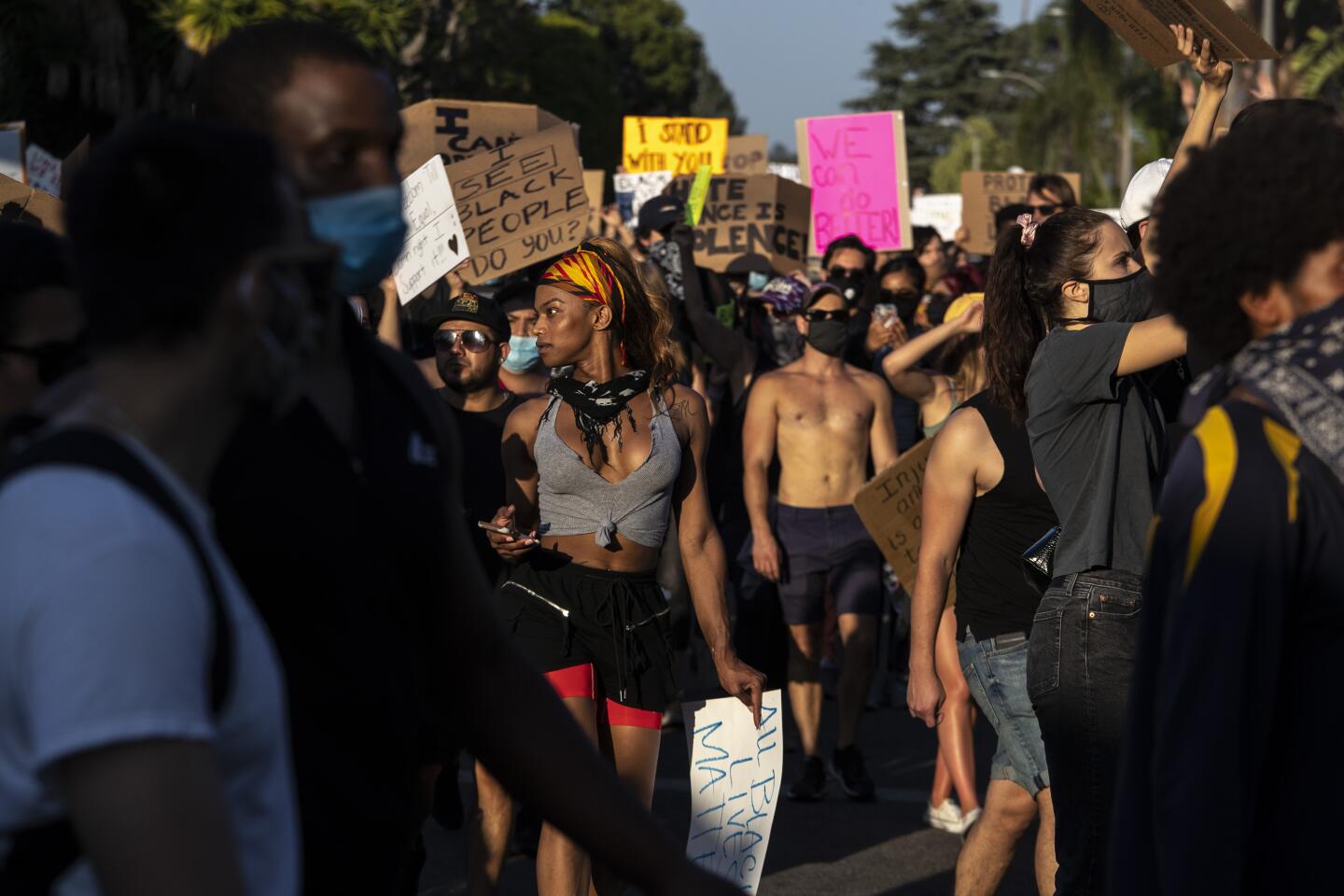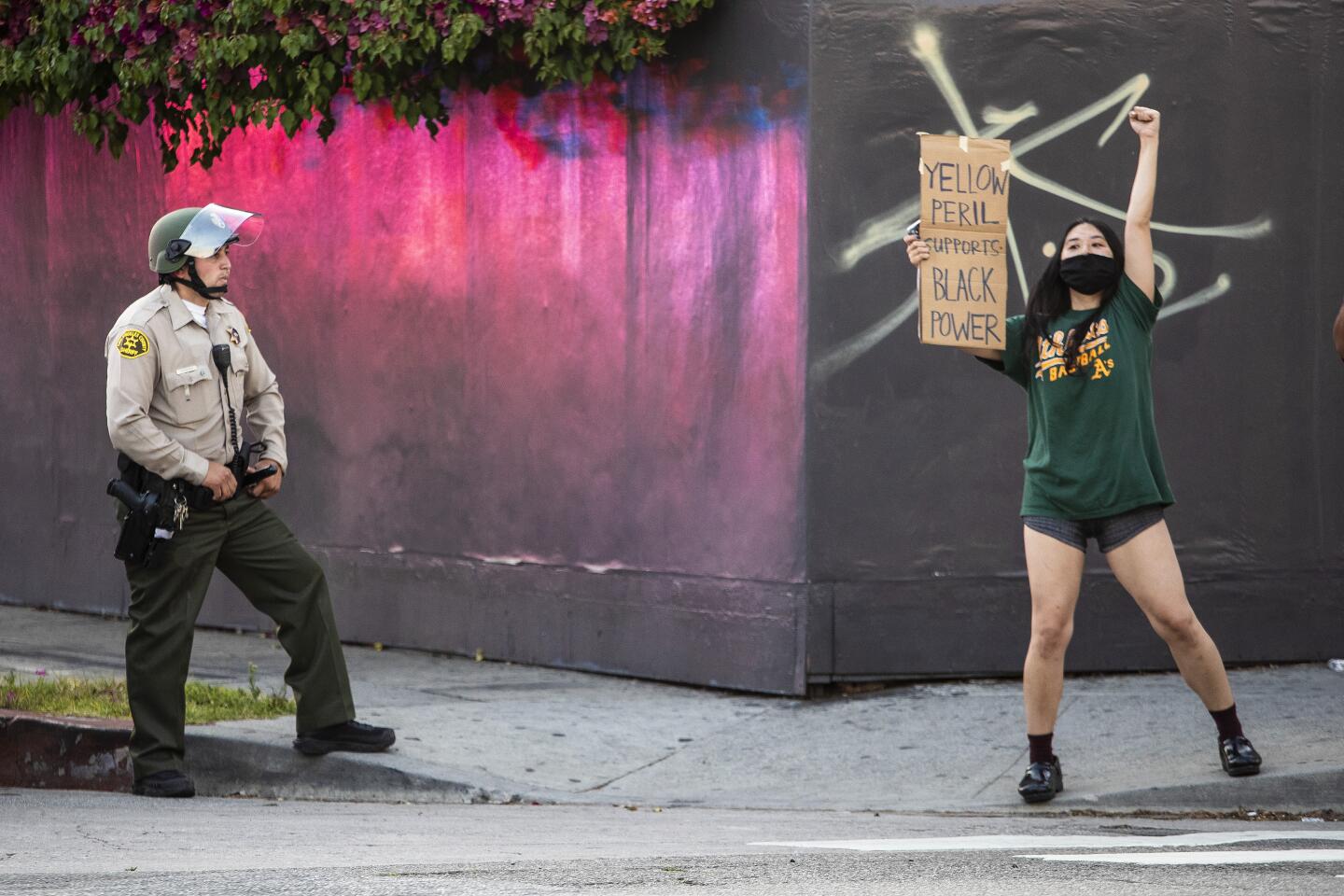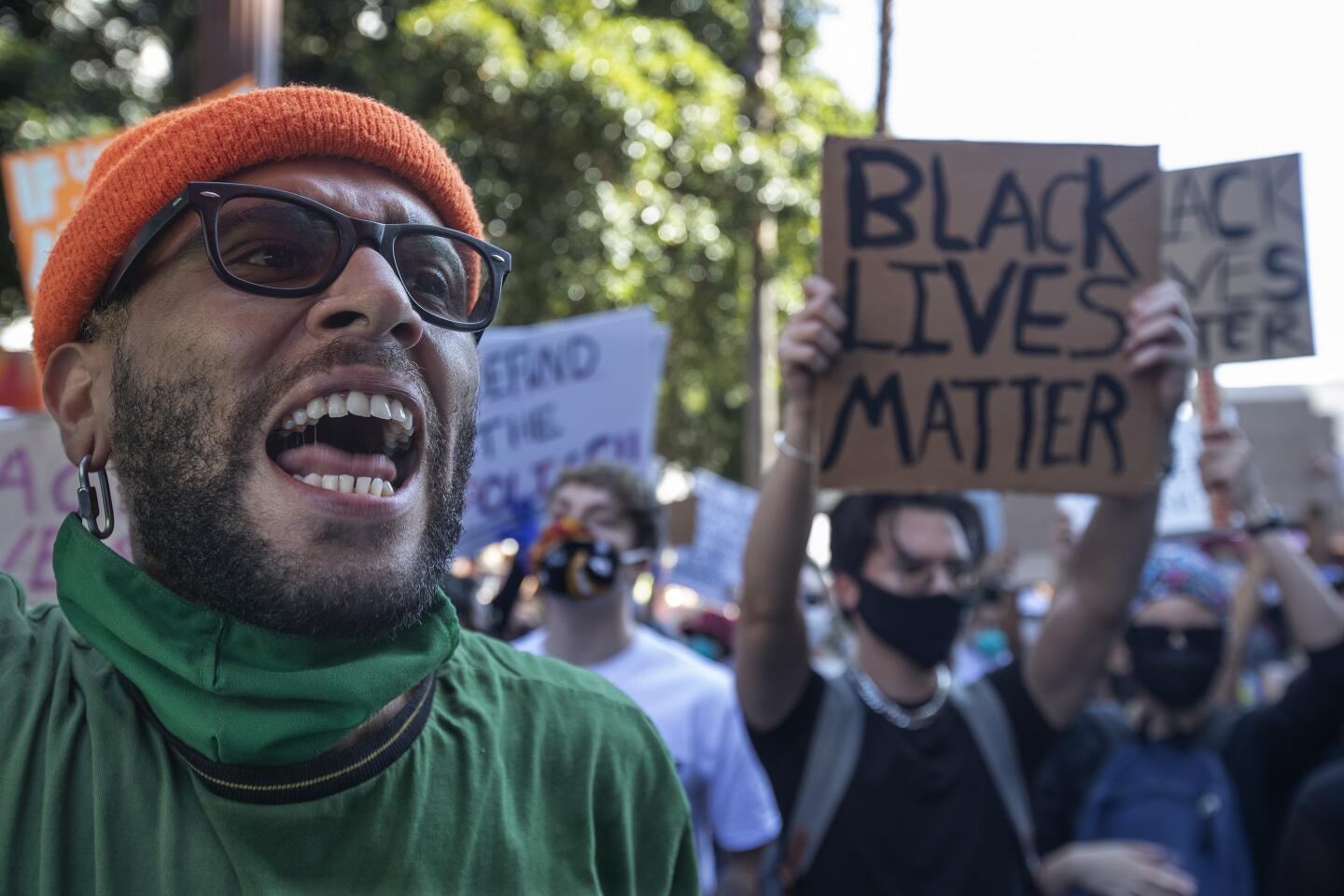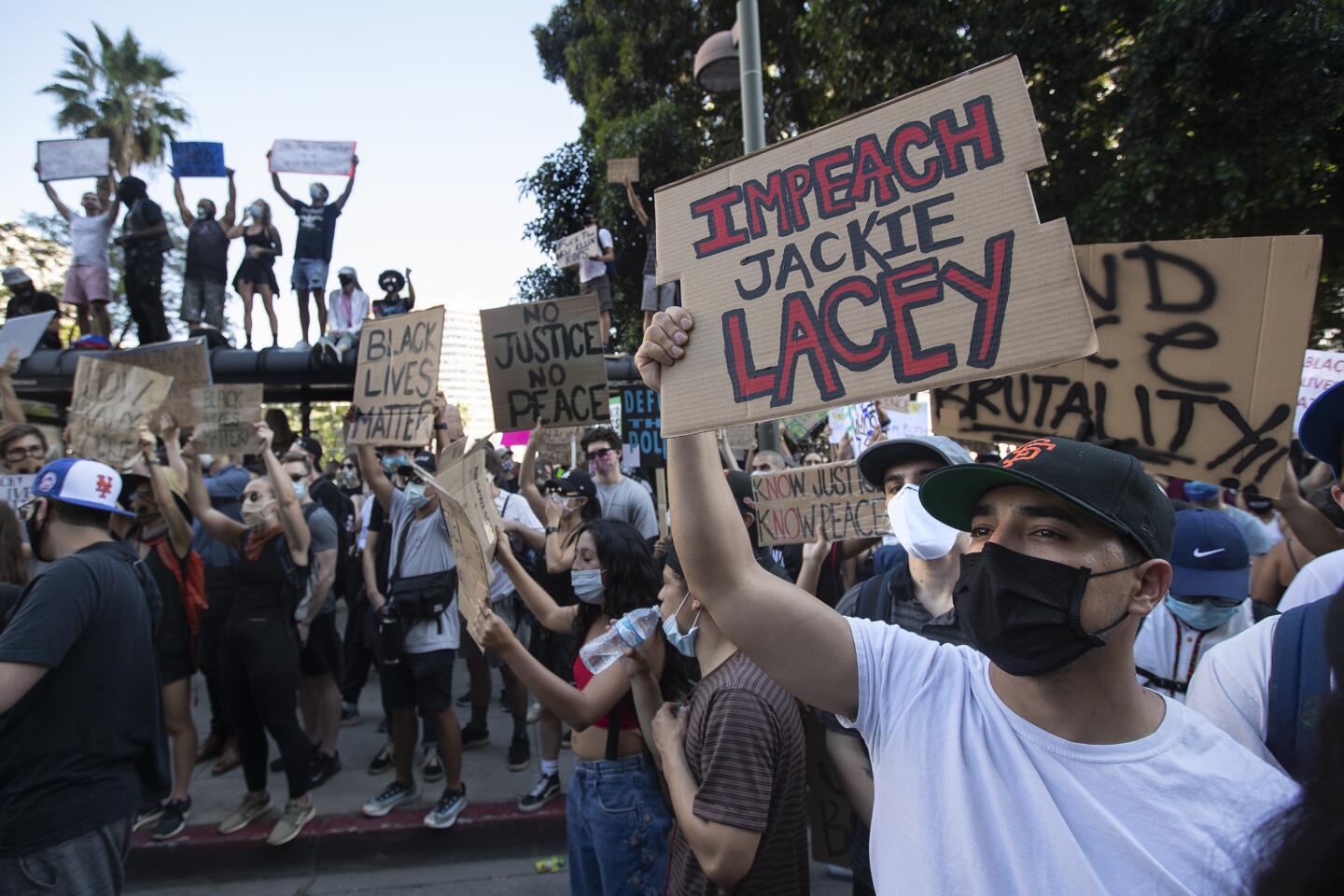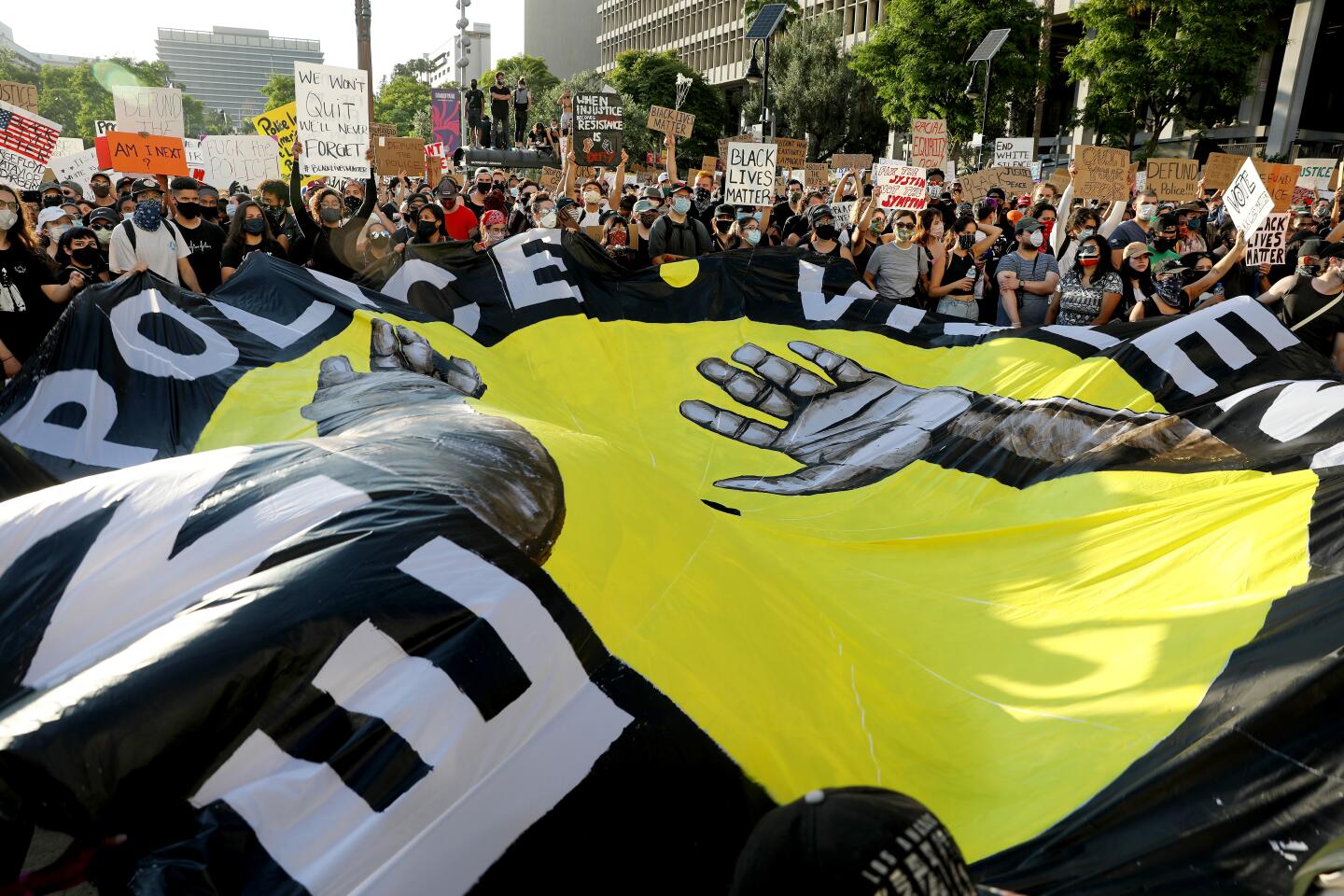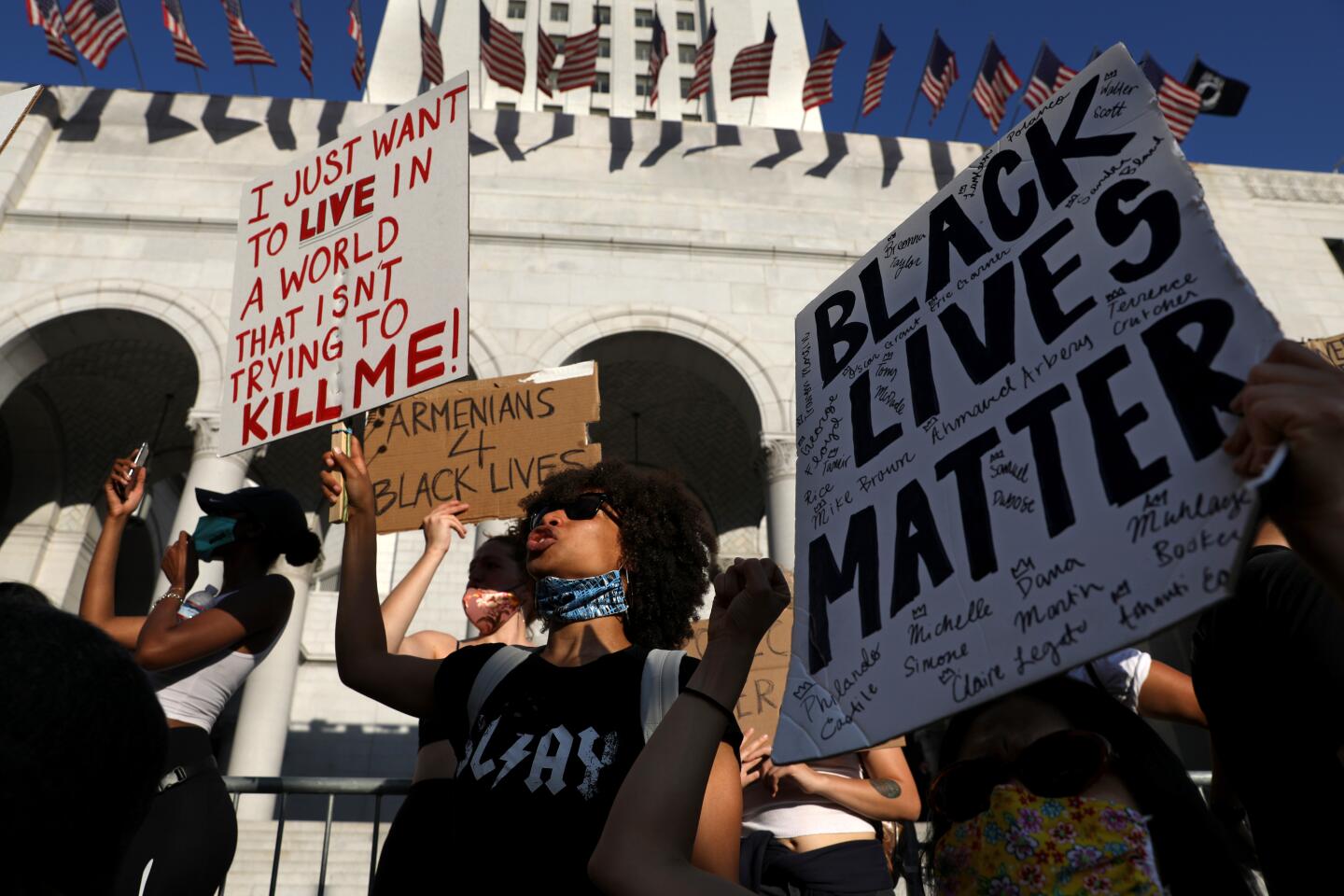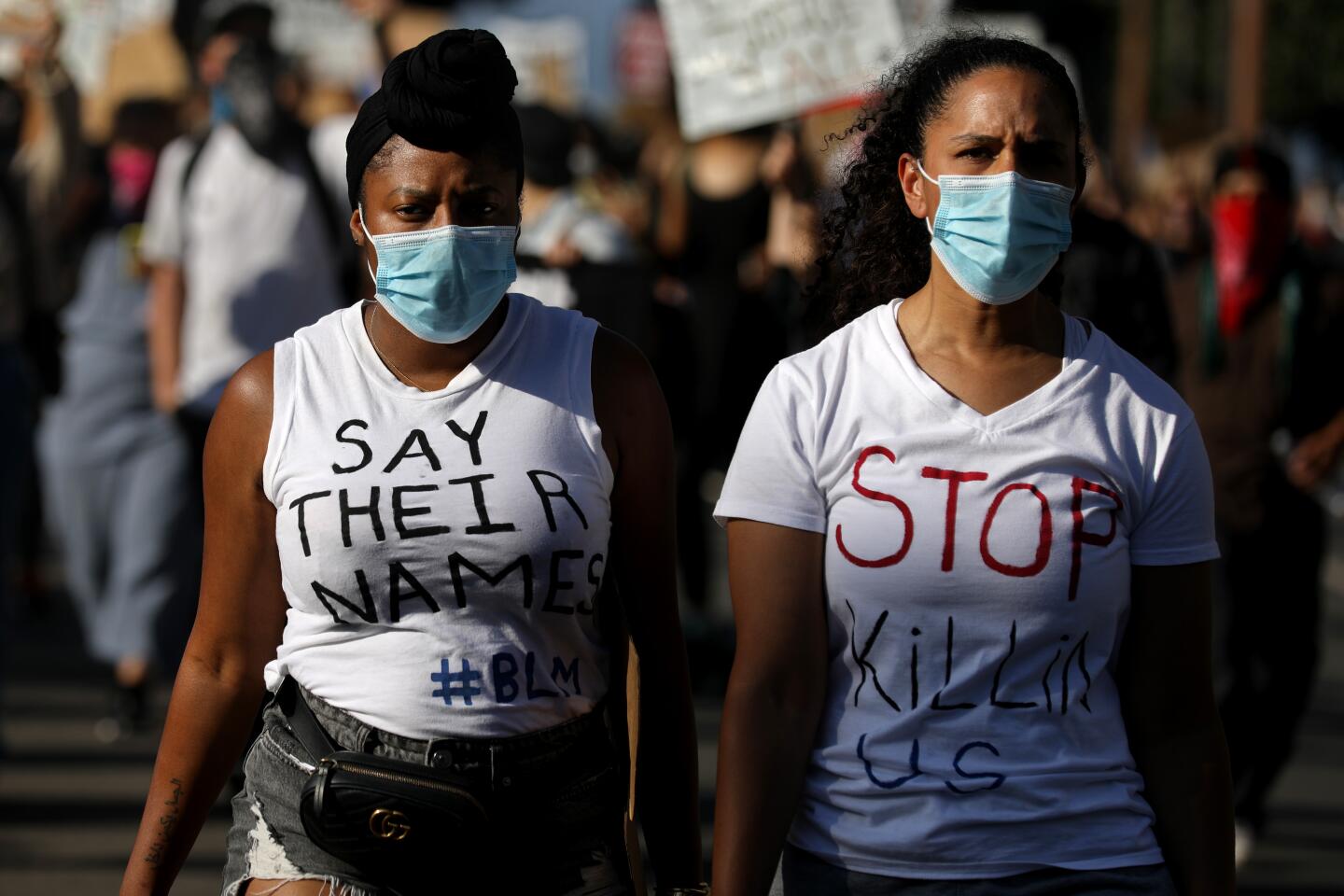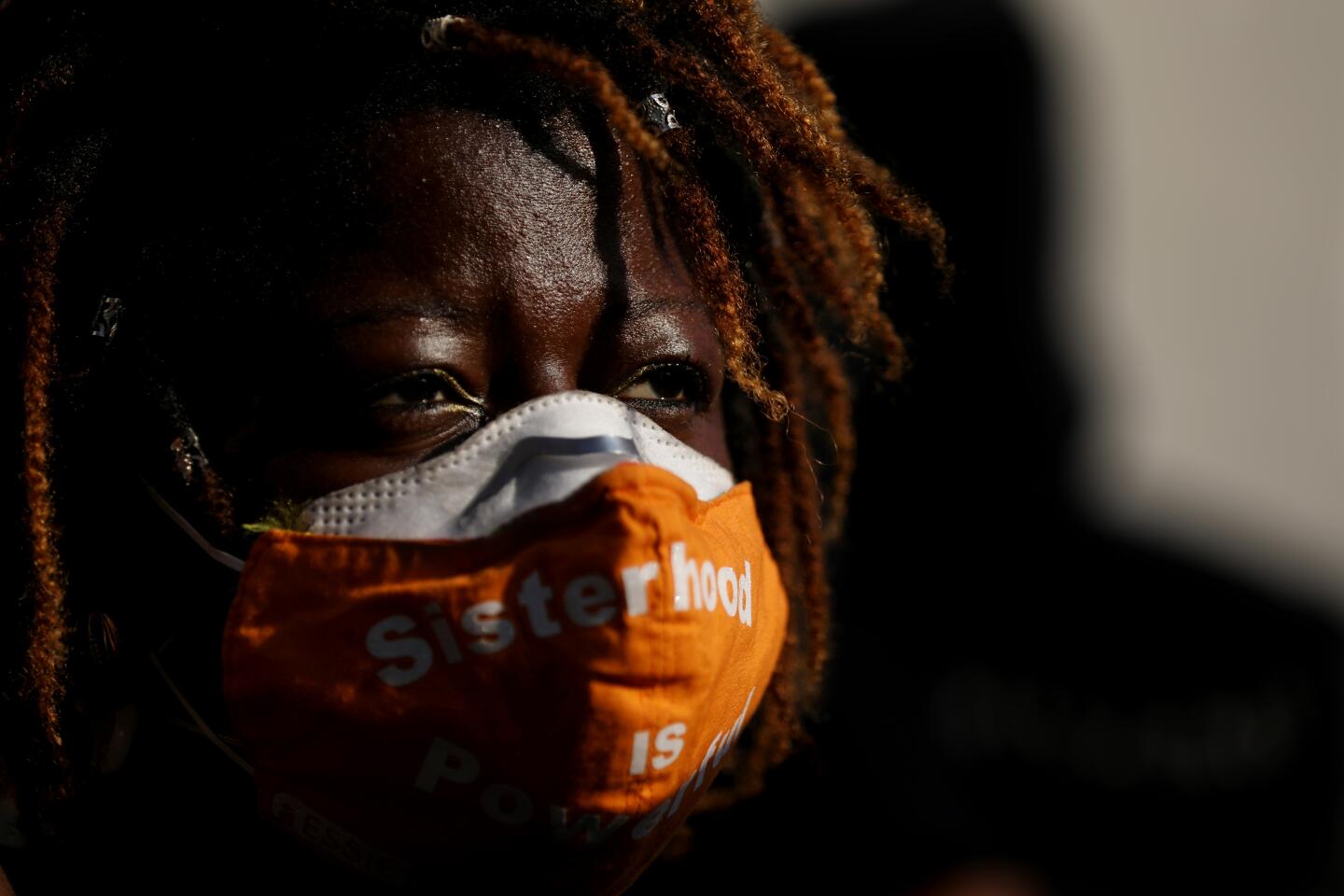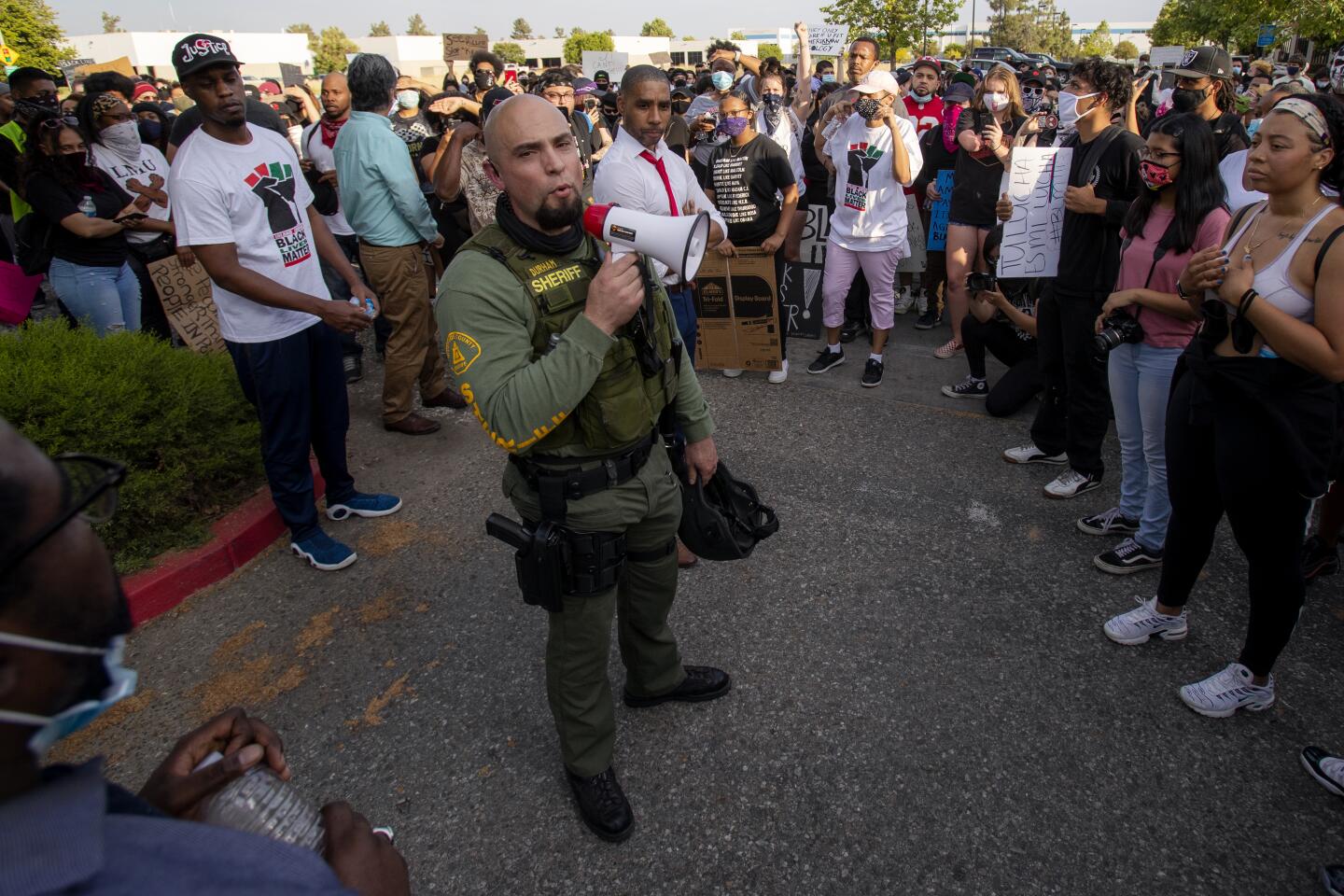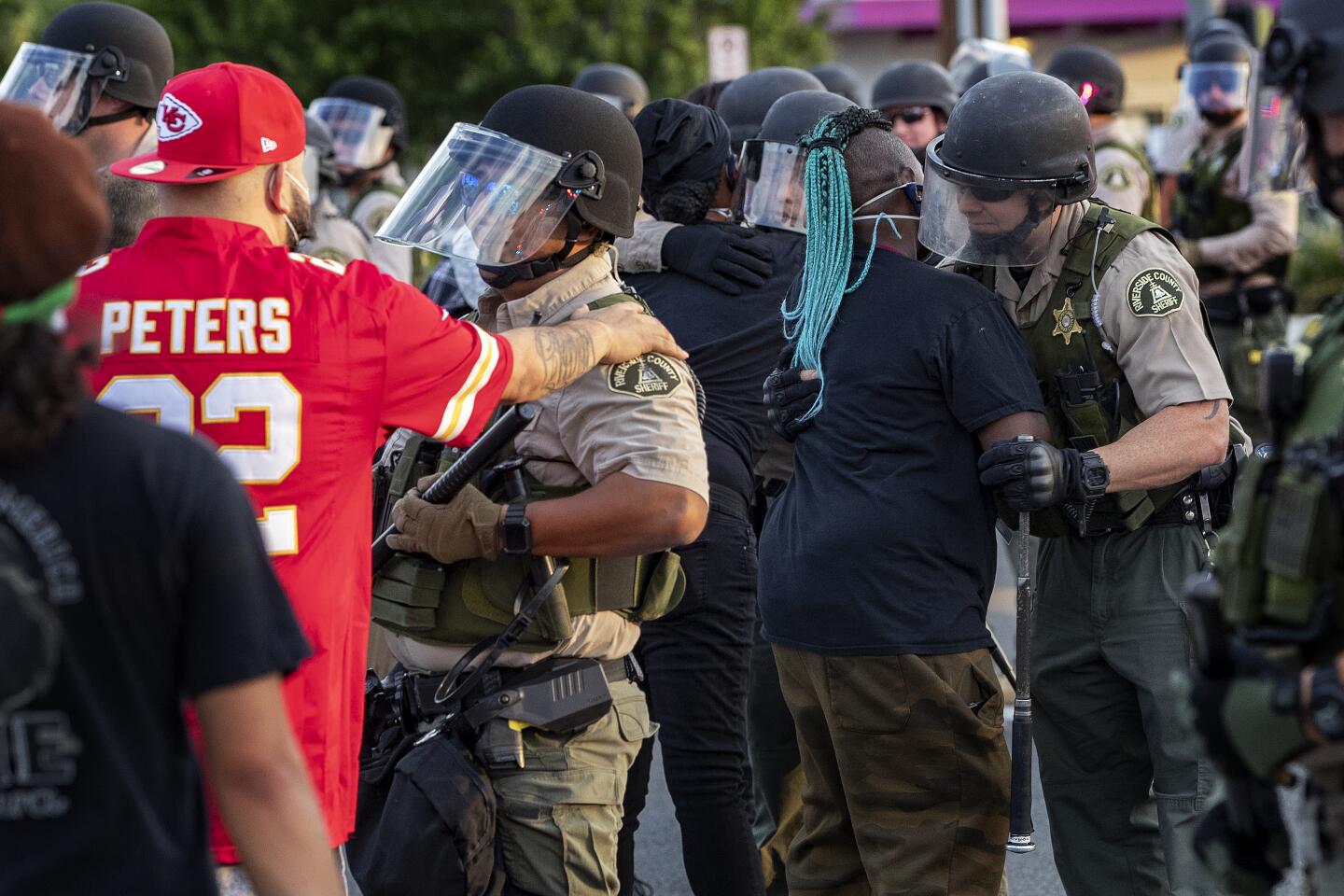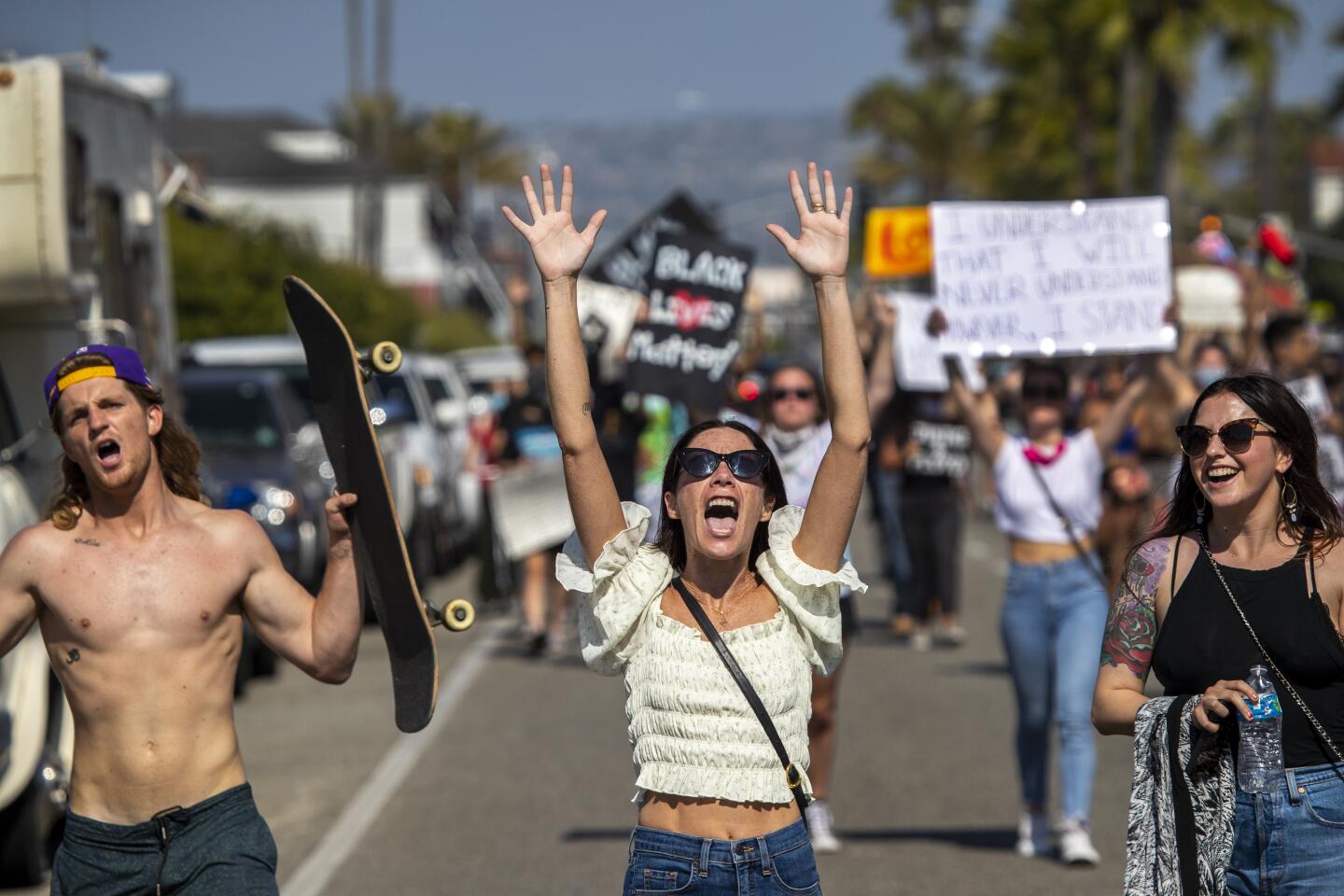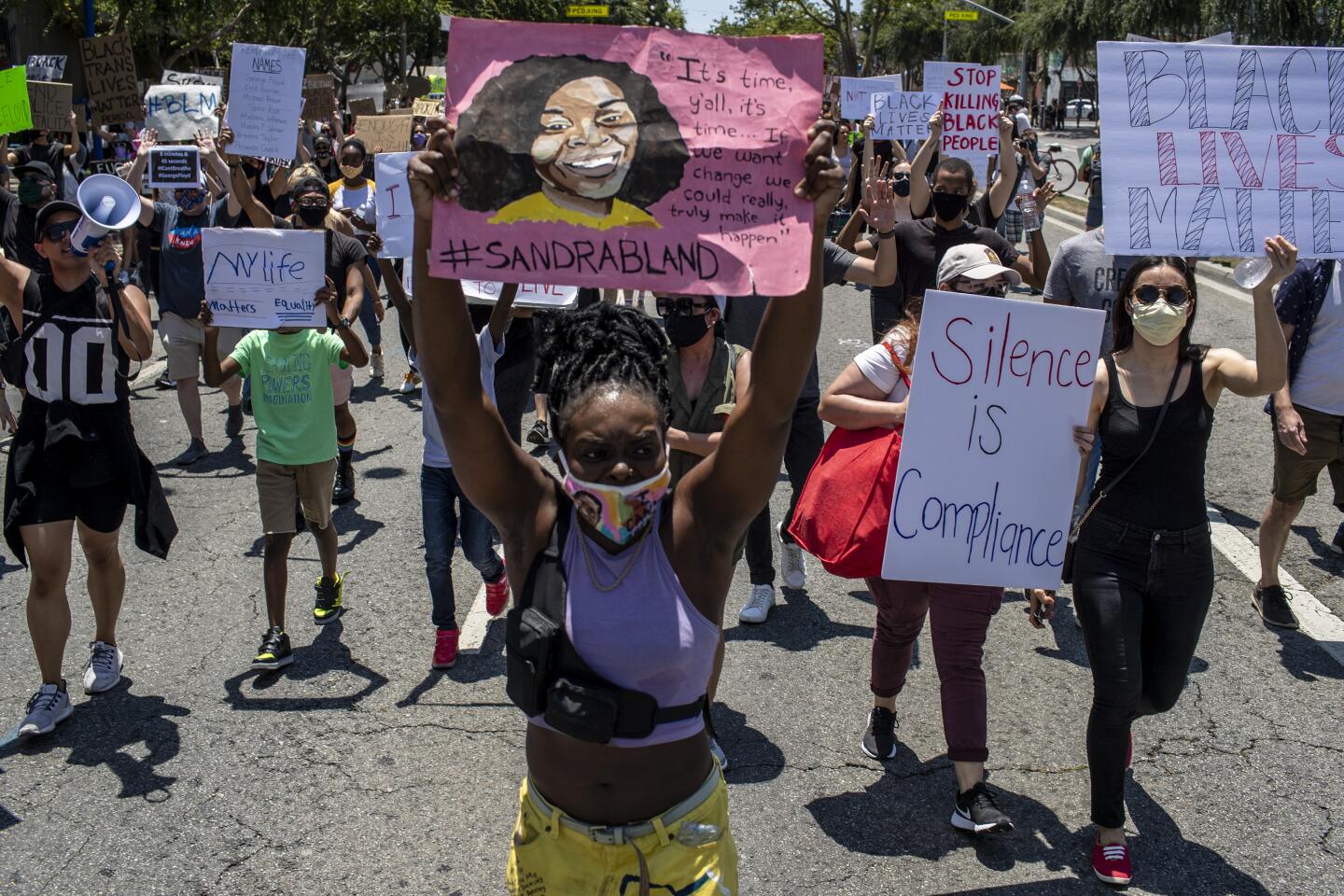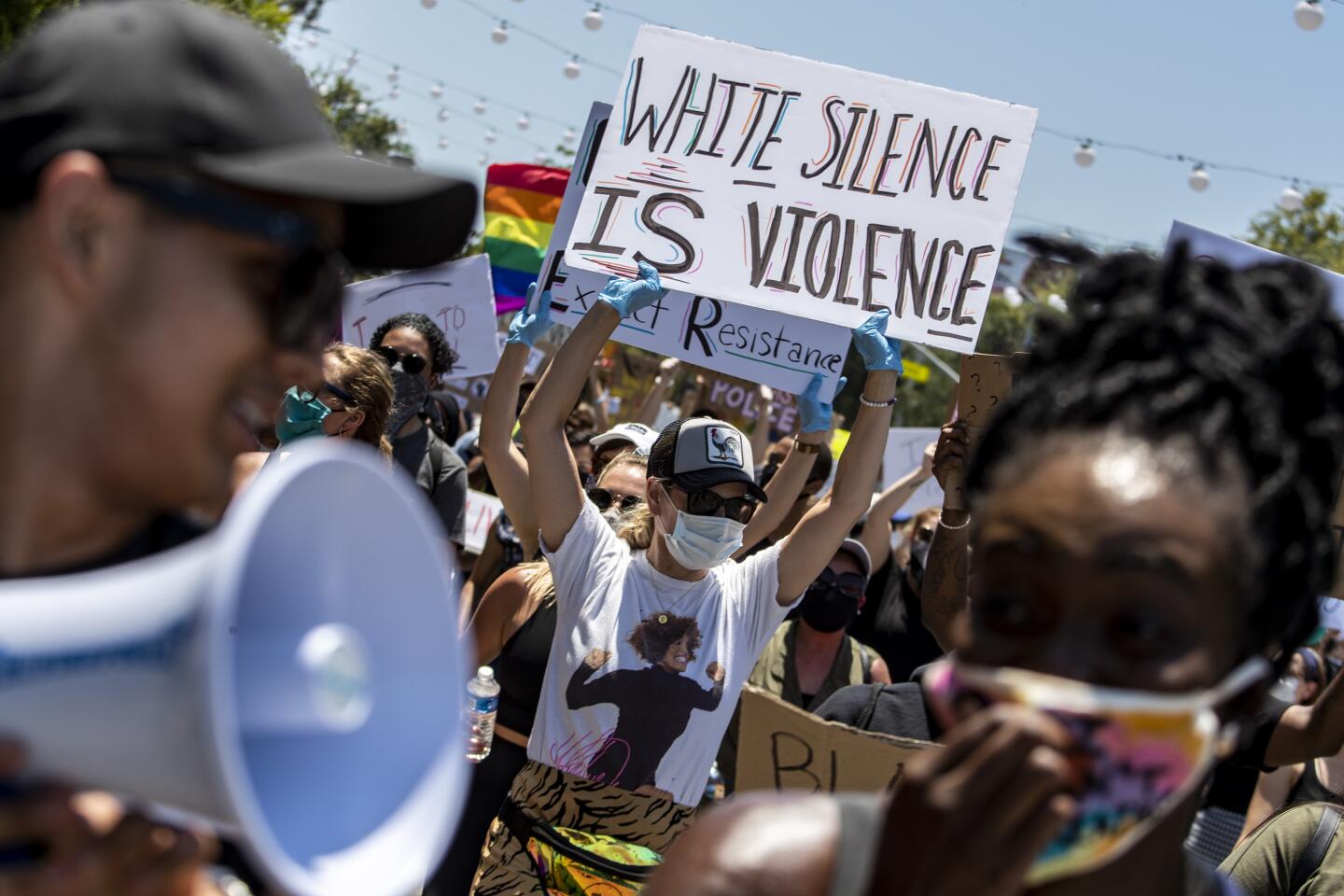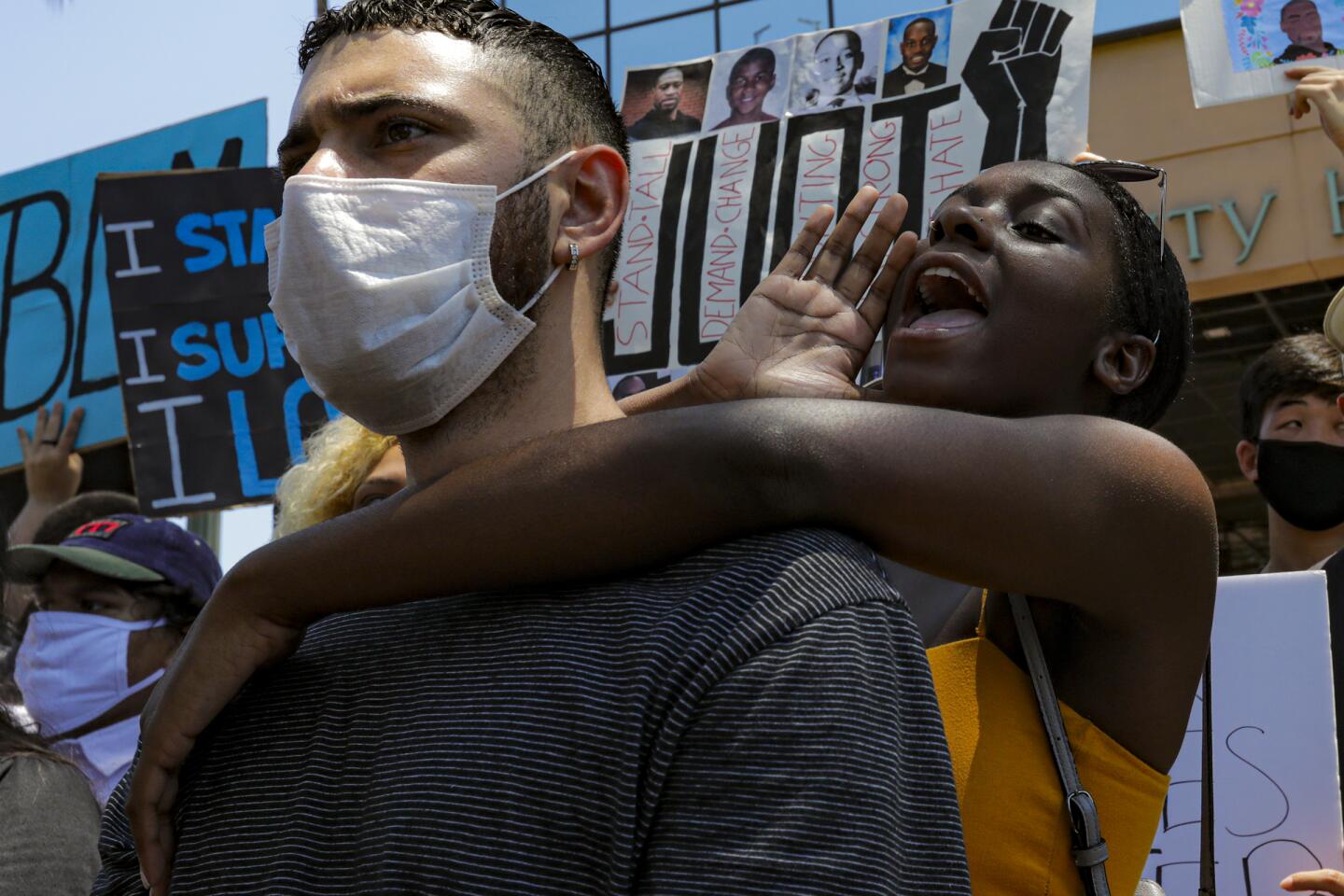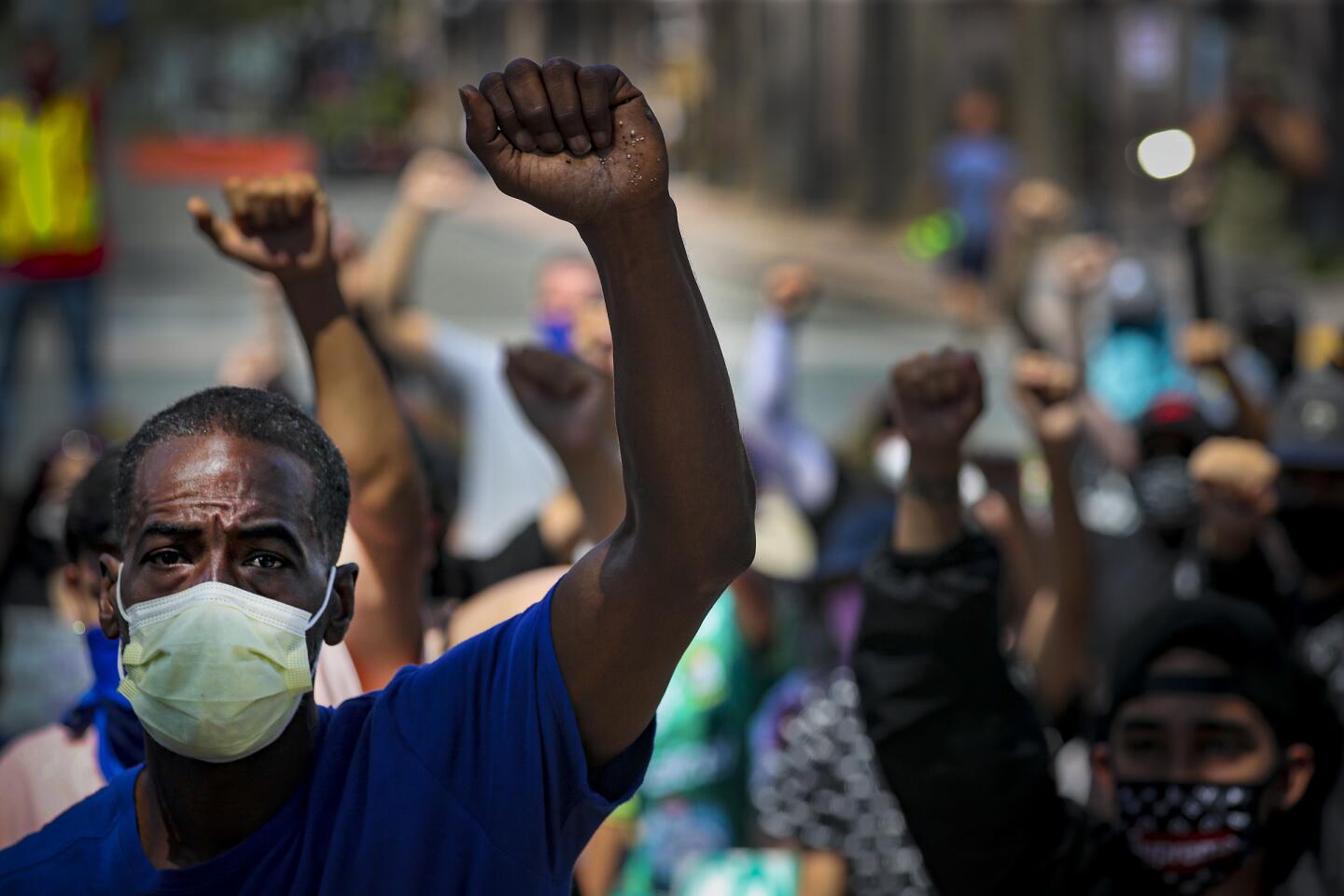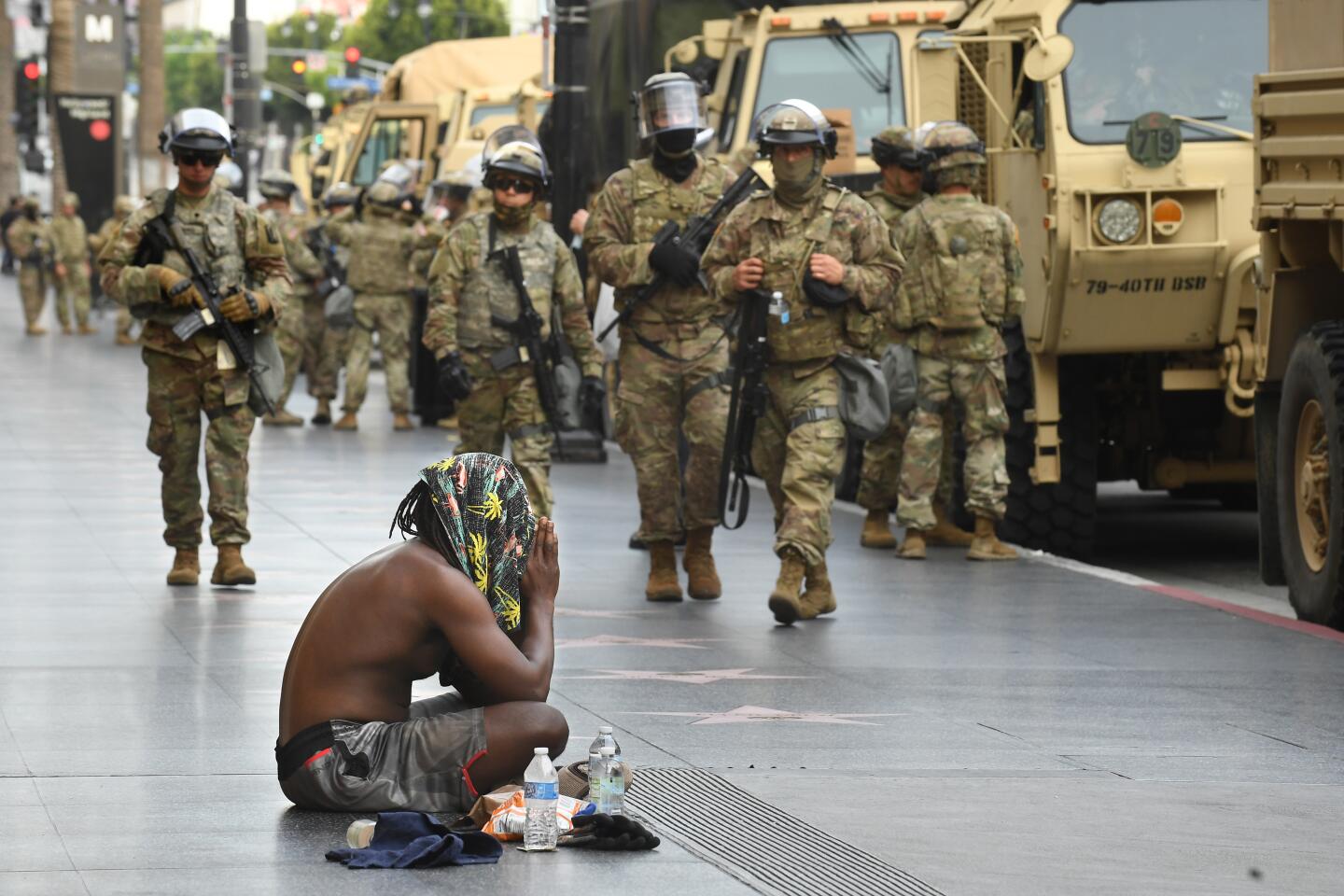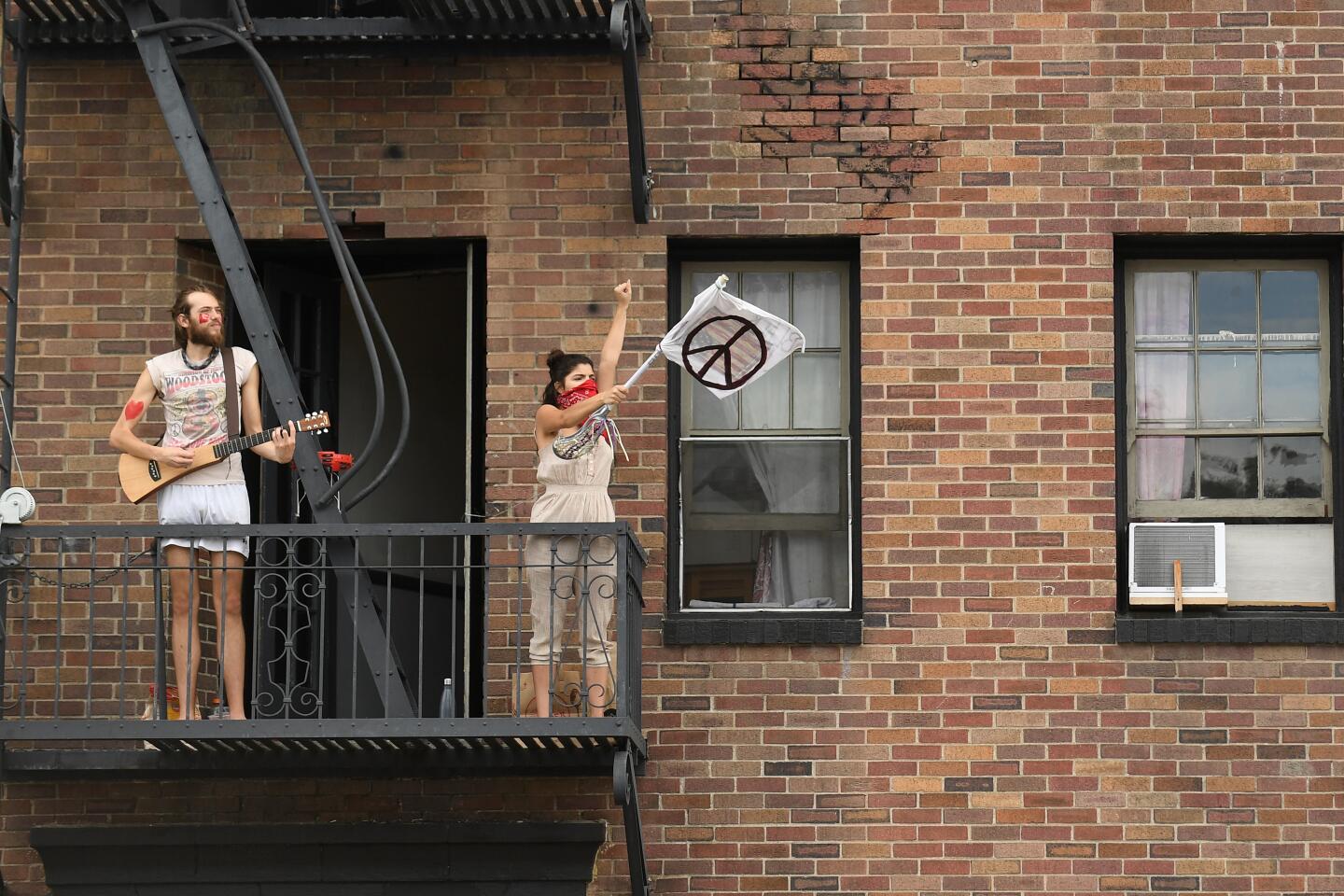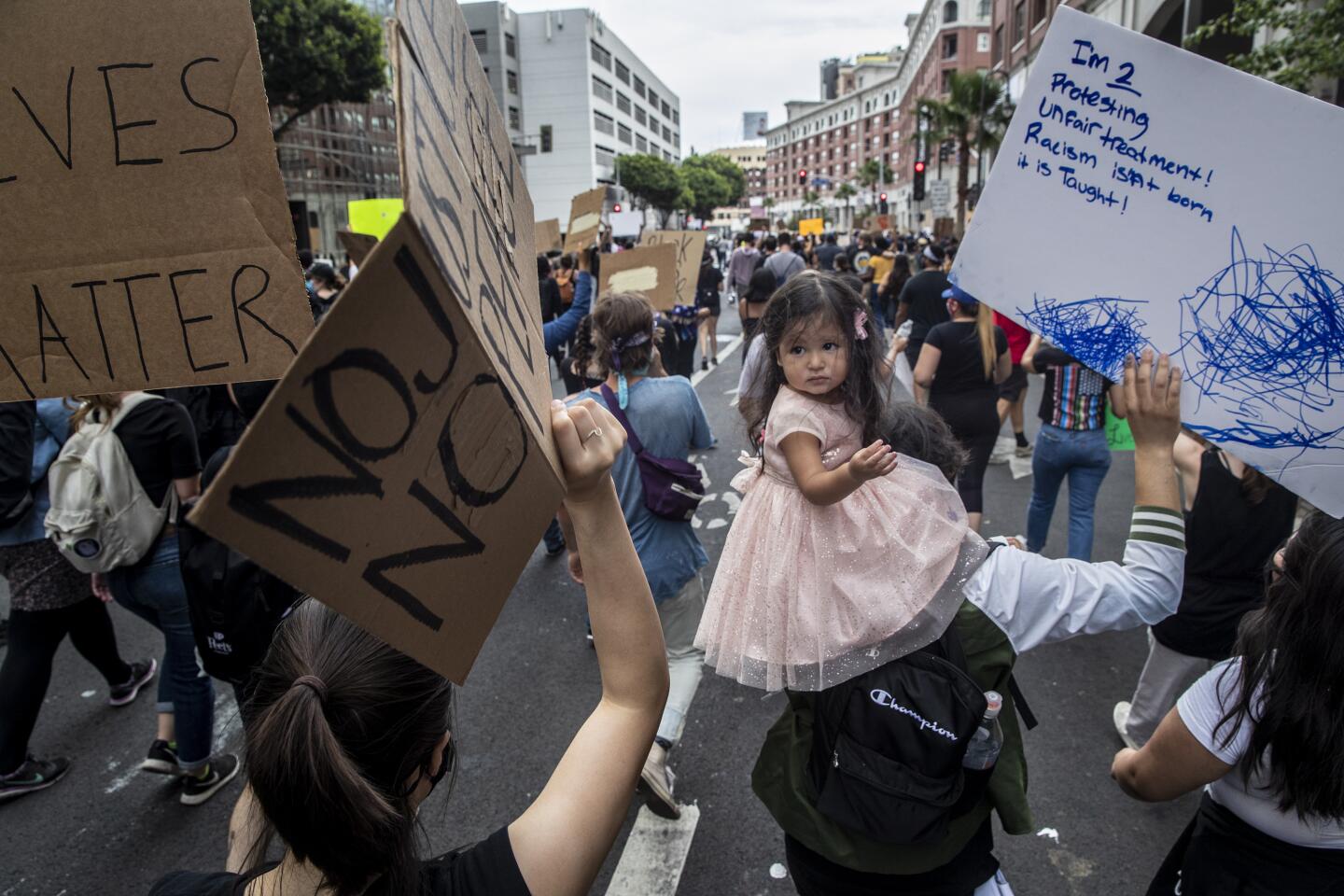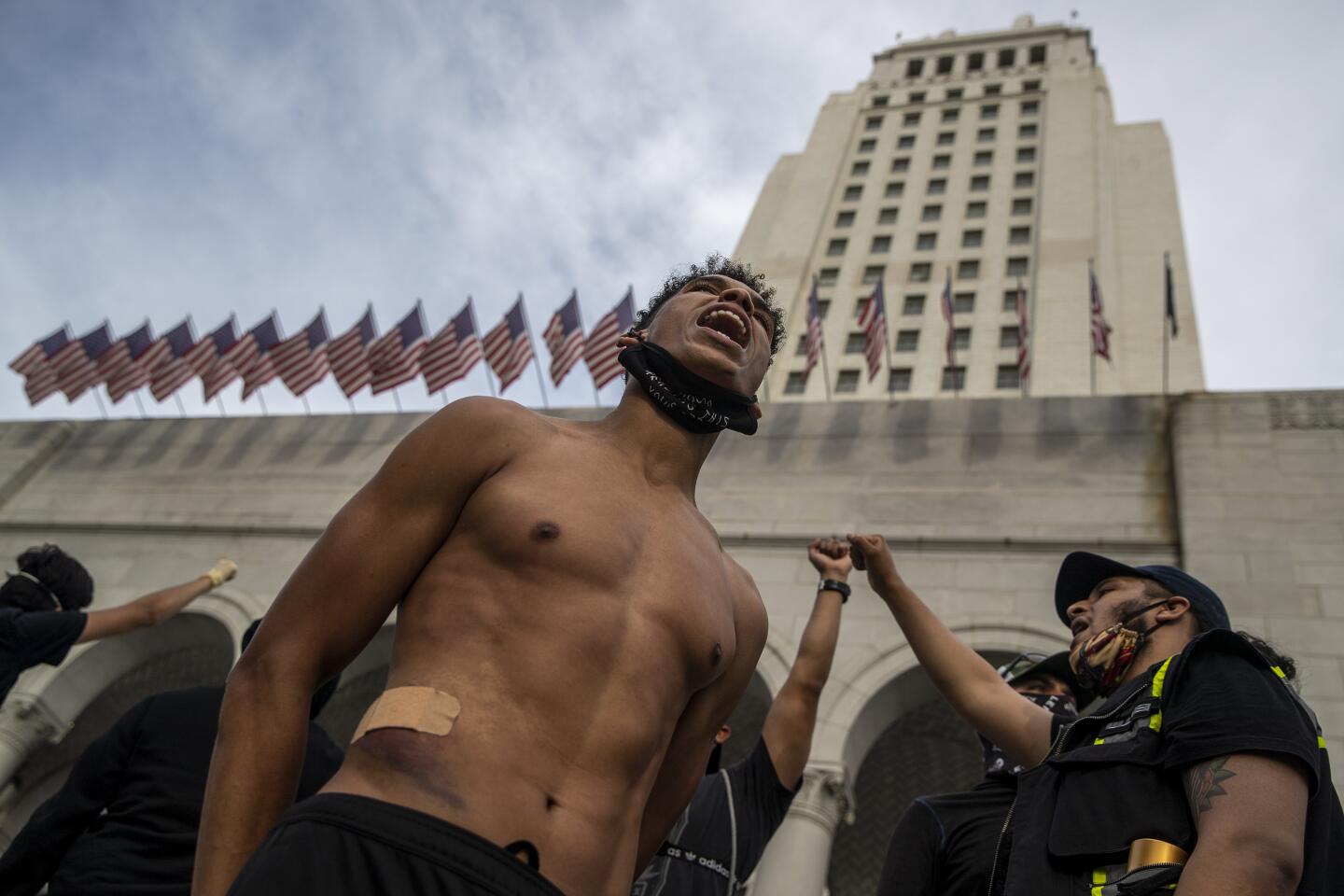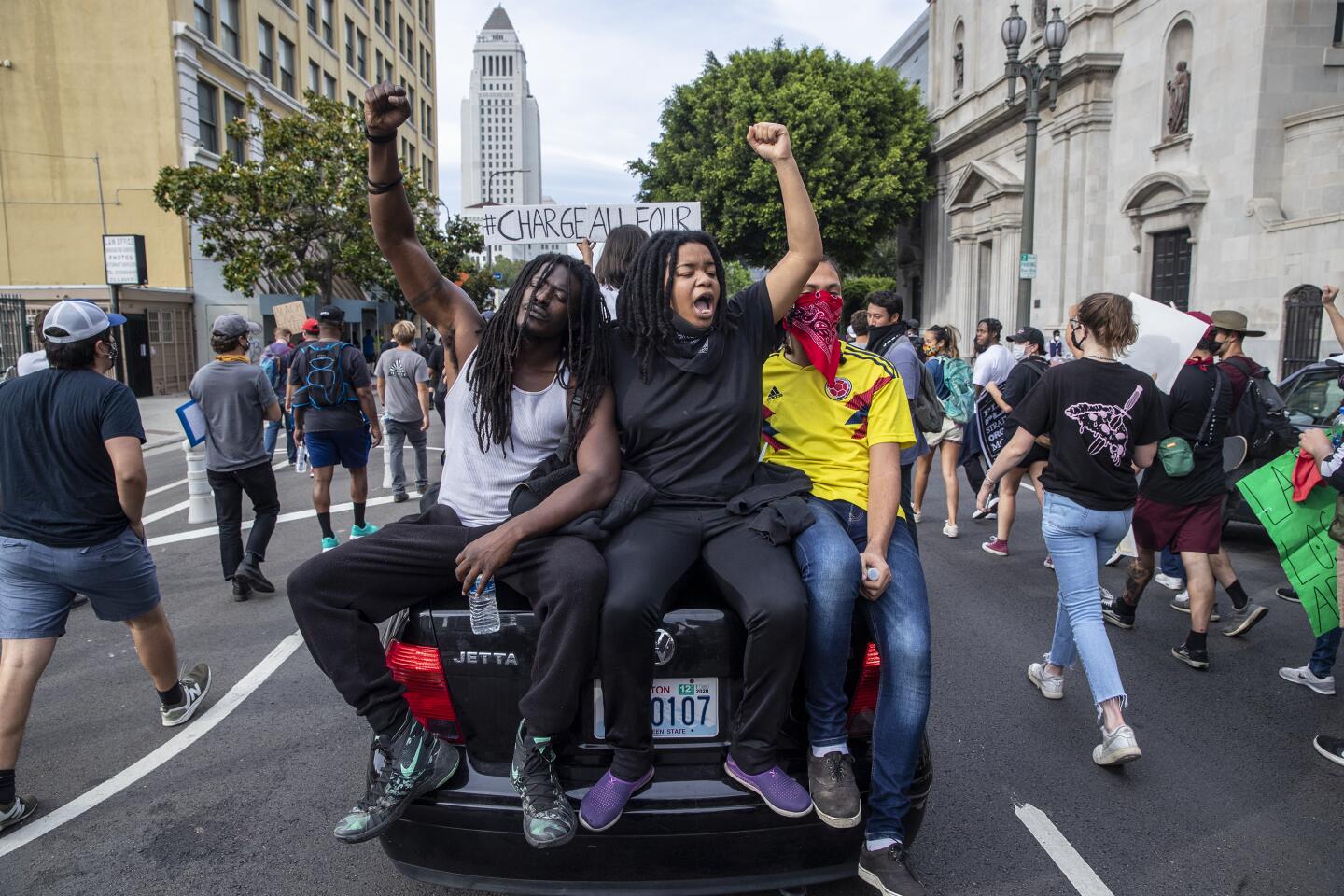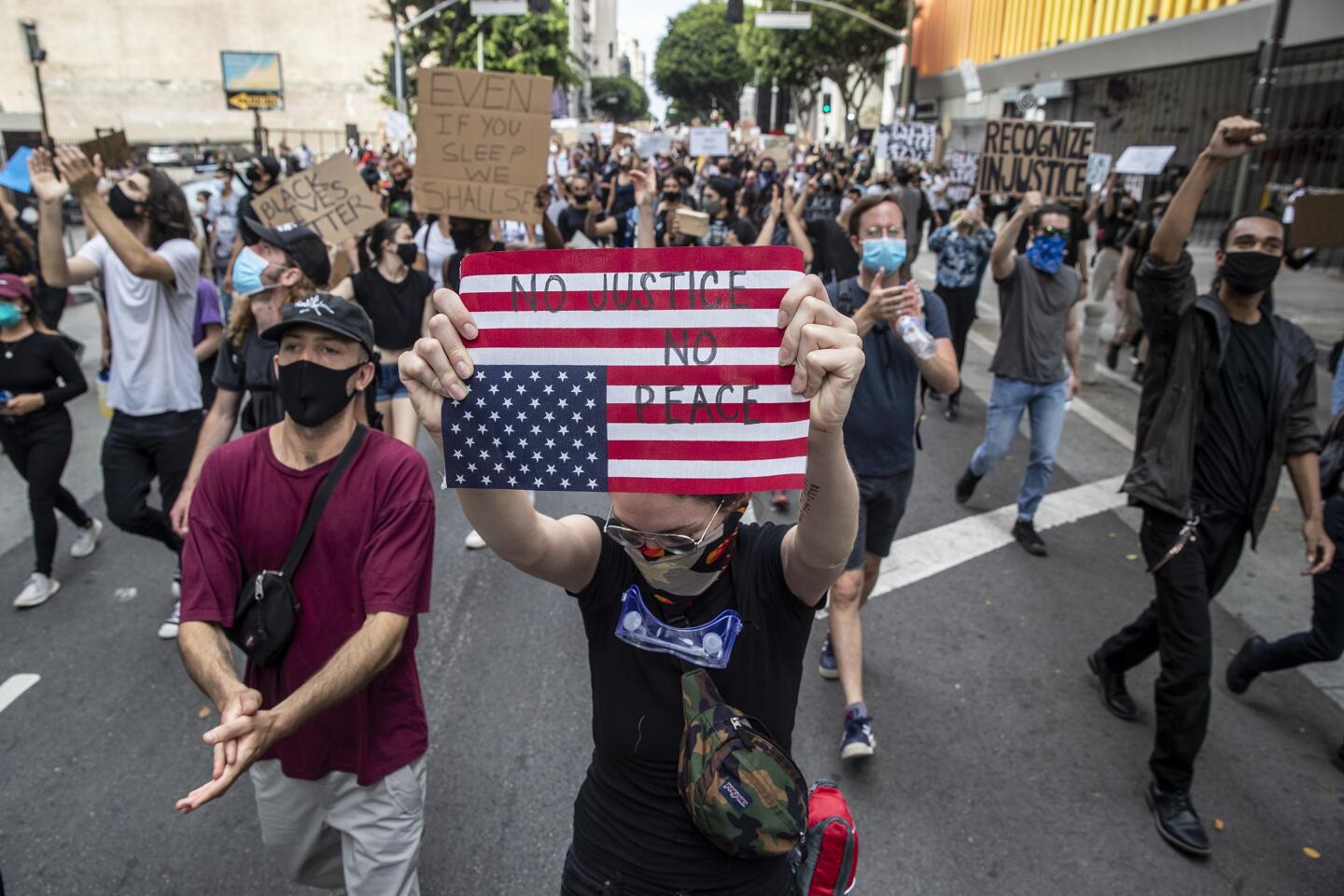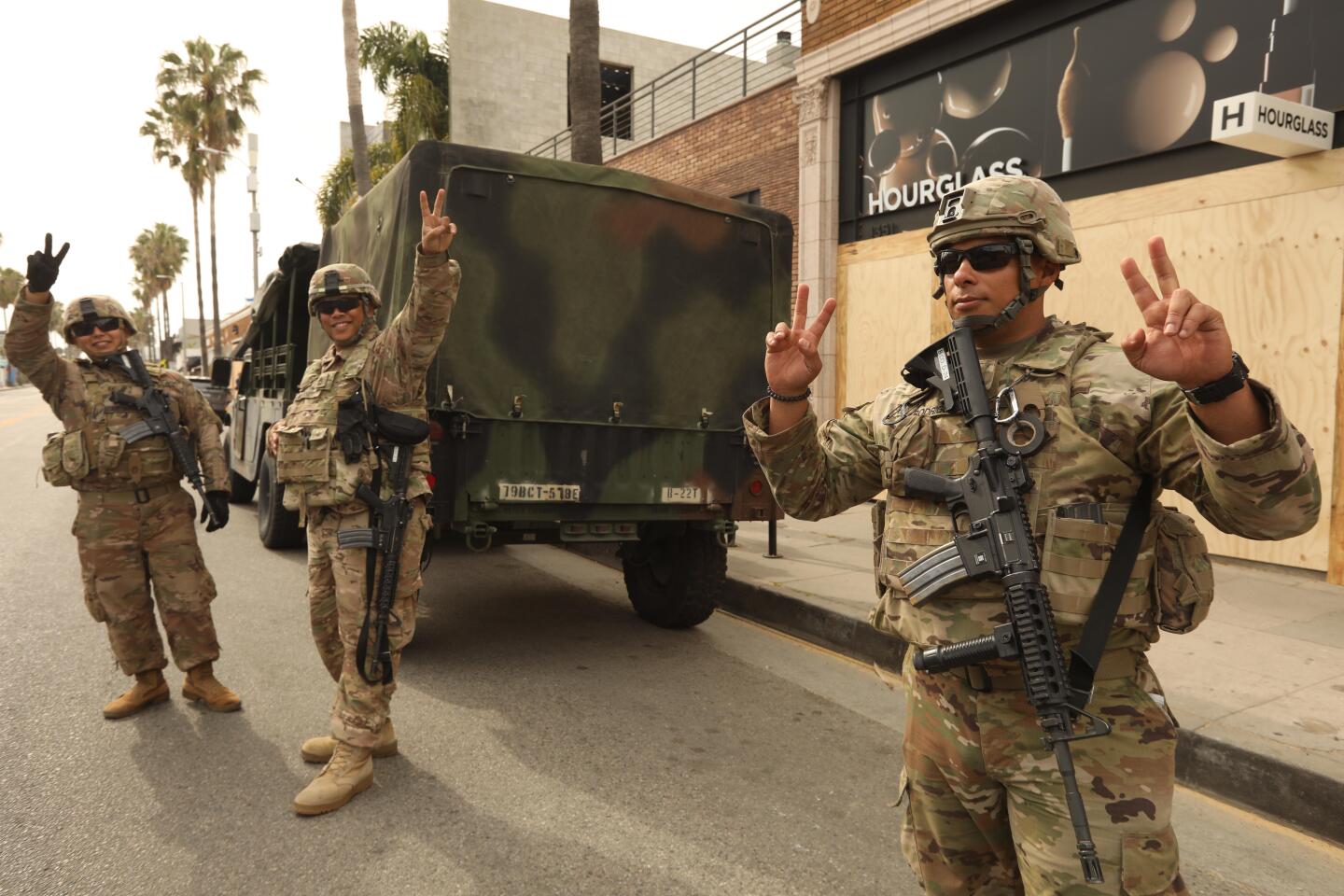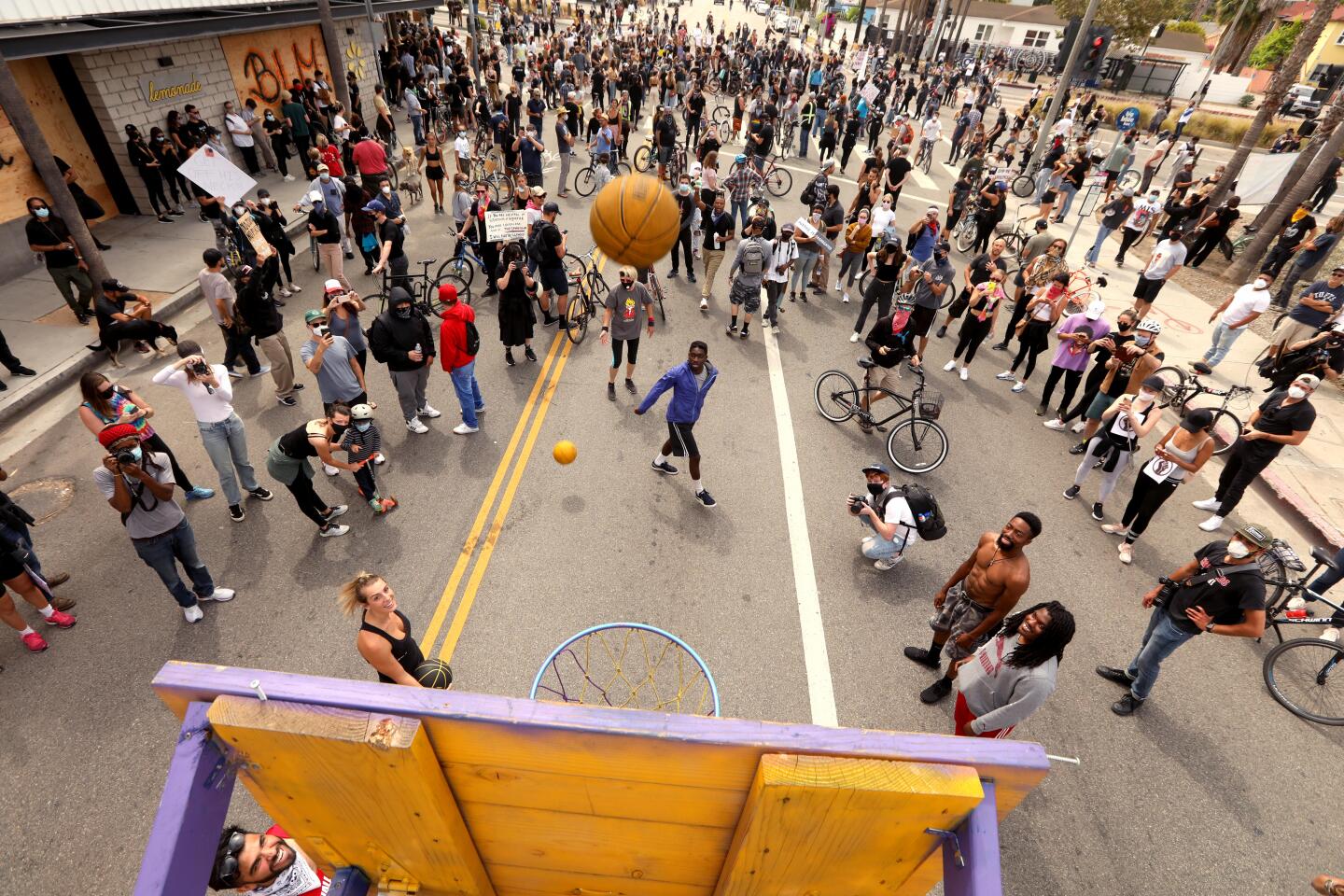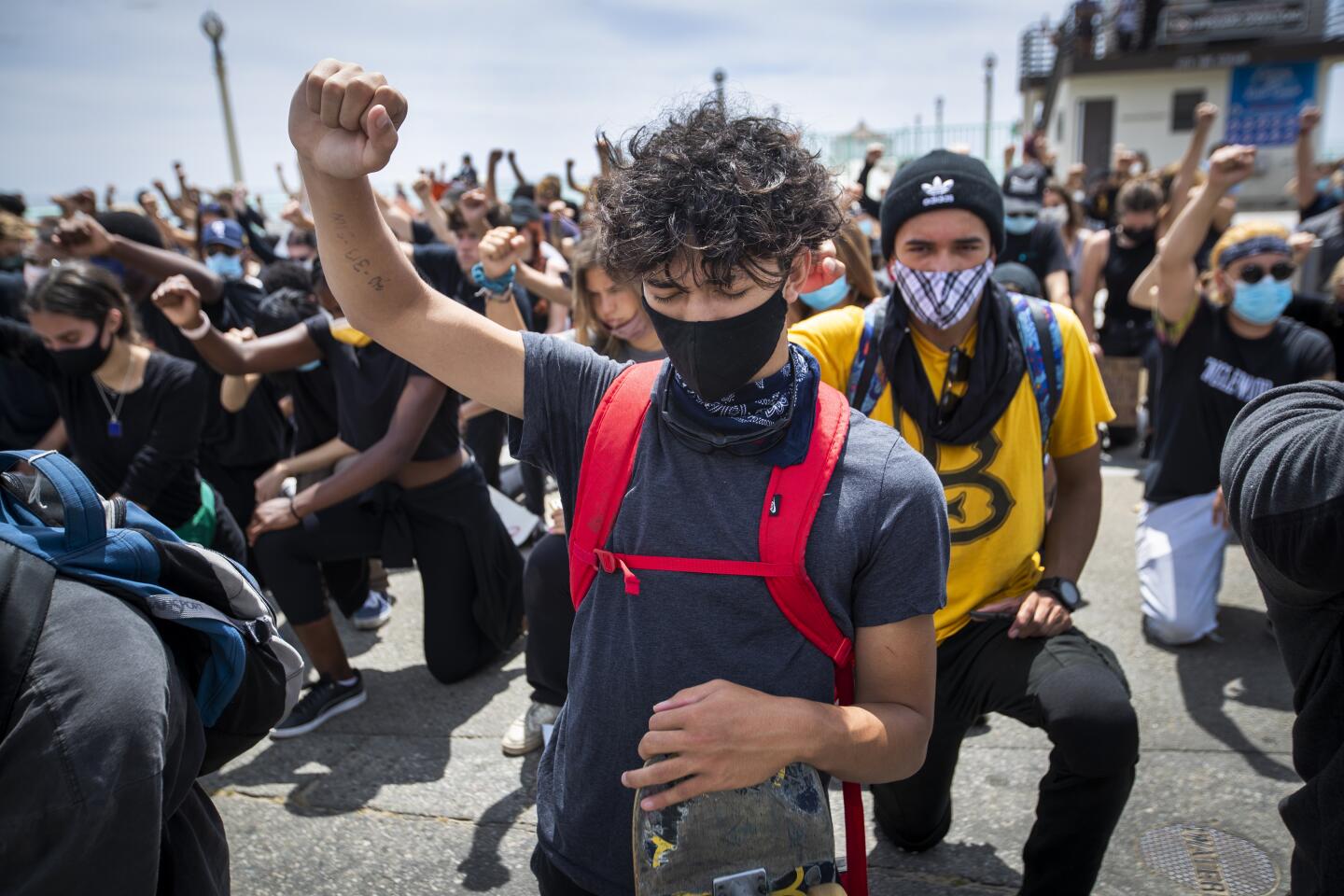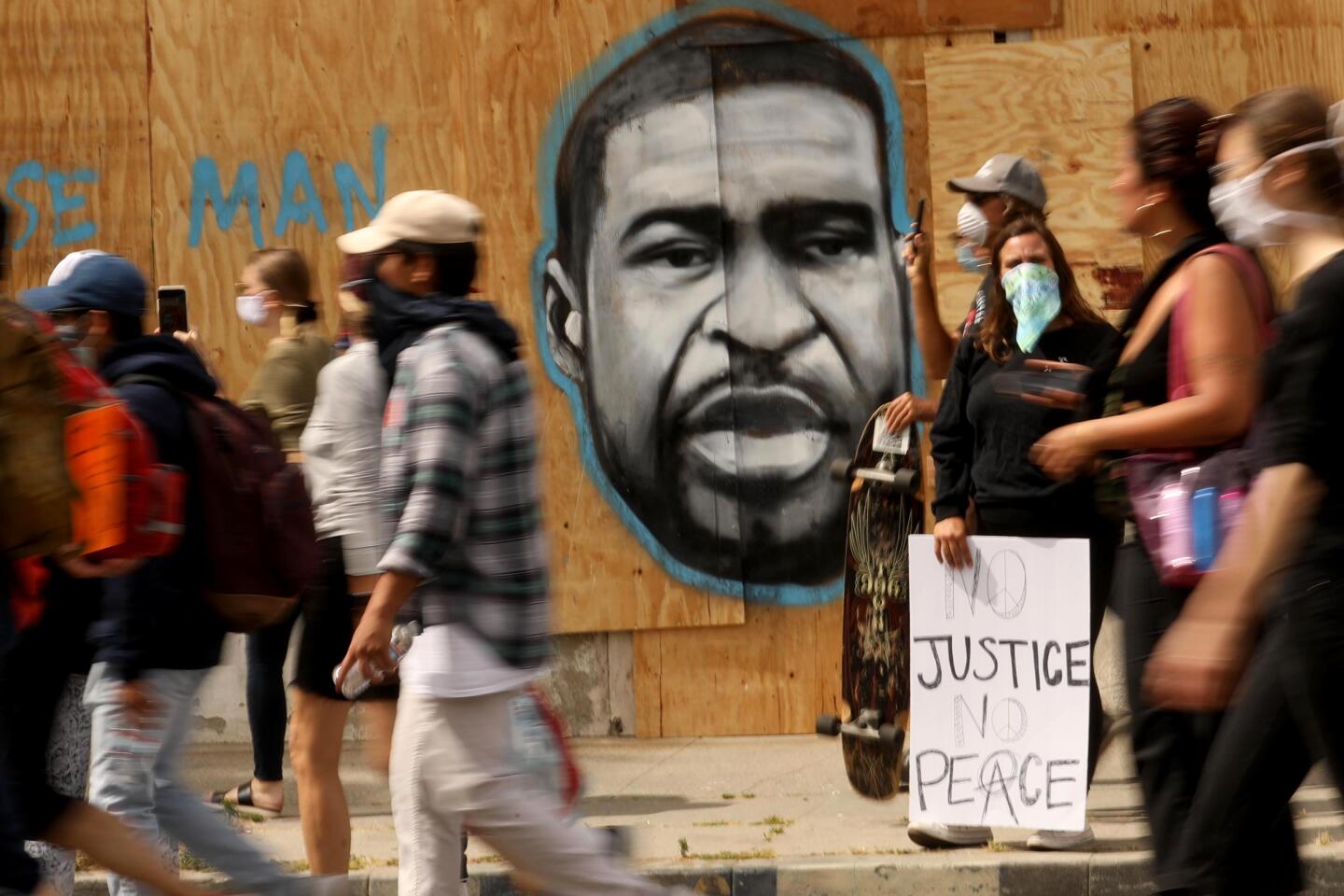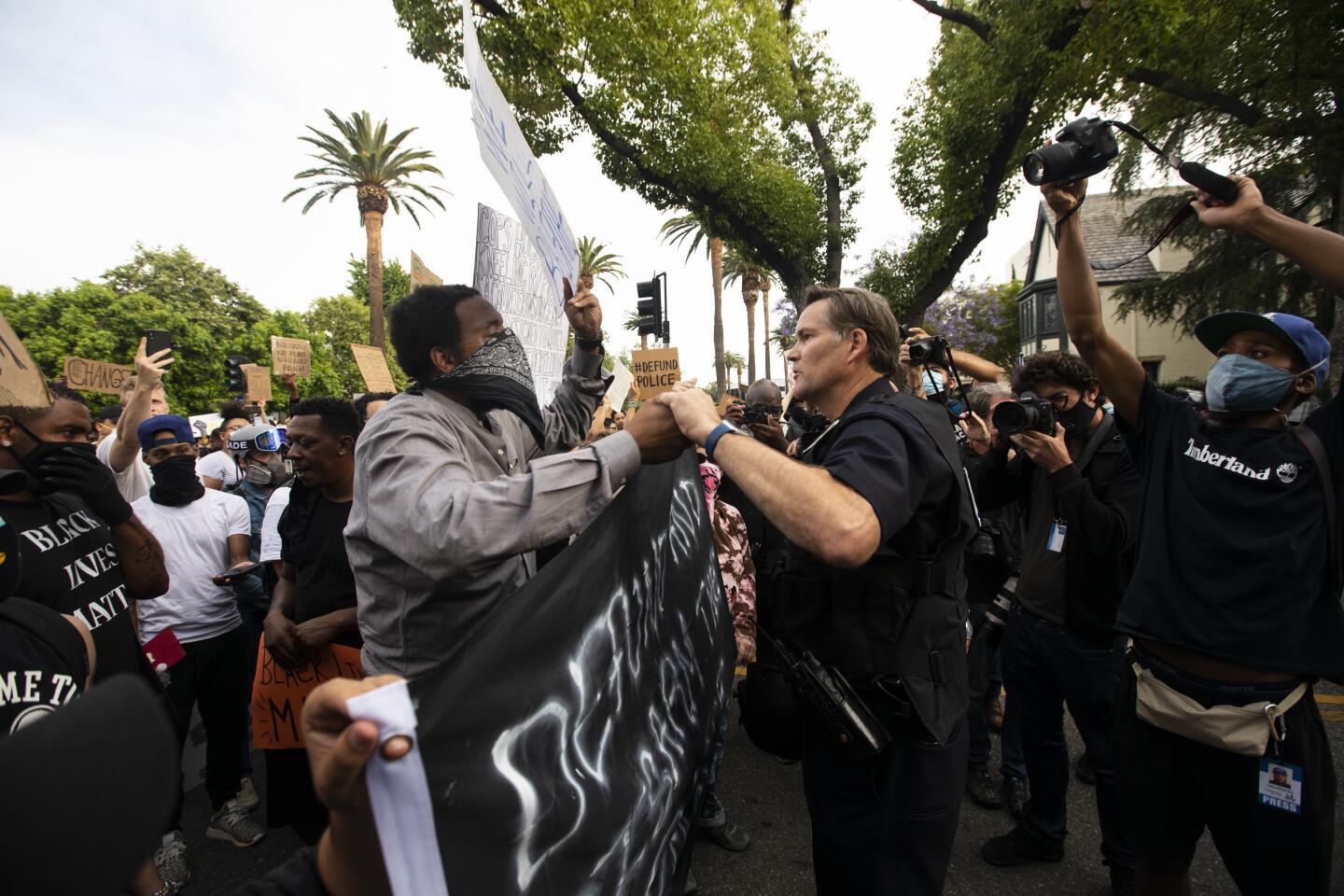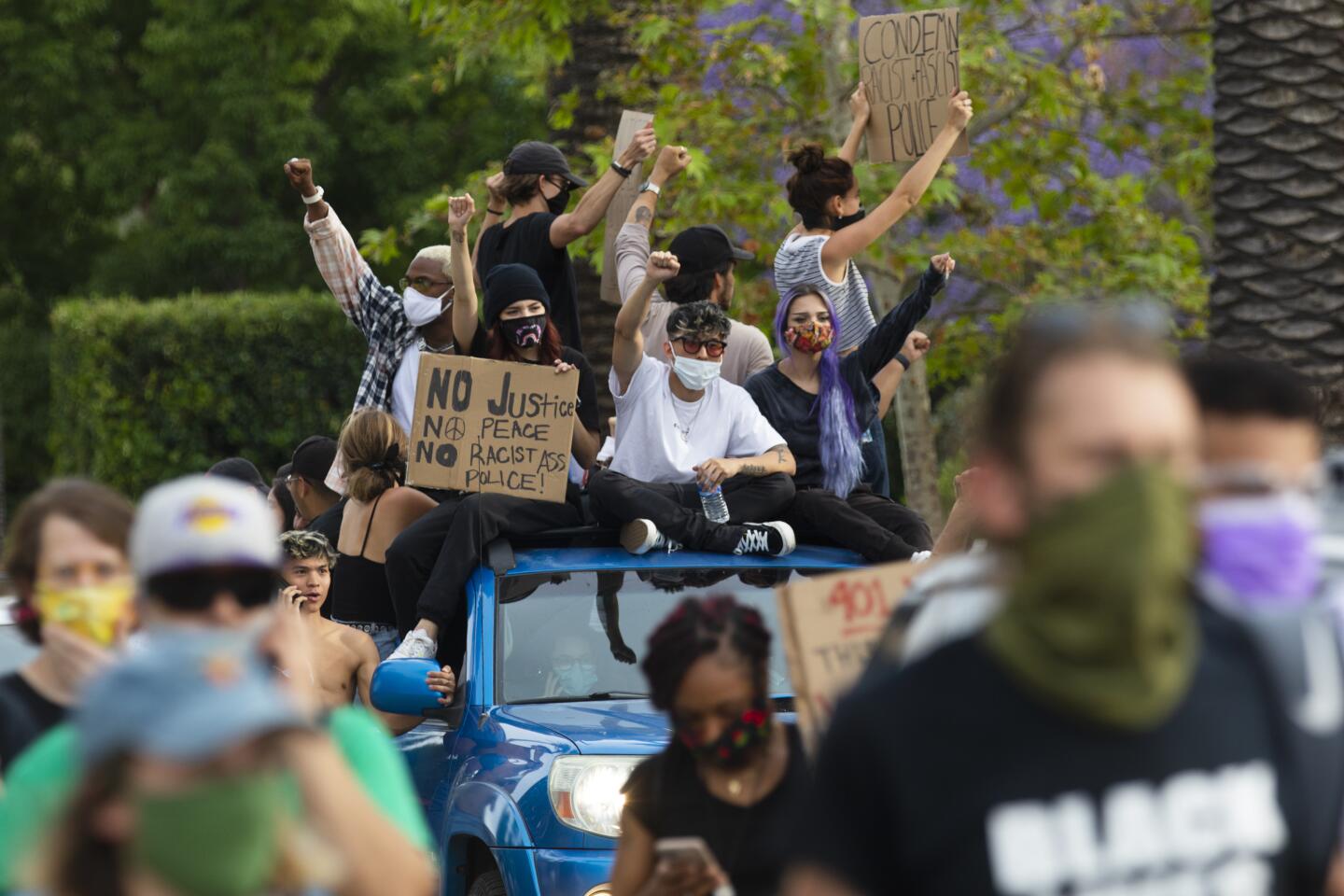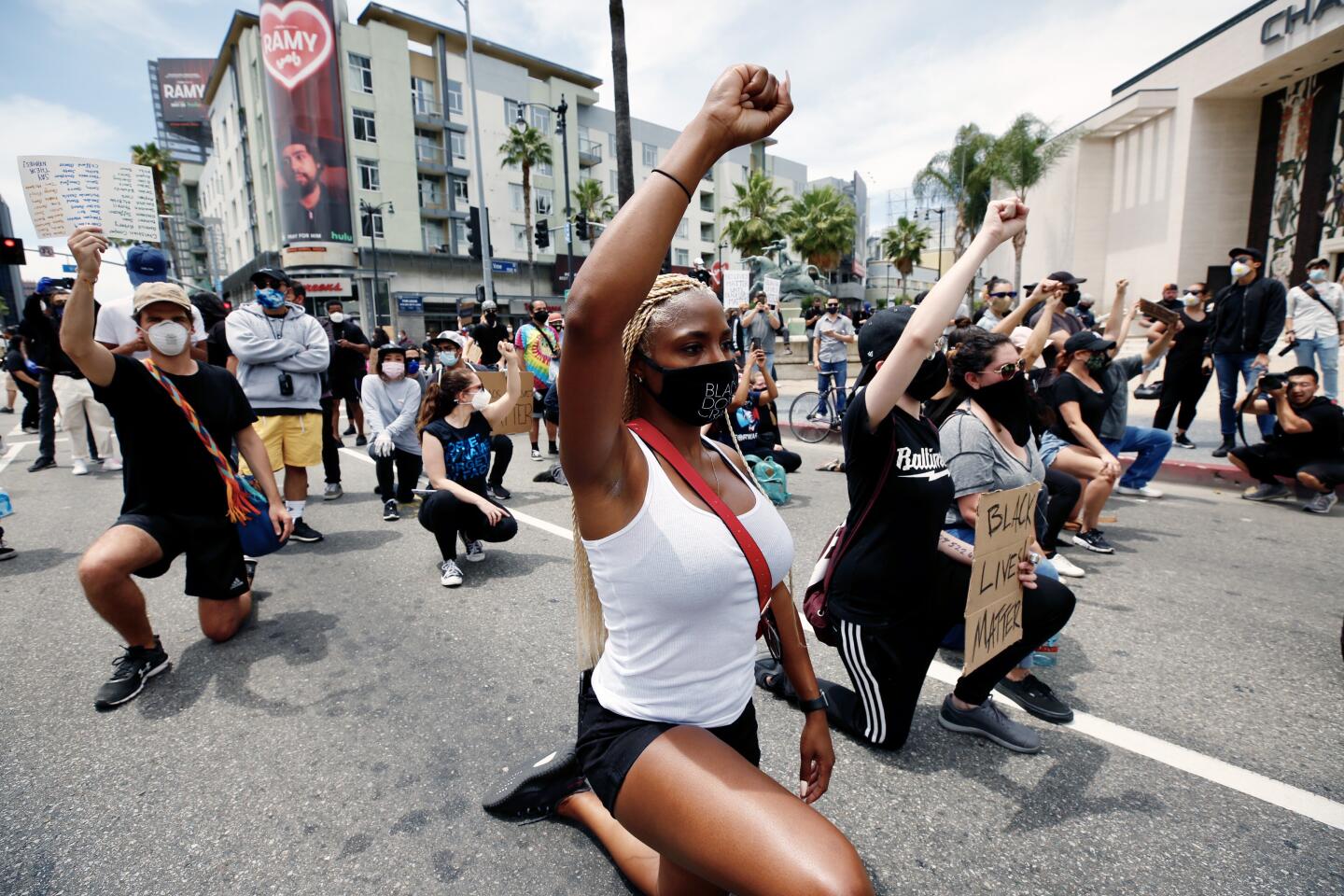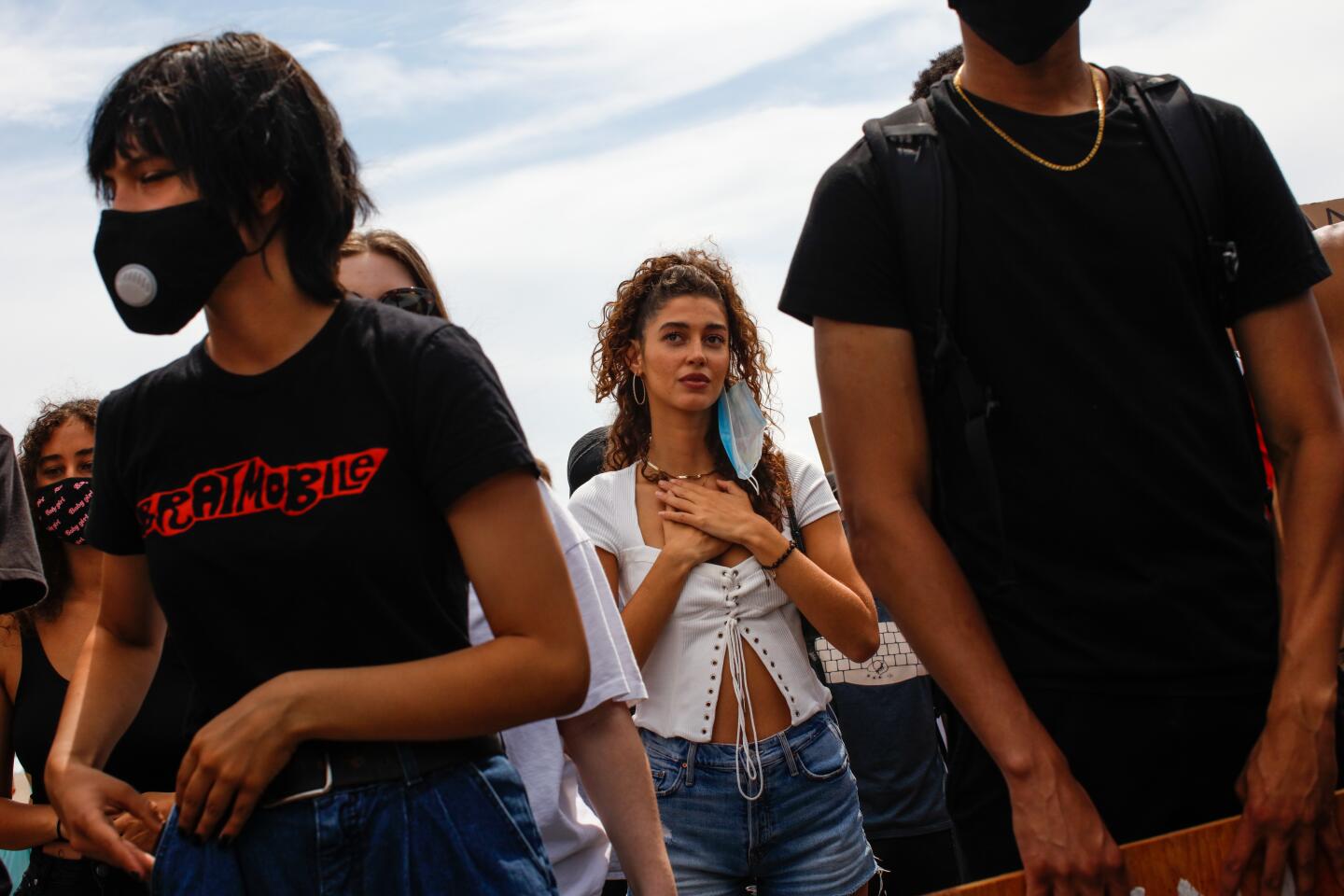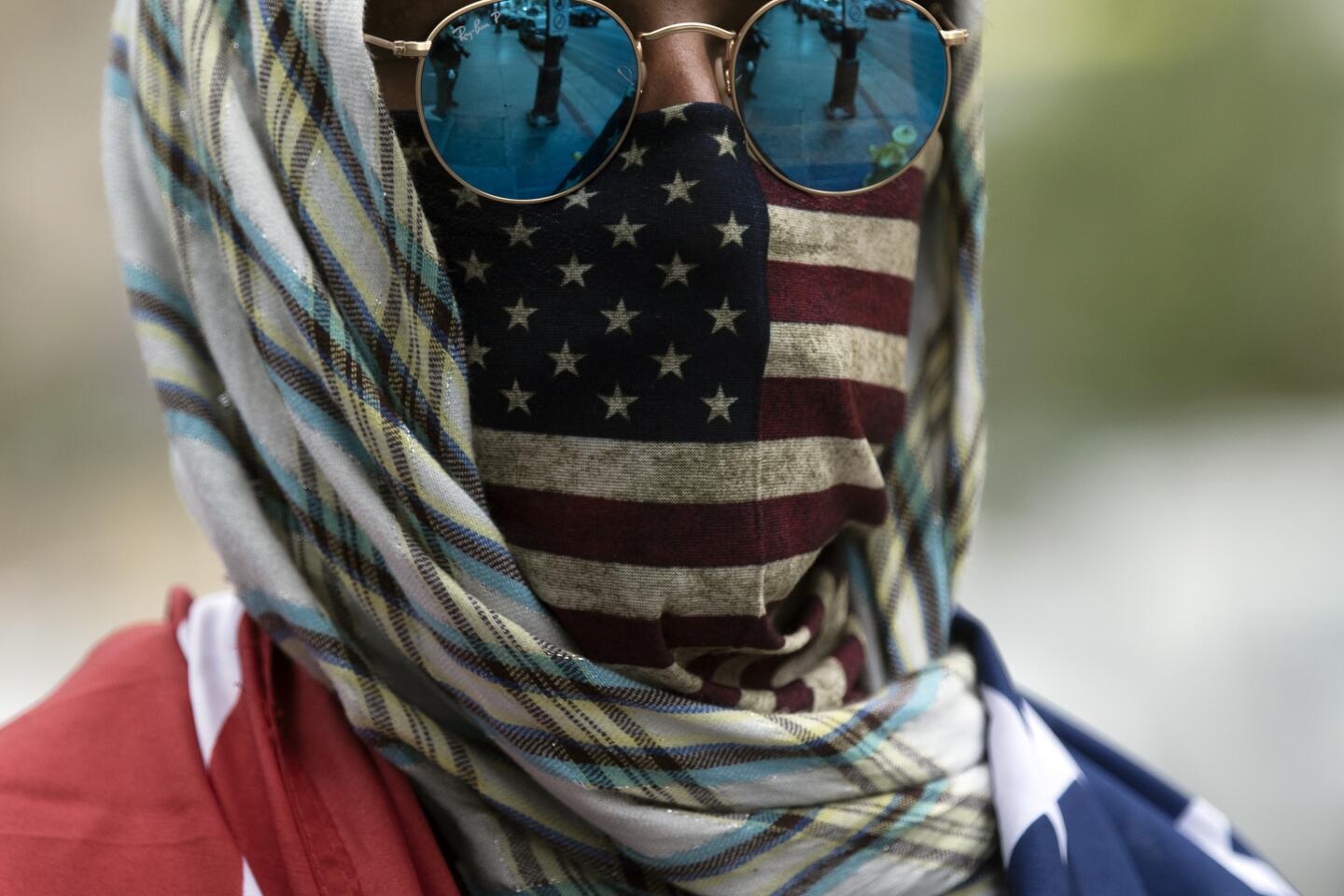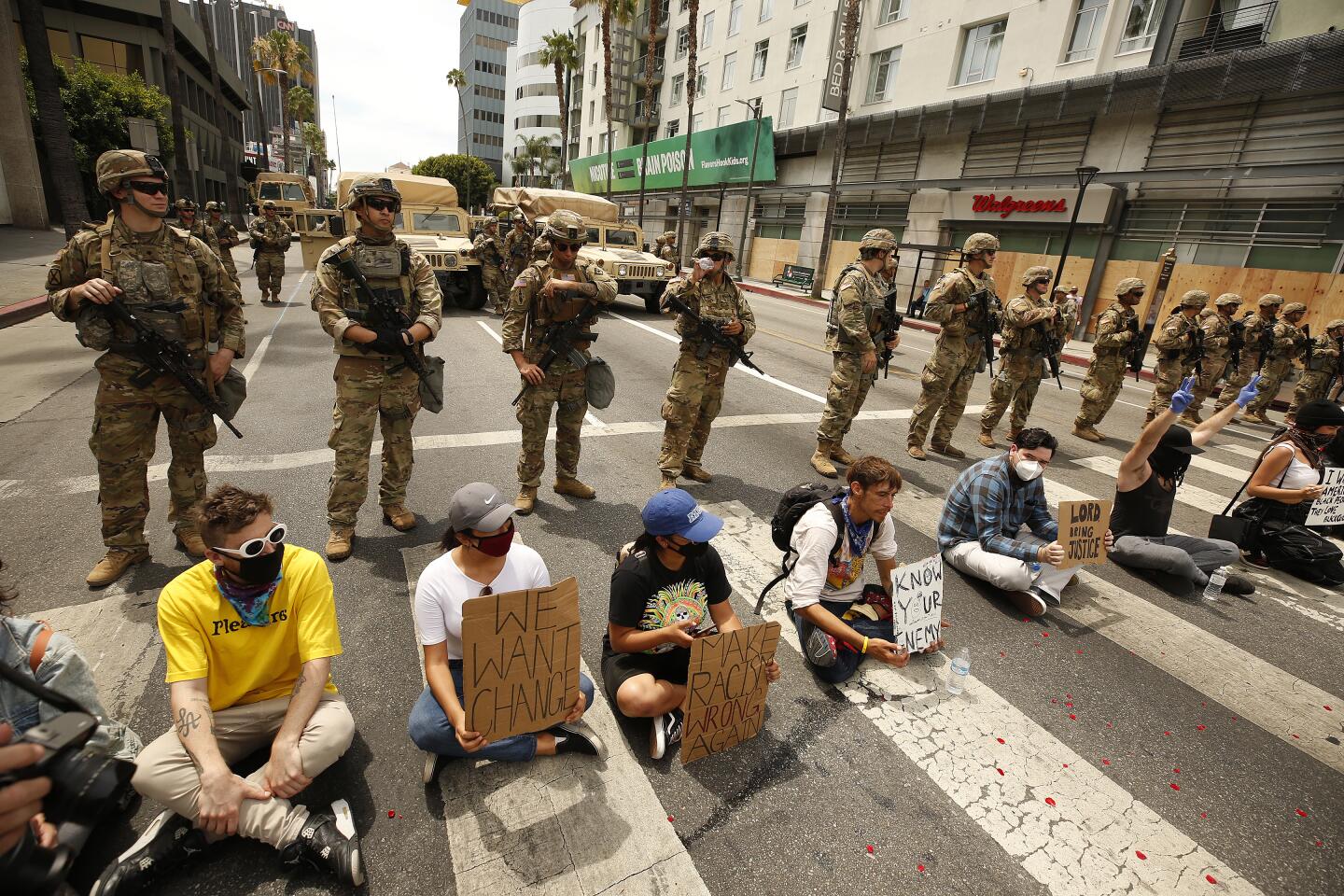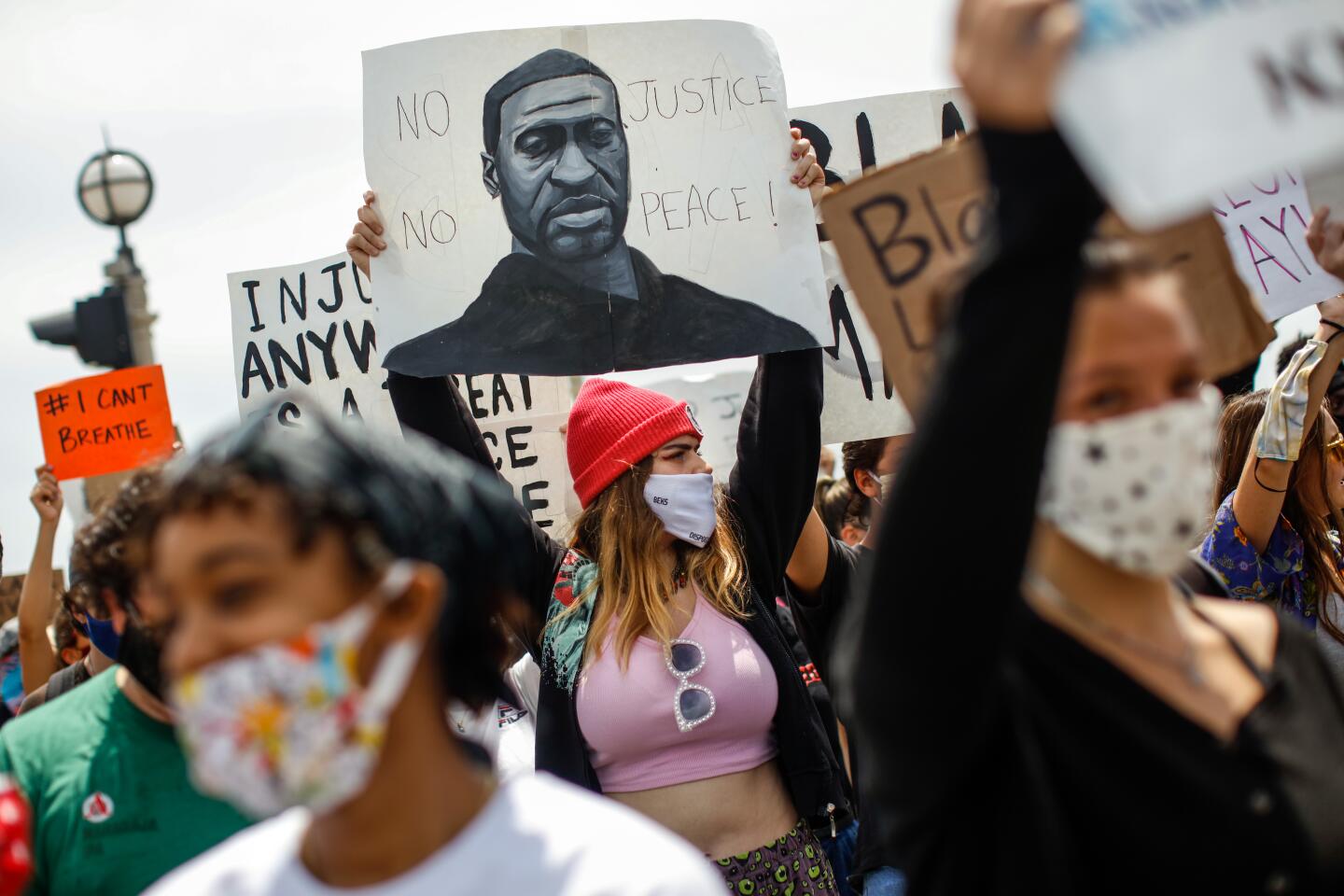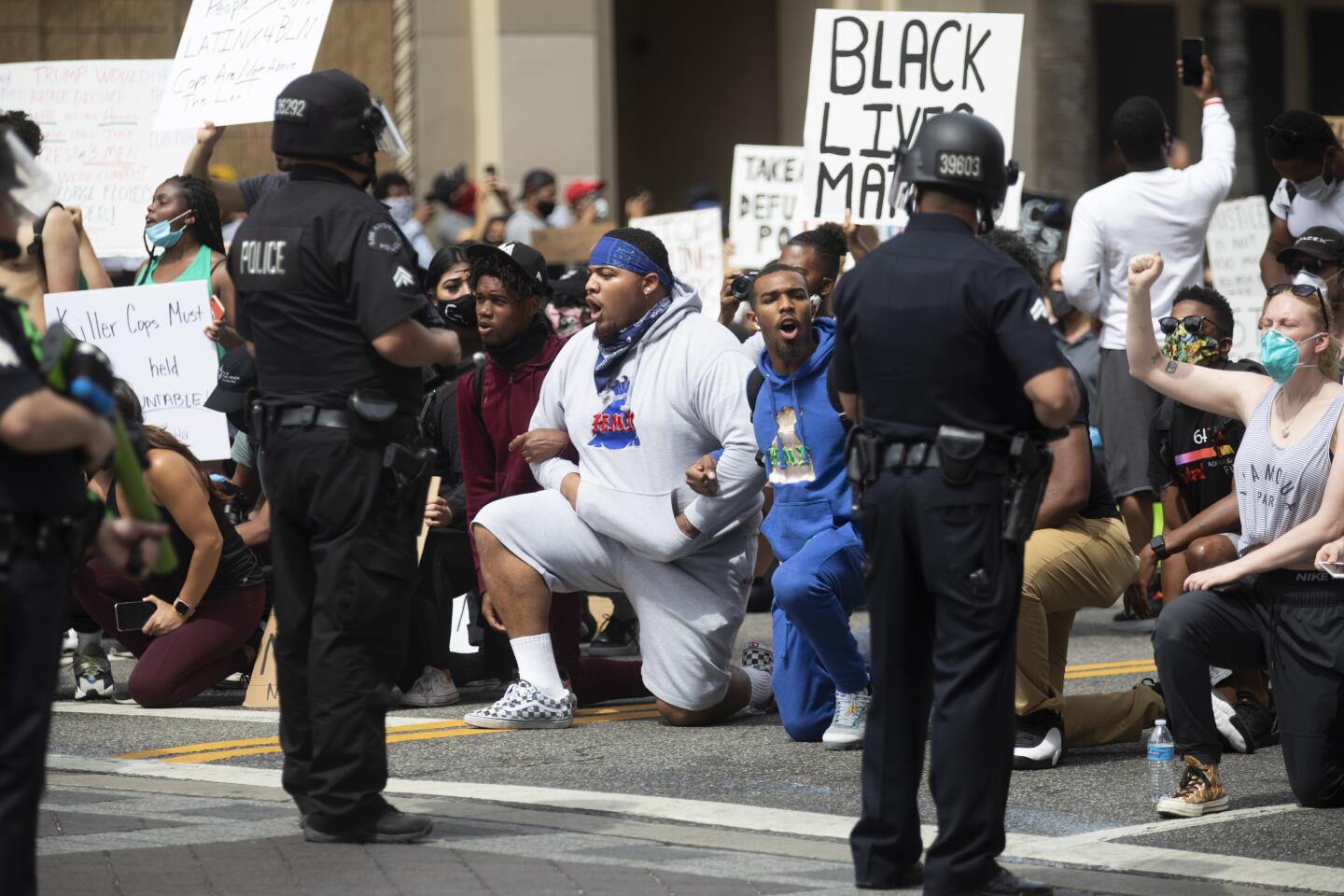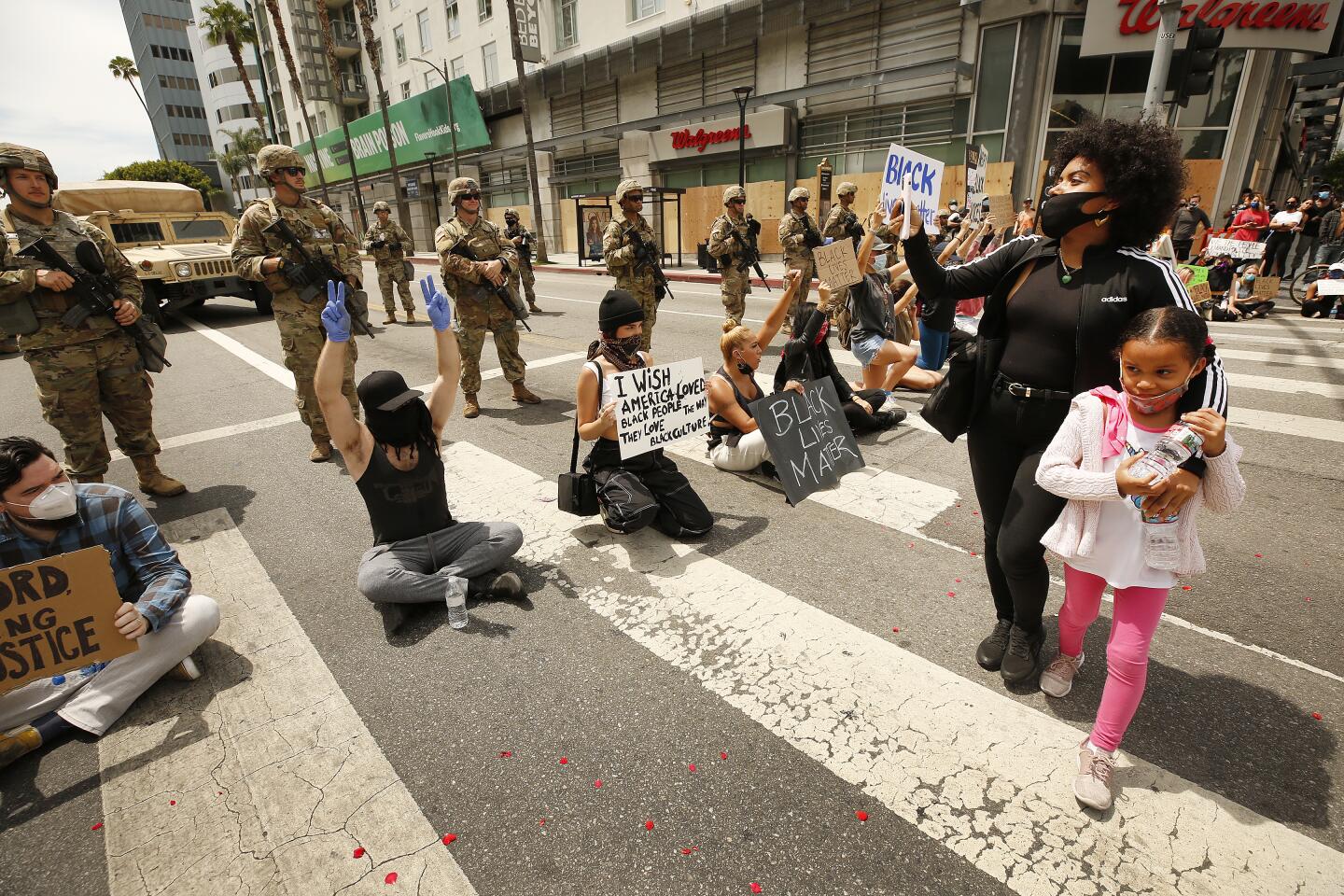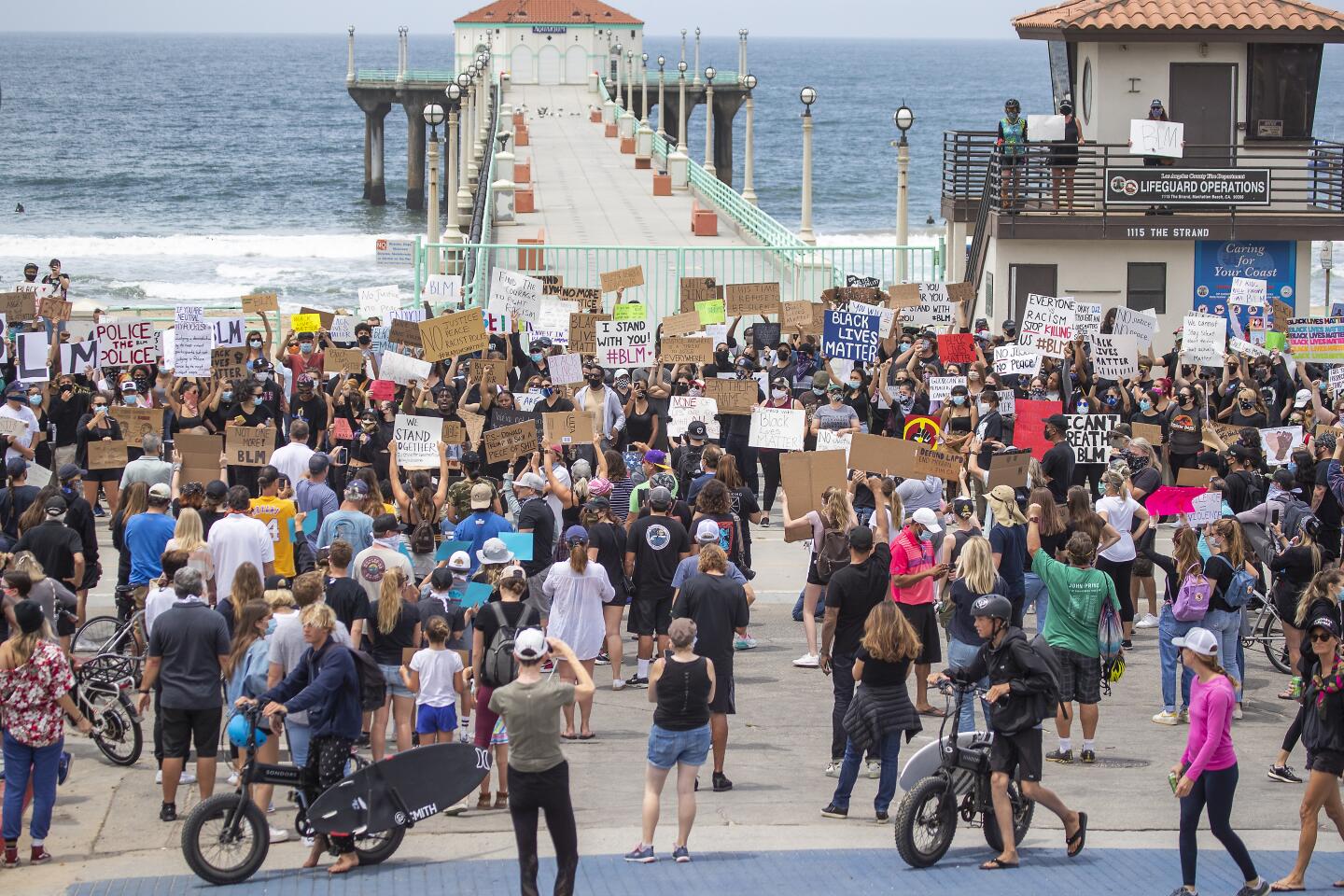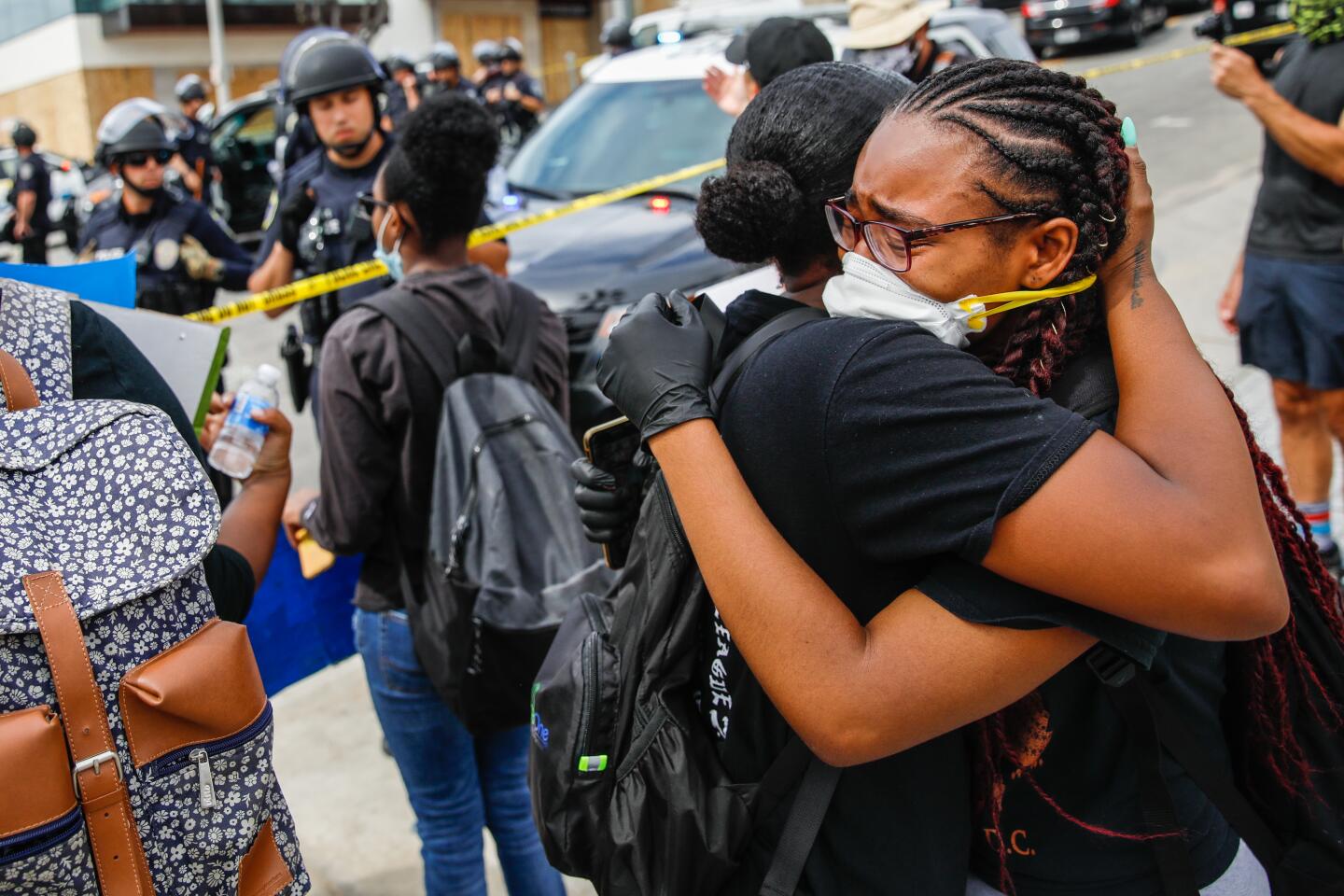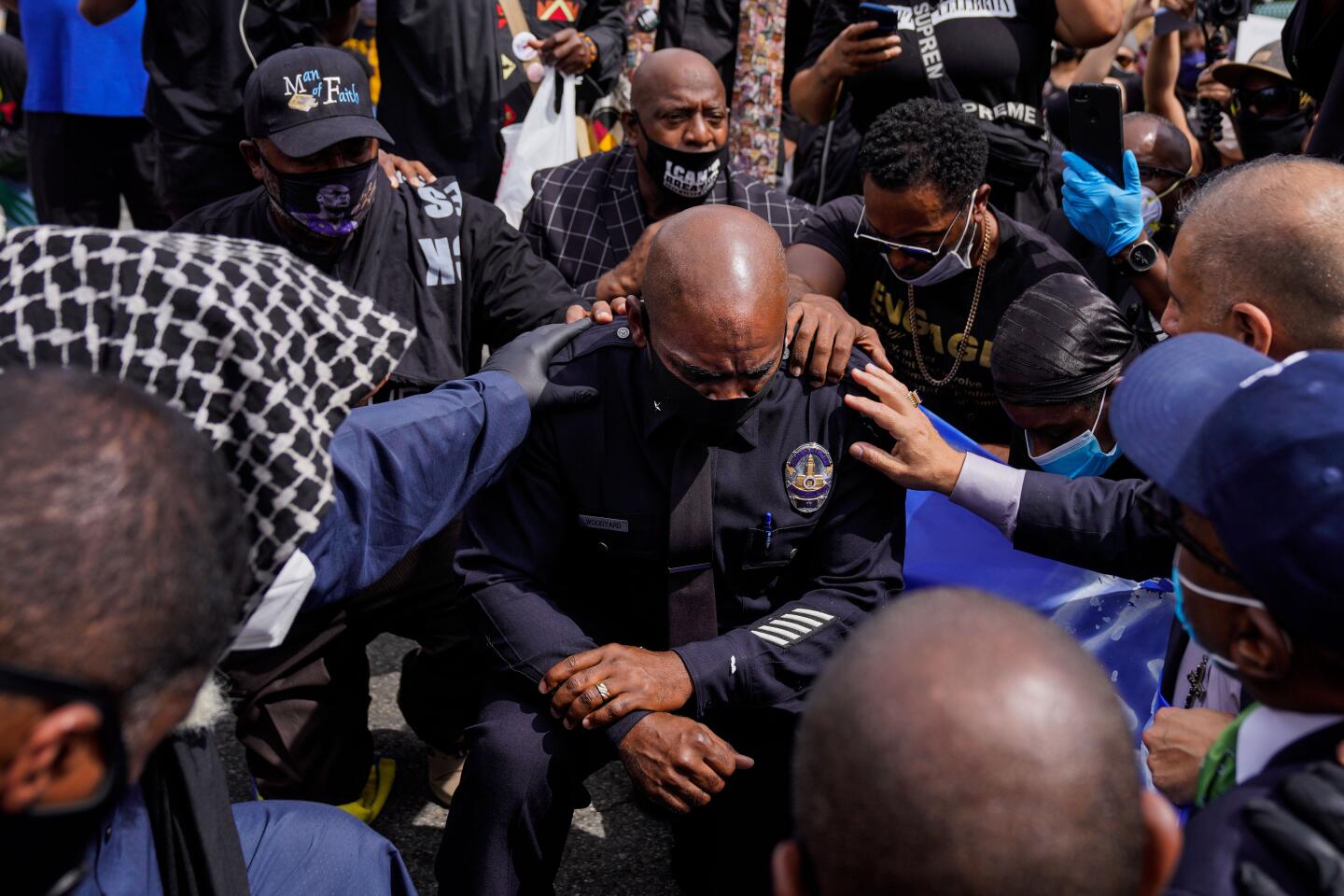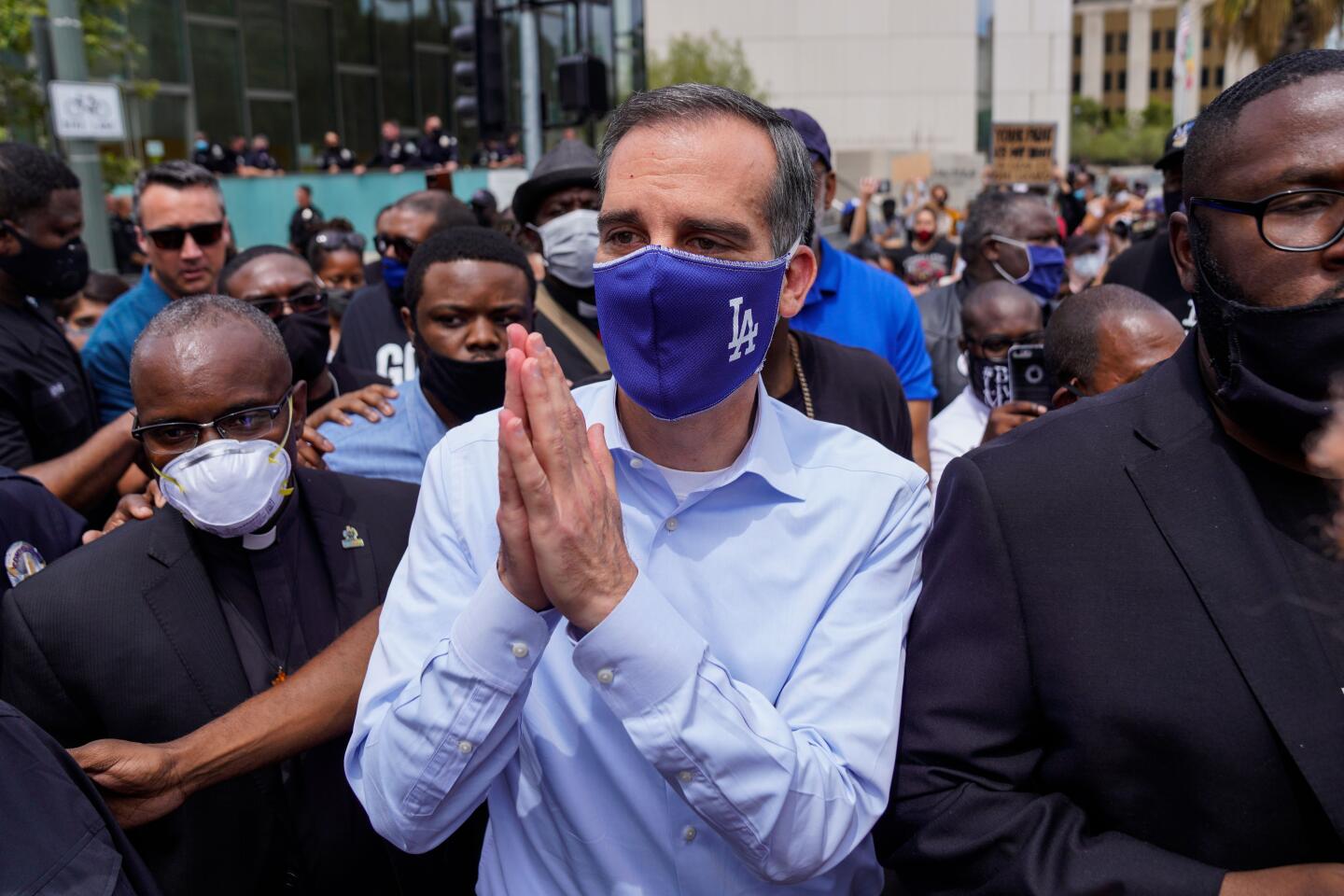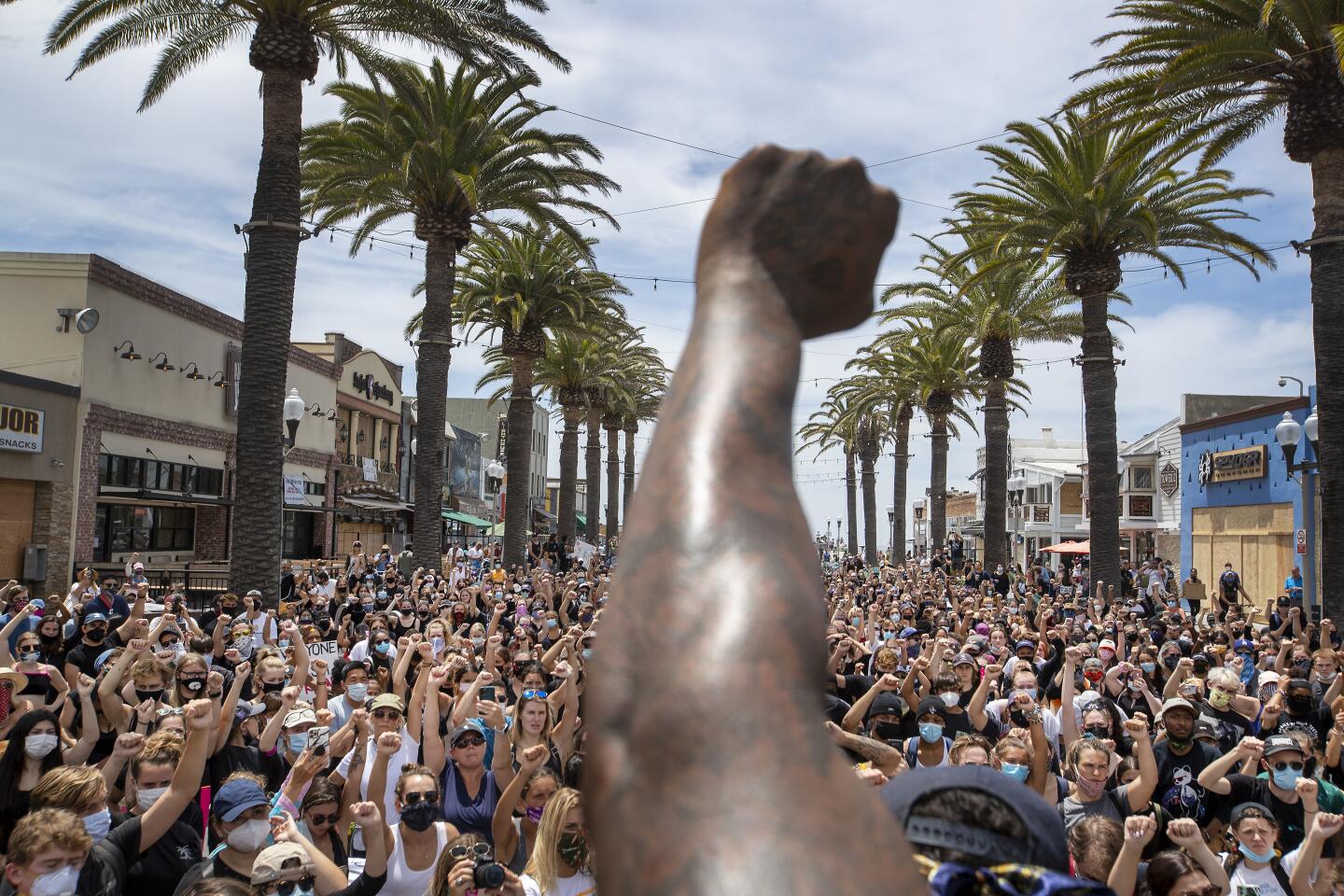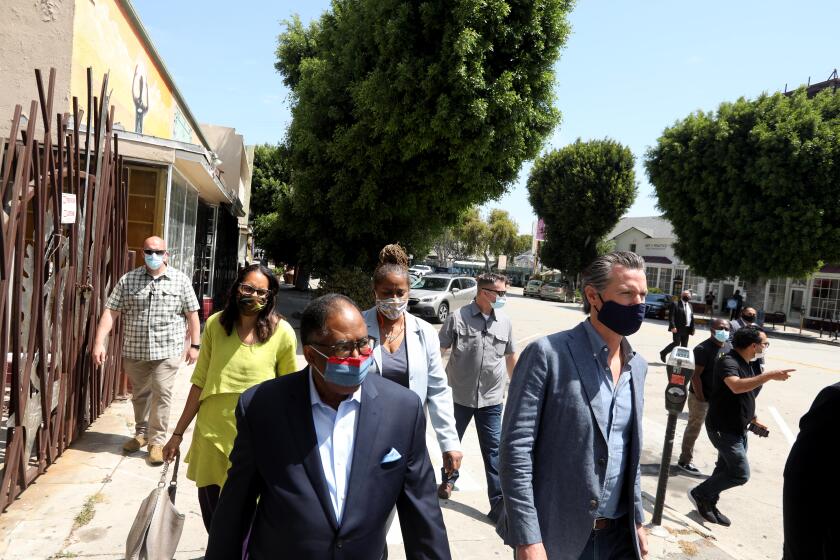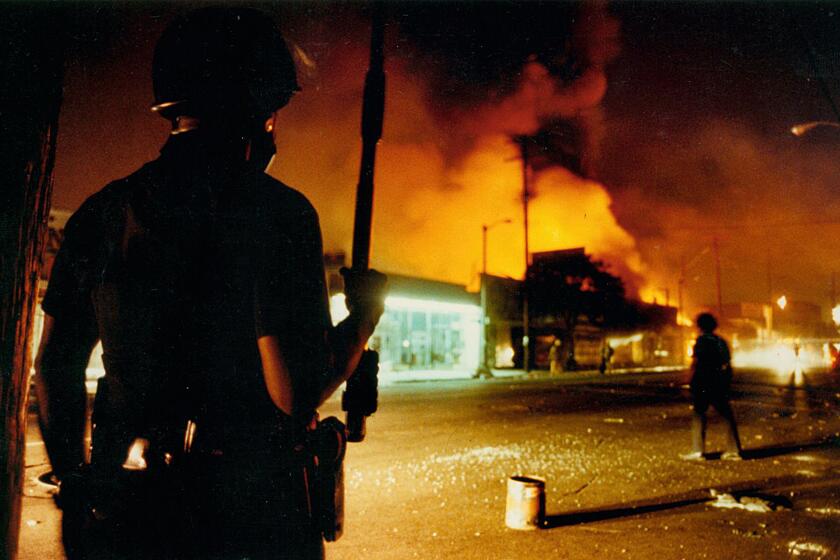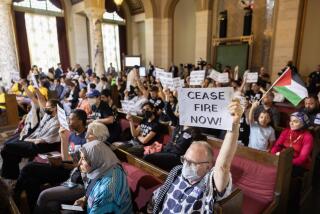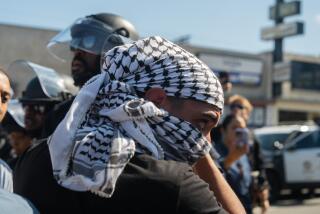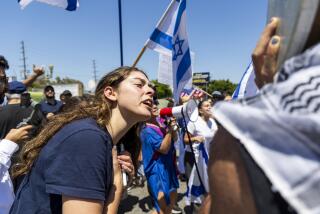Amid peaceful protests, LAPD’s vigil is drowned out by demonstrators chanting ‘defund the police’
- Share via
Amid protests against police brutality sparked by the death of George Floyd, Los Angeles Police Chief Michel Moore’s “community solidarity” vigil Friday evening at LAPD headquarters was met by a large crowd demanding reforms to end police violence and racism against black Americans.
Hundreds of peaceful demonstrators marched from the steps of City Hall a block away, waving signs, playing drums and chanting outside the heavily guarded LAPD building.
The protesters’ chants of “no justice, no peace” and “defund the police” rose above the small and subdued gathering of police officers, faith leaders and others who had gathered behind metal barricades and in front of the building’s main entrance.
“We’re here because we want police reform,” Morris Griffin of Inglewood told the crowd at the steps of City Hall before the protest moved over to LAPD headquarters. “We’re sick and tired of seeing these atrocities happening to black people.”
The protesters arrived as Moore, who recently came under fire for comments he made about looters, spoke for about four minutes next to a portrait of Floyd, whose killing in Minneapolis more than a week ago was the impetus for nationwide protests.
“In the days after that event, after that murder, after that tragedy, after watching the horrific scene and hearing his pleas, and the lack of compassion and humanity of just simply recognizing another individual, tore at the very heart of what policing stands for,” Moore said. “Tore at the very essence of our duty to protect, to serve, to treat each individual as just that.”
Moore said Floyd’s death “served as a reawakening” about state violence, racism and inequality and committed “to join the entire world in an effort to find justice for all.”
He had invited community members to join him at the vigil, which was organized by police and described as being “in support of community solidarity, open minds, open hearts, responsible dialogue, social healing.”
After the hourlong vigil, Moore spent about 20 minutes speaking to protesters across a metal barricade. He turned back toward headquarters after people in the crowd raised their voices and loudly criticized him and his department for using force against peaceful demonstrators. Some held up cellphone videos of attacks by LAPD officers on protesters in recent days and demanded answers as to why the officers had struck those people with batons and used pepper spray.
Speaking to reporters afterward, Moore said it was important to have conversations with critics but did not address the protesters’ demands, instead praising police officers “who have been out there for days and weeks doing important and critical work to provide for the safety throughout Los Angeles.”
“Tonight was about them seeing the whole of community ... stand behind them and believe in them,” Moore said. “Not make them saints, not make them perfect. But to help renew that they play a critical role as peacekeepers.”
Days after Los Angeles Mayor Eric Garcetti said he supported budget cuts for the LAPD, he introduced the executive director of the city’s recently created Department of Civil and Human Rights on Friday during a news conference.
Capri Maddox, an attorney and former president of the Los Angeles Board of Public Works, will lead an office tasked with enforcing the city’s civil and human rights ordinance and investigating claims of discrimination and unequal treatment in housing, employment, education and commerce. She was appointed to the post in February.
“We do know one thing: Unfortunately, your skin color speaks before you do in America, and this is something we need to get beyond,” Maddox said, pointing out that she has had “the talk” with her teenage son about relations with police because he is black. “This isn’t easy work, but there’s nothing more important. And I’ll appreciate the support of people calling me and telling me they want to serve, and we’re here to serve with you.”
Describing racism as an “old enemy” and as a virus, Garcetti urged Angelenos to look within themselves for change, not just at others. “We must not find the enemies amongst us; we must find the enemies within us ... We are all silent spreaders.”
He also took a moment to criticize episodes of excessive force by police that have been captured on video during protests in recent weeks. However, he defended the positive contributions that individual officers and law enforcement investigations have made, such as breaking up human trafficking rings.
Both Garcetti’s and Maddox‘s comments came at the end of a day when thousands of demonstrators gathered on streets and in front of municipal buildings across Southern California.
Hundreds of people protested on the beach in Venice, marched through the streets of downtown Los Angeles and Northridge, while doctors and nurses who have been on the front lines of the coronavirus outbreak stepped out of their facilities in Culver City and elsewhere to hold up signs of support and observe a moment of silence in honor of Floyd.
Several more demonstrations are planned throughout the weekend.
On Friday, video footage showed some 300 people gathering on the beach under cloudy skies, then walking north toward Santa Monica in what was billed as a “pier to pier” protest.
By the afternoon, demonstrations were getting underway in downtown Los Angeles and Long Beach.
Madison Garrett, a 21-year-old college student, arrived early for a protest at Santa Monica City Hall, her third demonstration this week. A post circulating on social media said the event was organized by alumni of Santa Monica High School, where she graduated in 2017.
Garrett said the recent protests have shown people doing what they need to do to be heard.
“Basically we’ve been going through this for hundreds of years, systematic oppression, and once it gets to a boiling point of being unheard, silence doesn’t work anymore,” she said.
She criticized media coverage that she said has focused on rioting and looting. “They’re not showing the police gassing innocent people,” she said. “They’re not showing you the singing and dancing on the street.”
Organizers of the Leimert Park bicycle ride for George Floyd and for justice say police officers are welcome to attend if they ride bicycles and don’t show up in riot gear.
Garrett said there’s been a sense of camaraderie among protesters. She’s offered to give people rides home and has seen people passing out water and snacks.
It’s hard to stay socially distanced at a protest, she said, noting that the coronavirus is still “definitely at the back of my mind.” But she’s trying to be safe — she was wearing a surgical mask with “I can’t breathe” written in black marker — and said protesting is worth breaking quarantine.
“I saw someone else say that you’re either going to get killed by a police officer or you’re going to get killed by COVID, and it’s your decision to make which one you choose,” she said.
In Manhattan Beach, more than 100 people showed up with balloons, cupcakes, flowers and signs to honor Breonna Taylor’s birthday.
Taylor, who would have been 27, was shot in March in her Louisville, Ky., apartment by a police officer.
“She was just getting started,” read one sign. “HBD BREONNA TAYLOR RIP,” read another.
Jasmine Gates, 24, organized the event at Bruce’s Beach — a hillside park that was once a haven for black people denied entry to Manhattan Beach — because she “saw that a lot of black women that I know were addressing that Breonna Taylor’s name wasn’t said, along with a lot of other black women.”
Gates said Taylor’s story was so heartbreaking because it could have been anyone in the audience.
“Society thinks that we’re so strong that even when we die, we’re supposed to have some sort of strength,” she said.
Meanwhile, public health officials on Friday touched on the health risks inherent to the mass demonstrations.
L.A. County Public Health Director Barbara Ferrer said risk of exposure exists in any large gathering, “whether on the boardwalk in Venice or joining a protest against racism.”
The county anticipates an increase in cases in the coming weeks because of the protests and the reopening of businesses and other aspects of public life.
Ferrer said that anyone who has been in a large crowd, in close contact for at least 15 minutes with people not wearing face coverings, should consider self-quarantining for at least two weeks to see if COVID-19 symptoms develop.
She said people should remember that the coronavirus “has a long incubation period” and that “if you do get tested right away after exposure, you’re likely to test negative” because the viral load could still be low.
“Testing negative does not mean you cannot become infected later in the incubation period,” Ferrer said, and it is still advised to stay away from others for 14 days.
Dr. Christina Ghaly, director of the L.A. County Department of Health Services, said it was “inspiring on many levels” to see the protests. She said the county did not issue a mandate to close COVID-19 testing facilities amid the demonstrations but allowed each site to make its own decision whether to close or adjust hours.
As a result, officials saw the volume of testing “decline slightly” over the last week because of closures and “a higher-than-usual no-show rate at sites across the county,” she said.
Some looters are pure opportunists. But others are frustrated about systemic racism, citing issues ranging from President Trump to the racial privilege exposed in the college admissions scandal.
Back in Santa Monica, the city’s mayor, Kevin McKeown, and interim City Manager Lane Dilg attempted to address protesters at City Hall, where they were met with questions about tear gas used on protesters in the city Sunday and calls to cut the police budget.
“We will look at the actions of Sunday; we will determine what we can do to keep our community safe and facilitate peaceful protest,” Dilg said.
“You called in the National Guard!” one protester shouted. Another asked why the streets were shut down.
“Hey, people, do you want to hear the answers?” McKeown asked.
A passerby, Chanel Nicole Miller, 19, took on the role of emcee during the exchange. She said she was on her way to work as a line cook when she stopped by the demonstration. She said she stepped forward when she heard officials talking.
“When the mayor got up there and started cursing, getting red, yelling, showing his ignorance and pain that he didn’t know how to express, I felt like I had to say something,” she said.
Miller stood up and described her experience as a resident of the city and the discrimination she’s faced as a black woman. She said she felt as if the crowd wanted her to speak up. She criticized officials for failing to answer questions, or acknowledging that the city used excessive force against protesters on Sunday.
Police Chief Cynthia Renaud said the list of names of people who died at the hands of police don’t seem to end, but they stop in Santa Monica.
“I believe in the peace; I believe in the community I serve,” she said. Then she, the mayor and others took a knee in solidarity with the protesters.
The act was viewed with skepticism by some in the crowd.
In Los Angeles, demonstrators marched through downtown streets with what appeared to be a police escort, with motorcycle officers on both sides of the lead marchers slowly rolling along with them as car horns echoed off the buildings.
While Floyd’s death has fueled this wave of demonstrations — he died after Minneapolis police officer Derek Chauvin held him down by the neck with his knee for nearly nine minutes, even after he became unresponsive — his is not the only one that protesters can point to as motivation to call for change. Taylor was killed by Louisville police who stormed her home in the middle of the night on a “no-knock” warrant March 13, and it took the public release of video for authorities to arrest and charge the men who shot Ahmaud Arbery earlier this year in south Georgia.
Los Angeles County and city law enforcement also have storied histories of corruption and brutality, which at one point led to federal oversight. Only recently were police misconduct cases in California made available to the public, but examples of questionable practices against blacks and other minorities remain.
Amid the continued unrest, Gov. Gavin Newsom called for statewide guidelines governing law enforcement’s use of force to control crowds at protests. Currently, municipalities have varying rules when it comes to deploying methods such as tear gas, he said, resulting in unequal treatment of protesters across the state.
“It’s clear to me we need to standardize those approaches,” he said.
Newsom said he also planned to sign a law directing the California Commission on Peace Officer Standards and Training to immediately stop training law enforcement to perform carotid holds on suspects.
“That has no place any longer in 21st century practices,” he said.
Black Lives Matter organizers wanted to bring the rage over the George Floyd case and so many others to L.A.’s elites, in their own neighborhoods.
Garcetti called for police to minimize the use of rubber bullets earlier this week as a result of widespread criticism of police tactics and a host of videos locally and across the country showing officers firing them at nonthreatening demonstrators and journalists.
After days of aggressively enforced curfews, Los Angeles lifted them on Thursday.
With curfews lifted, Los Angeles and other Southern California cities saw largely peaceful protests Thursday night as demonstrations continued with few reports of any problems. Demonstrations on Friday popped up in Santa Clarita, Lakewood and in Orange County cities such as Irvine and Fountain Valley.
Police said they needed a curfew earlier this week in various cities and across Los Angeles County to control crowds and crack down on looting that occurred in a few spots, including downtown, Van Nuys, Hollywood, Long Beach, Santa Monica and the Fairfax district. But there have not been any major reports of stealing in several days.
L.A. County Supervisors are set to vote Tuesday on a bill to develop rules for protests, requiring social separation and other actions to protect demonstrators from COVID-19 which has infected more than 60,000 and killed more than 2,500 in the county.
The motion directs the Department of Public Health, in collaboration with the sheriff and all other local law enforcement agencies in the county, to immediately issue guidance on health and safety measures regarding issuing citations, transporting and detaining protesters, using face masks, deciding when to implement physical distancing and when to use tear gas.
Times staff writers Hannah Fry, Priscella Vega, Ben Oreskes and Matthew Ormseth, as well as City News Service, contributed to this report.
More to Read
Sign up for Essential California
The most important California stories and recommendations in your inbox every morning.
You may occasionally receive promotional content from the Los Angeles Times.
